The wildlife park Johannismühle is located close to Berlin. Animals like fallow and red deer, but also brown bears, lynxes and even Arctic wolves got a home in the wildlife park. Because of its proximity to Berlin, the wildlife park Johannismühle is a popular day trip destination among both adults and children. I have visited this wildlife park twice. In this blog entry I write more about my two visits in the wildlife park Johannismühle.
A walk through the wildlife park Johannismühle
Did you know that it's because of Disney that most Germans think that the "Hirsch" and the "Reh" belong to the same species? And that many people think that the "Reh" is the young or the female and the "Hirsch" the male?
Of course, "Hirsch" und "Reh" are not the same species! The German word "Hirsch" refers to the whole deer family (also known under the latin name Cervidae) and the roe deer (Capreolus capreolus) - in German "Reh" - and other deer like red deer (Cervus elaphus) belong to that family Cervidae.
On the following photographs is a red deer (on the left) and a roe deer (on the right, taken in the animal park Kunsterspring).
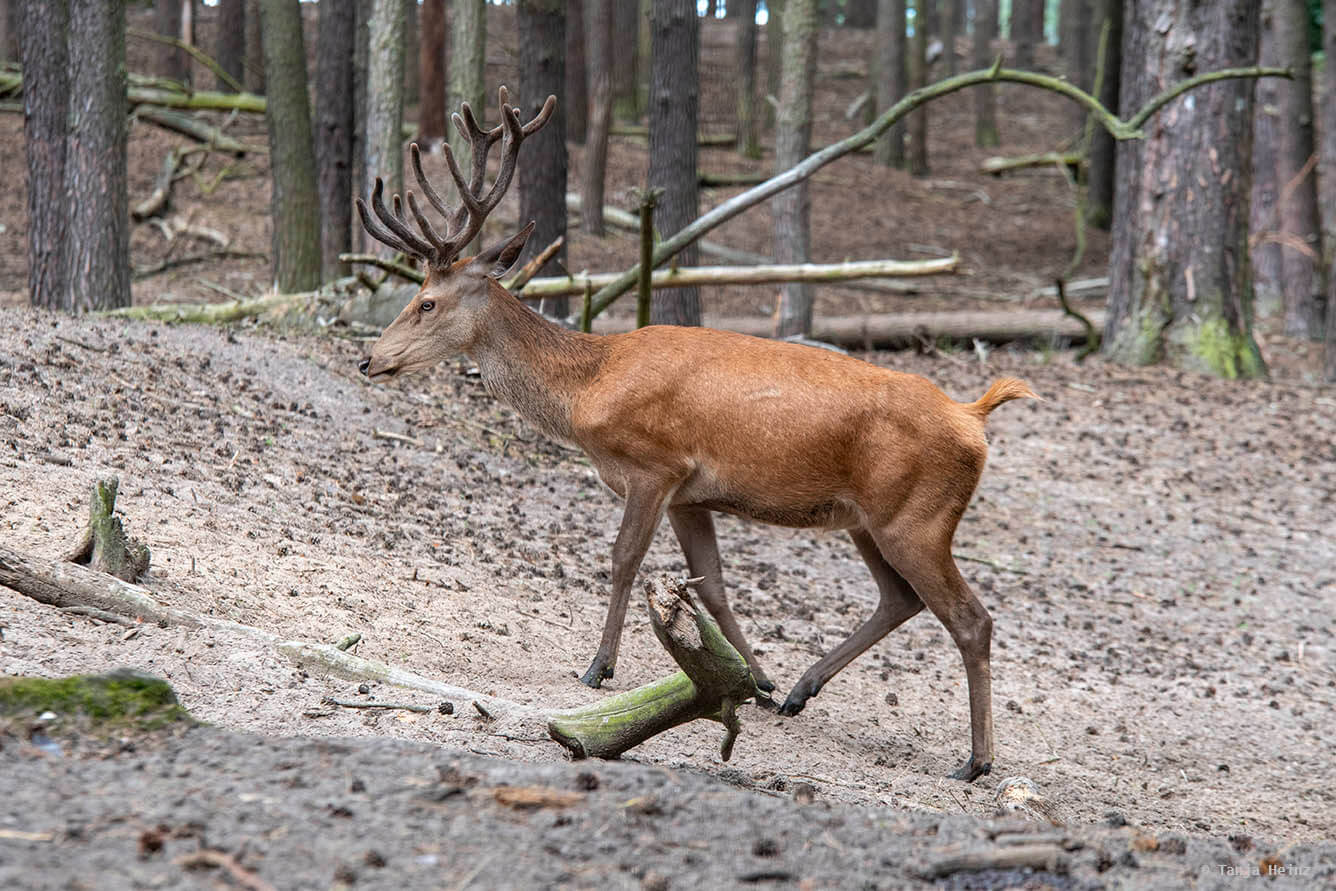
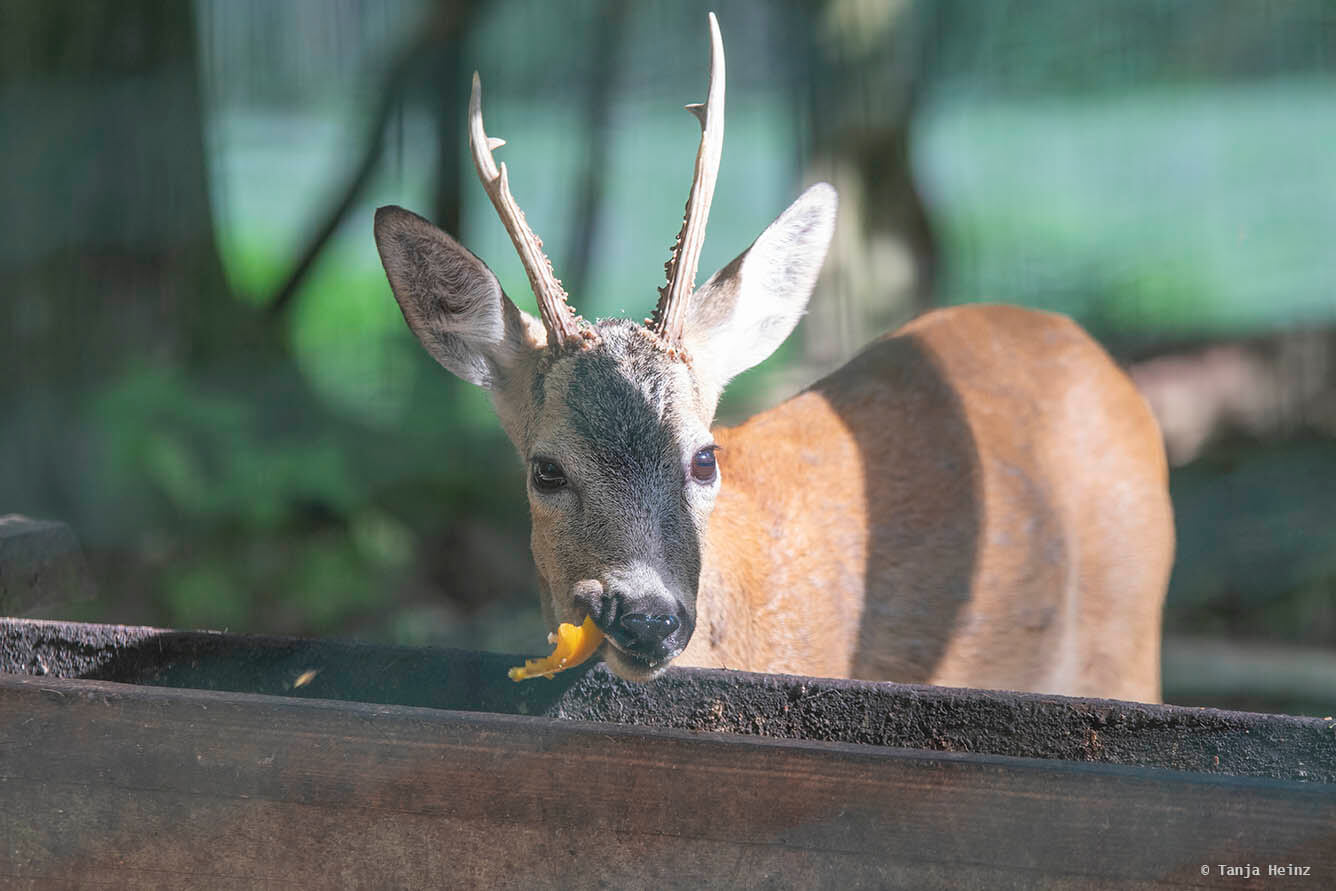
But why do Germans confuse these deer?
According to a radio broadcast on Deutschlandfunk Nova it is because of Disney. When Disney was filming the book "Bambi - A life in the woods" by Felix Salten, they transformed the roe deer (German: "Reh") into a white-tailed deer (white-tailed deer also belong to the Cervidae), because roe deer do not live in the Americas.
When they finally produced the German synchronisation, Bambi became a "Reh" (roe deer) again, although its father was still a "Hirsch" (a white-tailed deer).
Indeed. That is very confusing and I was not aware that Disney had such an influence on the people's ability to distinguish between deer species.
I actually think, however, that fallow deer (Dama dama dama) most resembles Bambi. In the wildlife park Johannismühle there are quite many of these fallow deer.
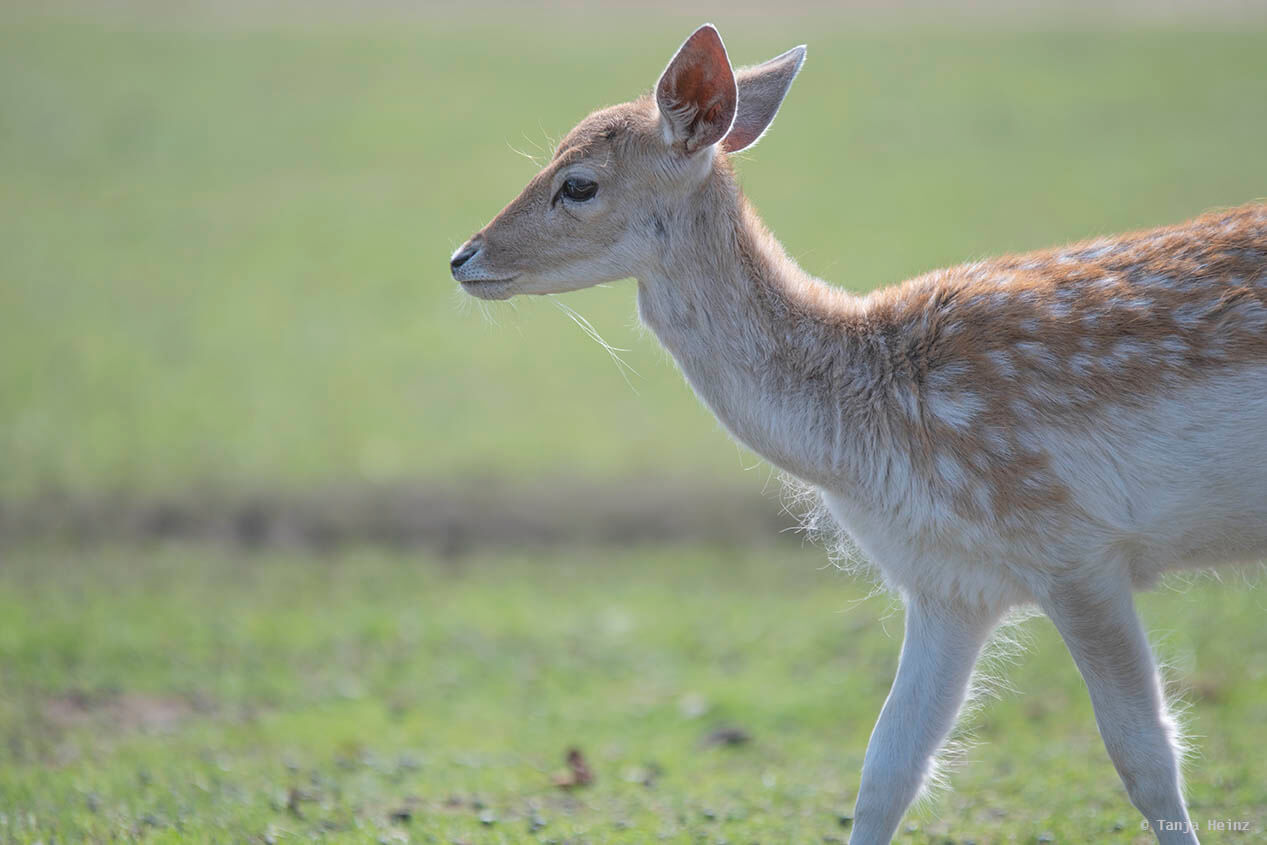
Interesting: Deer are distributed worldwide. They live in Europe, Asia and in the Americas - especially in South America. On my journey to Brazil, for example, I spotted a brown brocket (Mazama gouazoubira) in the Pantanal. There are even deer in the north of Africa. However, no deer lives further south of the Sahara.
Nevertheless, in the wildlife park Johannismühle there was little possibility of confusion among deer. An attentive visitor is able to detect the distinctive differences between the animals (more about that in the next paragraph). Furthermore, there are information signs in the wildlife park that inform the visitors about the animals in the wildlife park.
I visited the wildlife park Johannismühle on a beautiful and warm day in September. The temperature almost reached 30°C and there was no cloud anywhere in the sky.
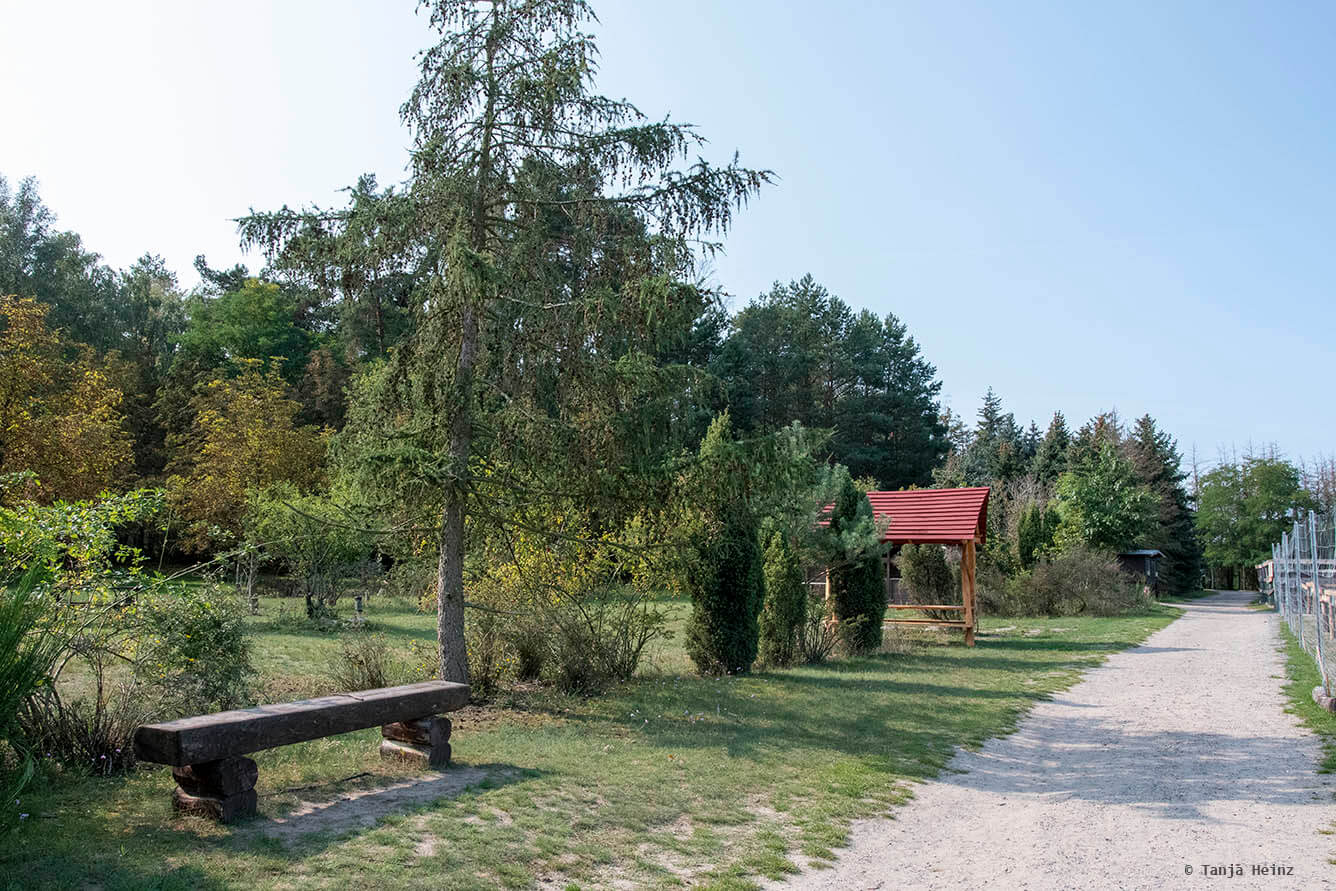
As I visited the wildlife park on a weekend, quite many families with their children were around in the wildlife park.
The wildlife park is located in a beautiful region. Just next to the park is a forest. But still the wildlife park Johannismühle can be easily reached by public transport.
There are furthermore several places to sit and have a picnic within the wildlife park.
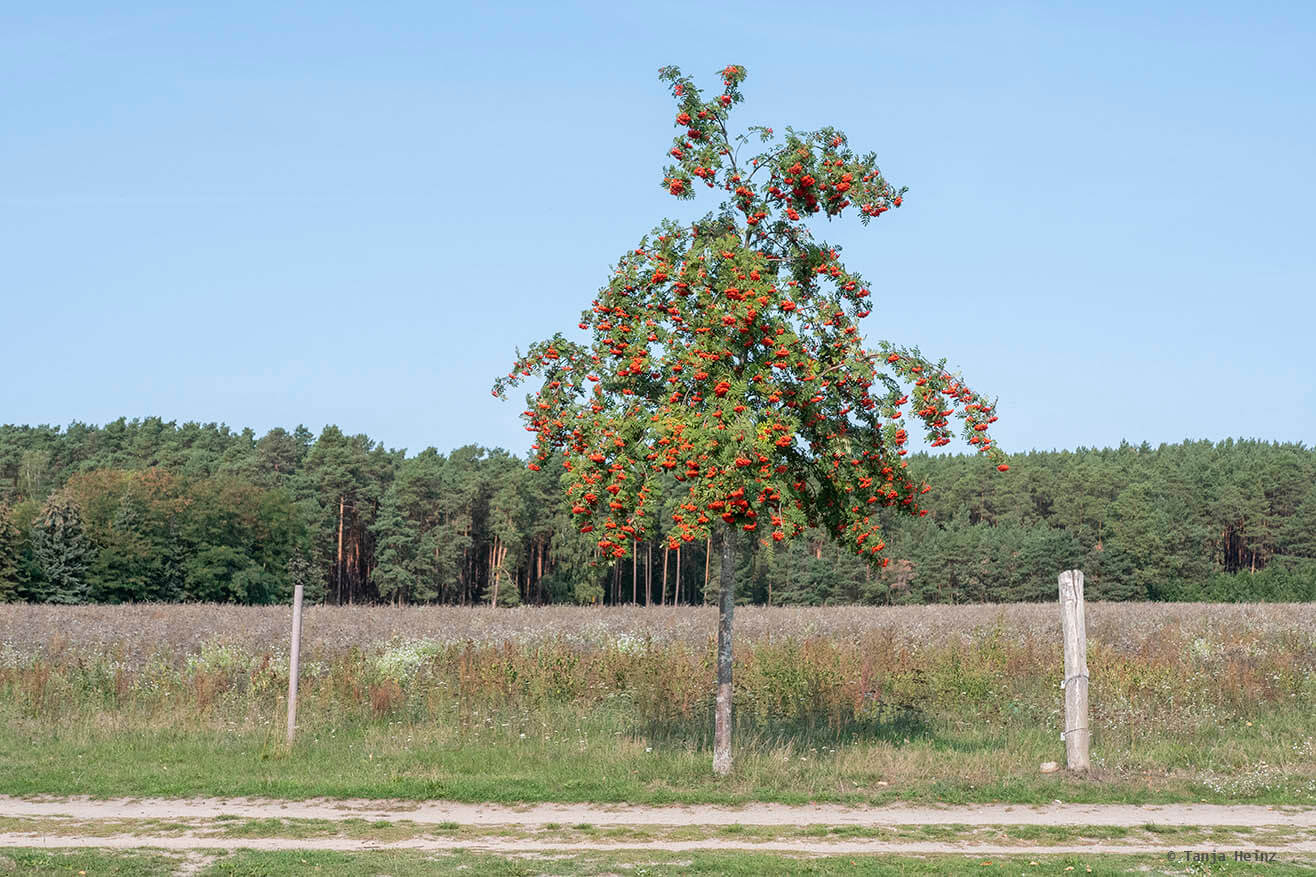
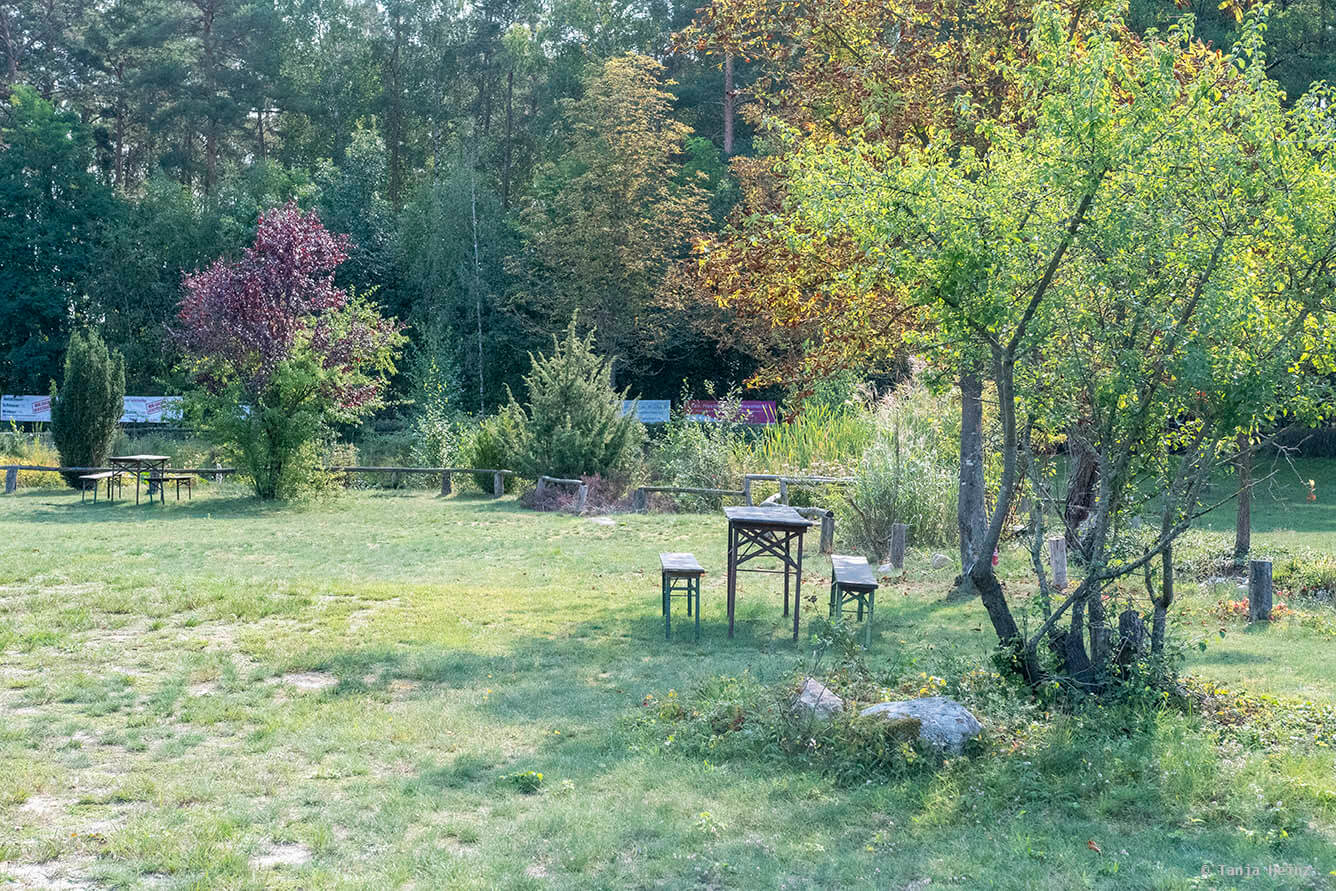
Information: If you are not up to a picnic, but you are hungry, there is a small snack bar at the entrance area. However, if you follow a plant-based diet, I rather recommend to bring your own food. Or another option would be to just eat later after the visit.
There is even an apartment to rent within the wildlife park Johannismühle. Especially interesting for those who want to wake up next to beautiful nature - including wildlife.
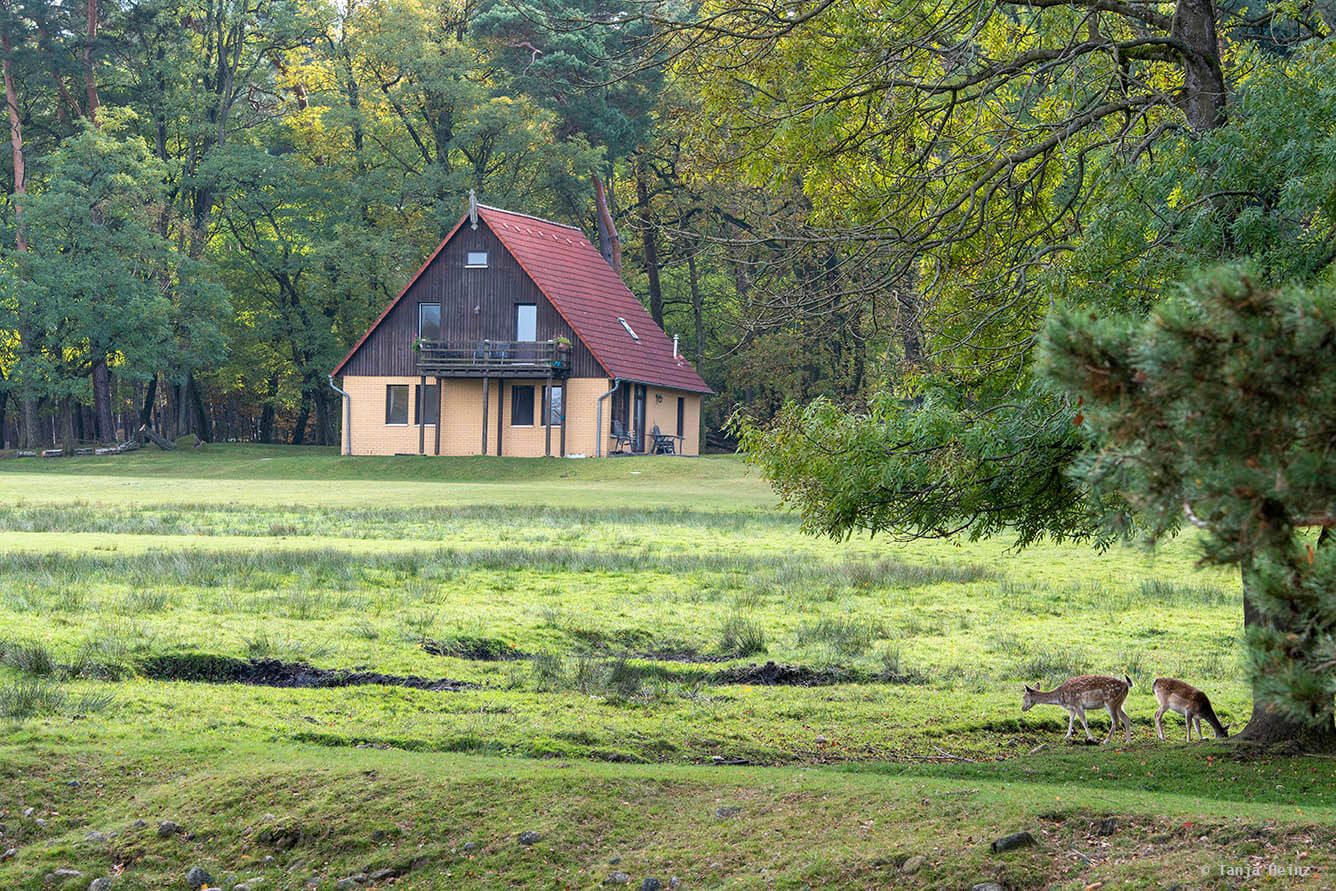
Just after entering the wildlife park I went directly to the large feeding ground in the center of the wildlife park. An animal attendant of the park recommended me to go there, as animal feeding was taking place at 12 p.m.
Thus, I headed to that place.
I was without any map, but I found the feeding ground. On my way to the feeding ground I encountered already some deer. However, when they saw me, they were frightened at my presence and ran away.
But the closer I got to the feeding ground, the more relaxed the animals were. At least it seemed to me.
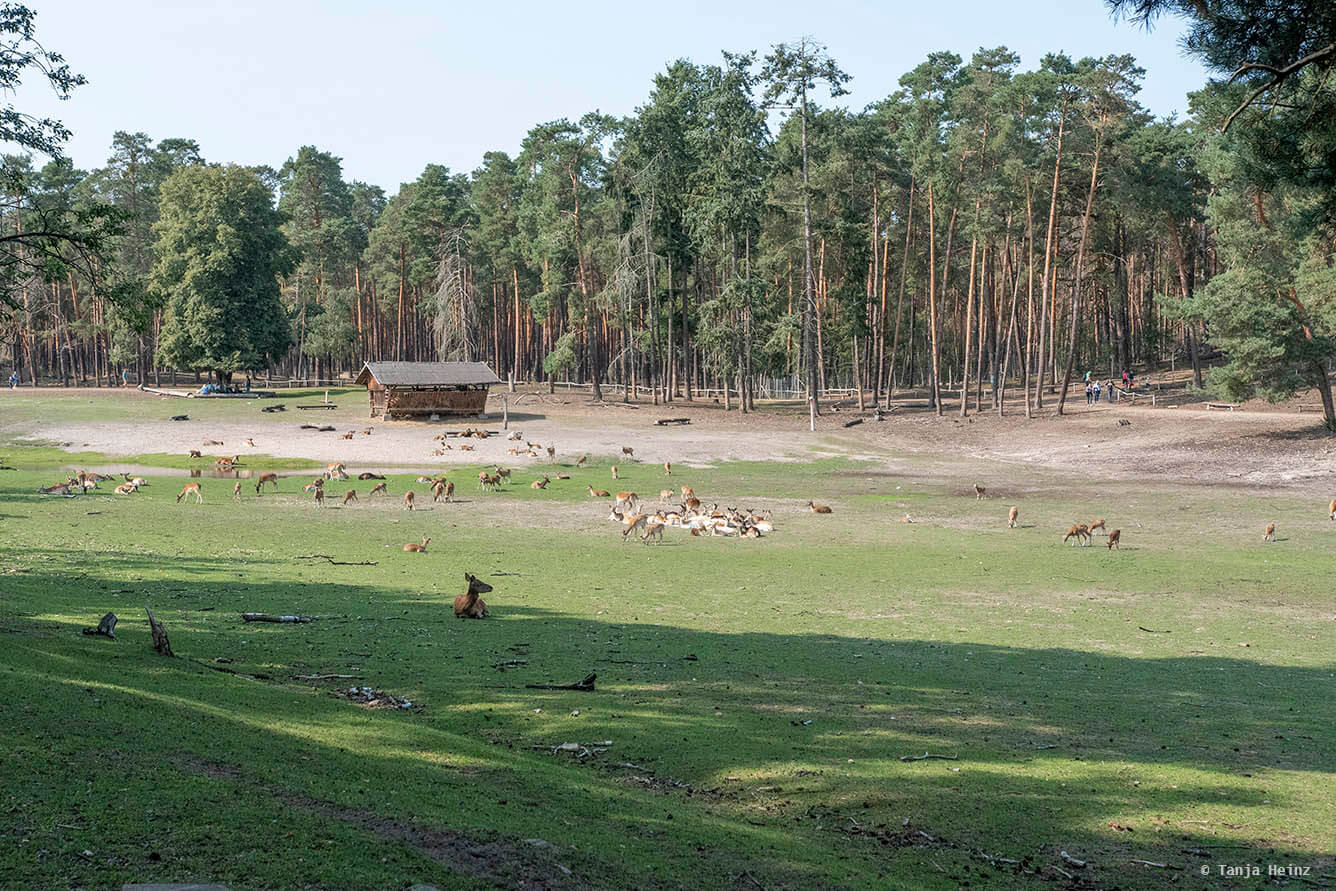
Some animals even stayed just next to the trails and I could easily take photographs of them.
Important: Please follow the rules of the wildlife park. In the wildlife park Johannismühle it is not allowed to leave the trails. If you want to know more about the other rules of the wildlife park, please visit the official website.
One red deer was curiously looking into my direction. Now and again it was shaking its head. Maybe to chase away some flies?
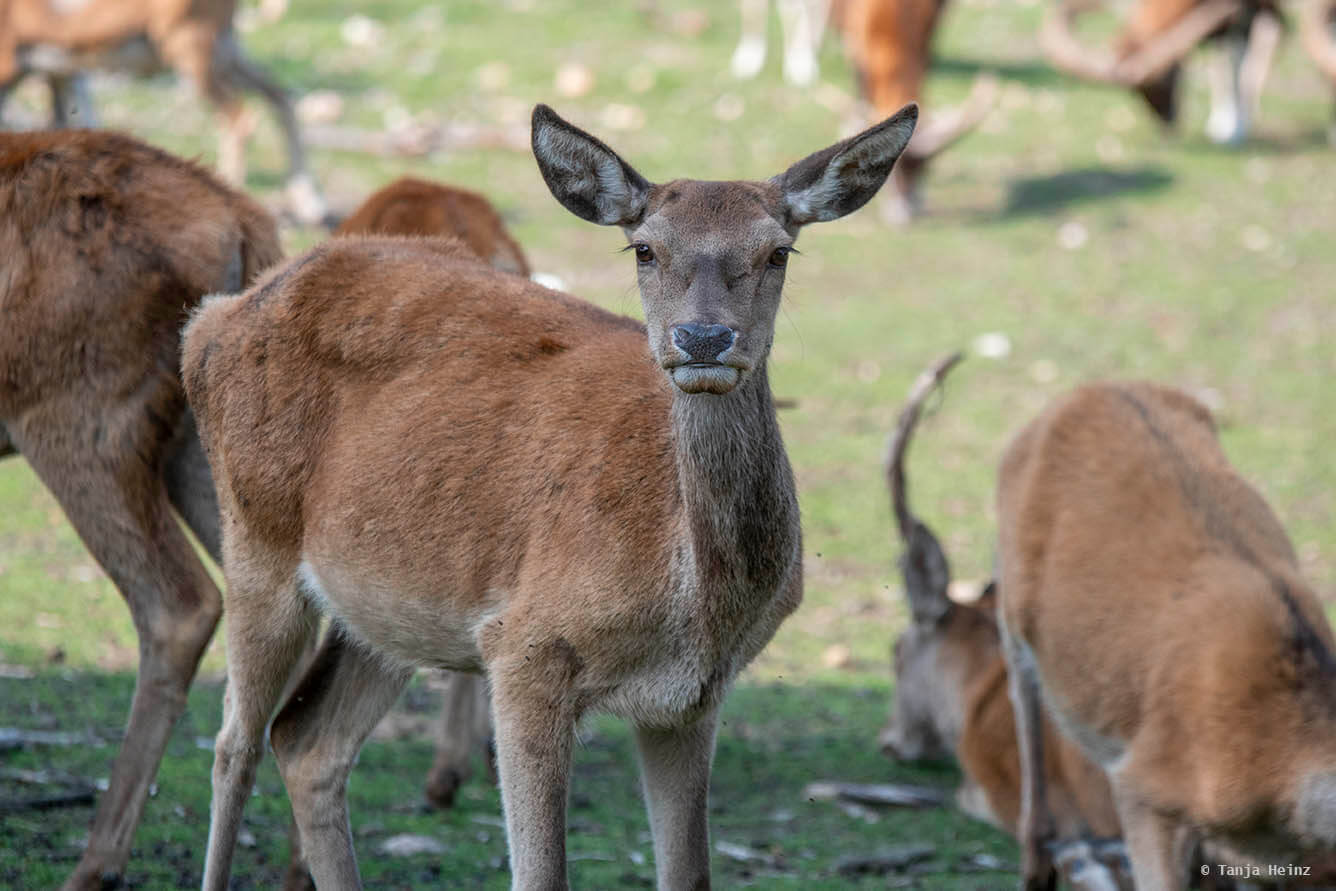
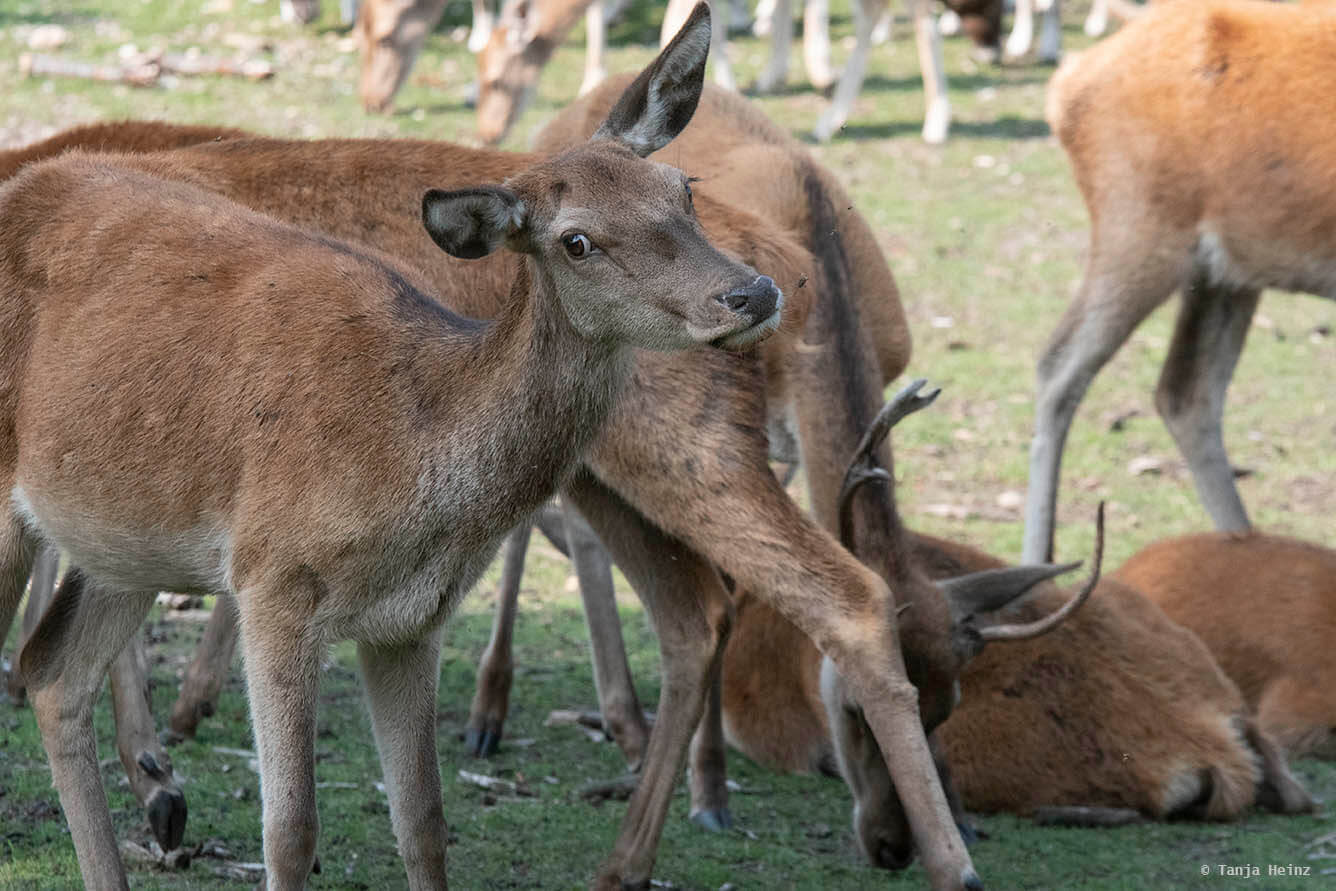
Just next to them some mouflons were measuring their strengths with each other. Especially the first two animals seemed to be quite ambitious to win a fight.
They were standing there, feeding, but every now and again they stopped the other one by intervening with its horns. It was quite amusing to observe them. As if there wouldn't have been enough place for all of them on the meadow...
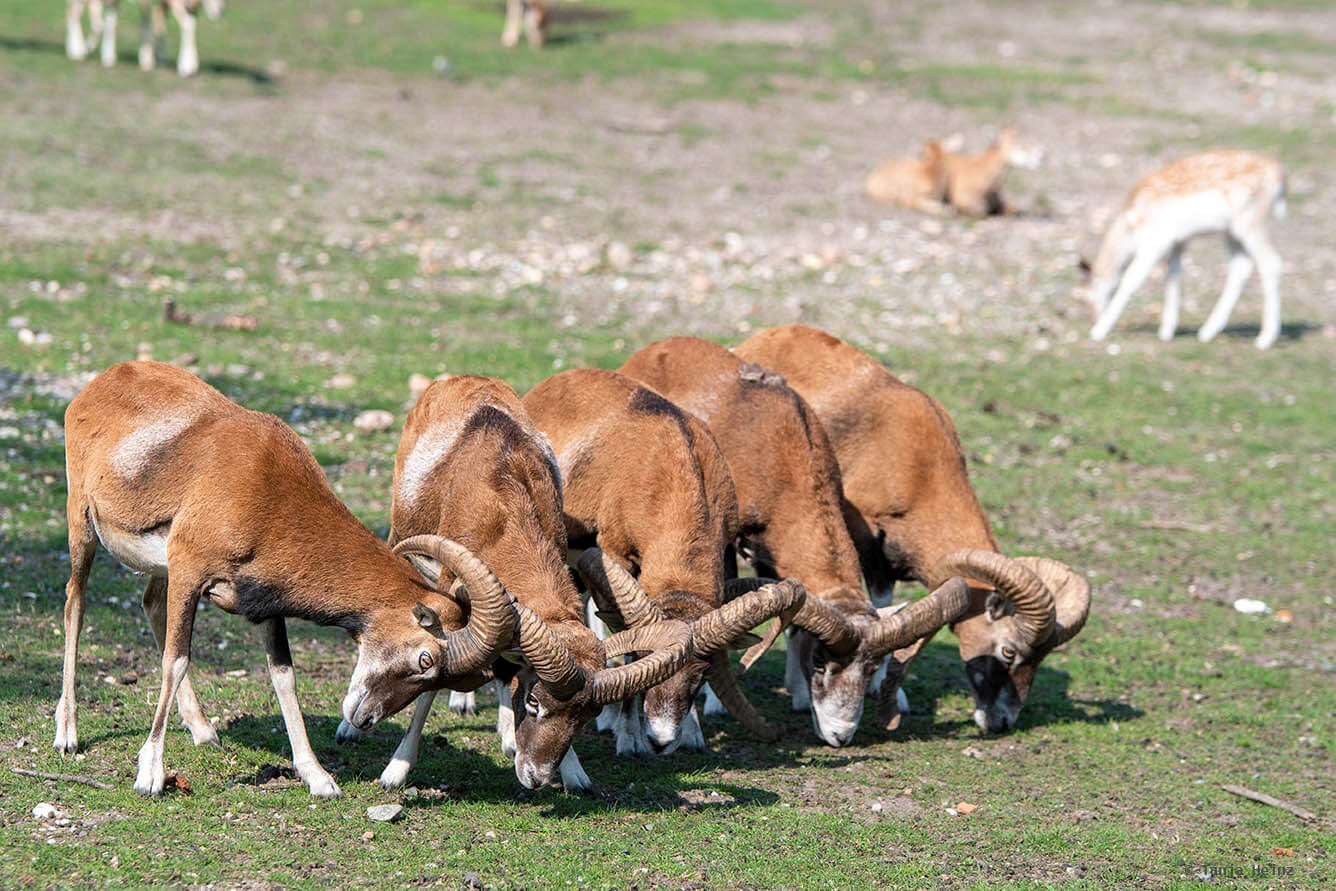
In contrast, the fallow and red deer were quieter.
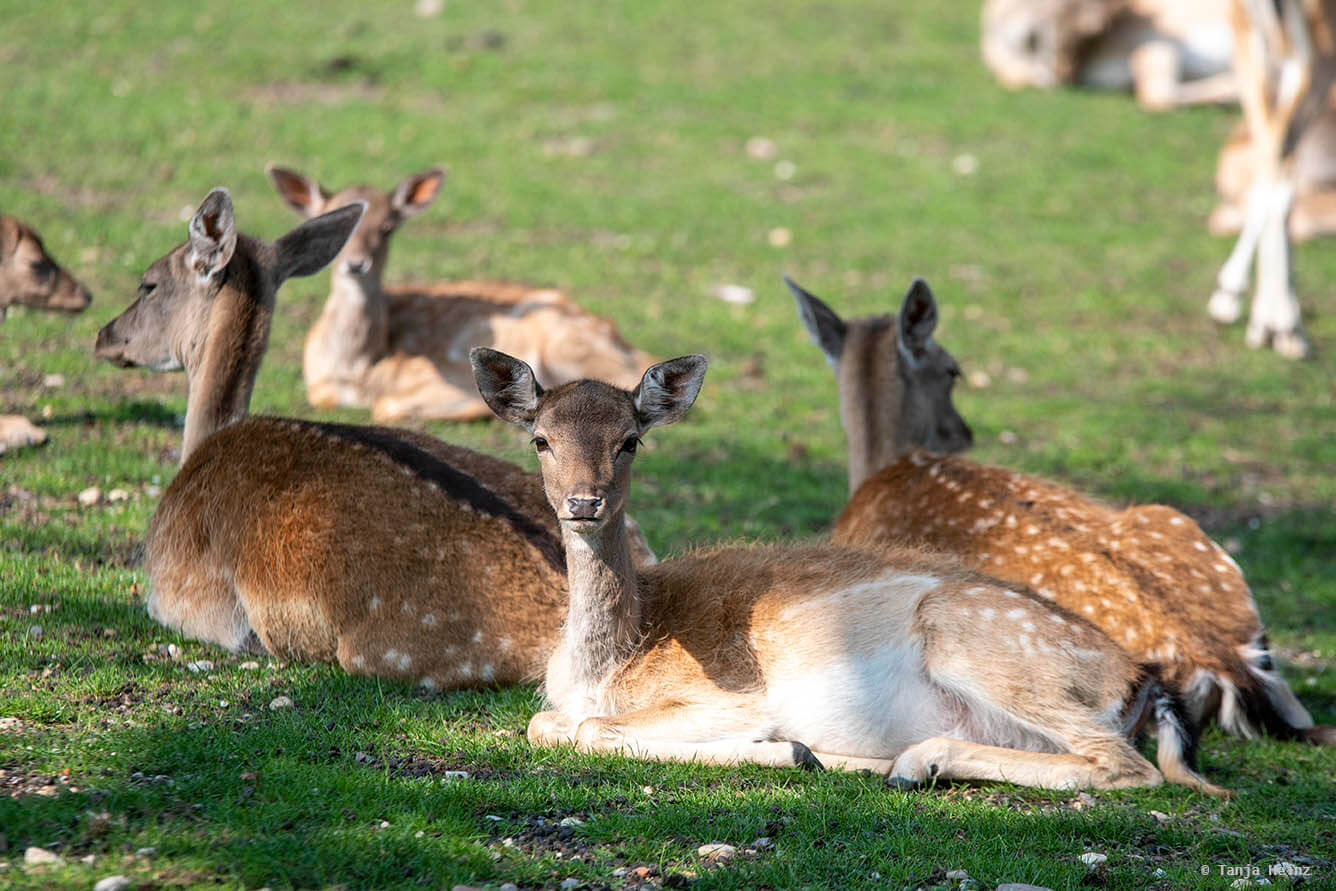
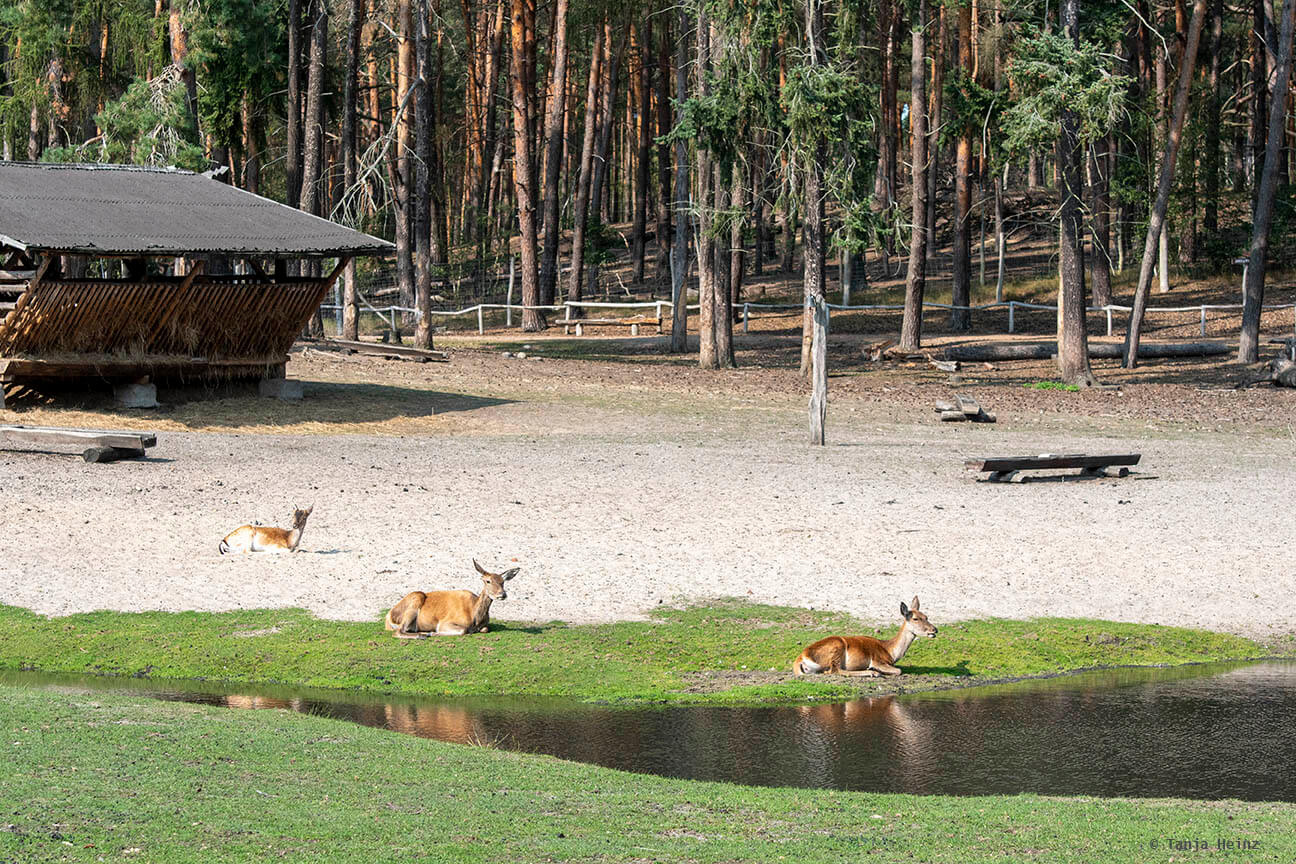
But suddenly the animals became more and more alert.
It was feeding time!
All animals - even the animals that were sitting comfortably on the meadow - stood up and followed the group.
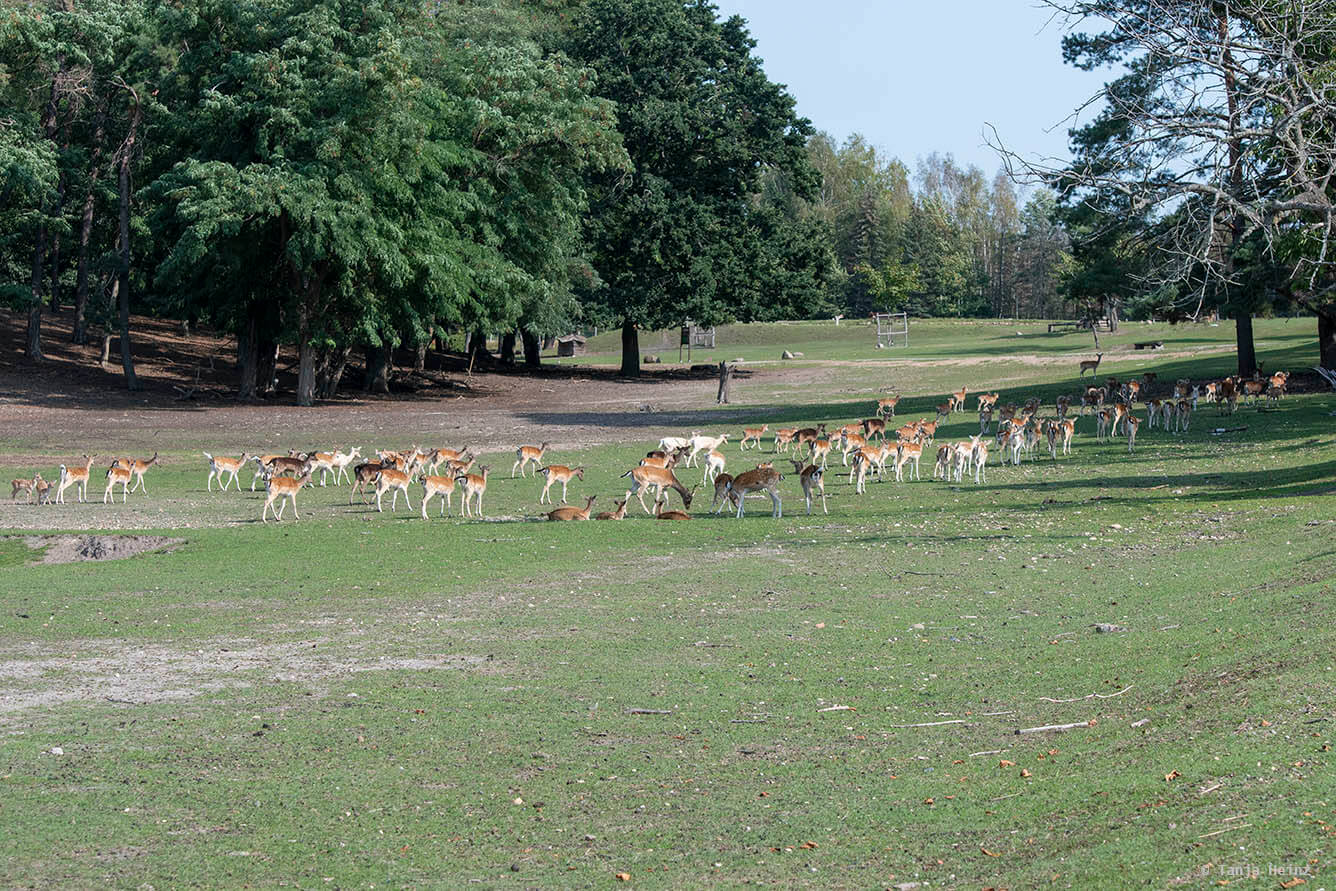
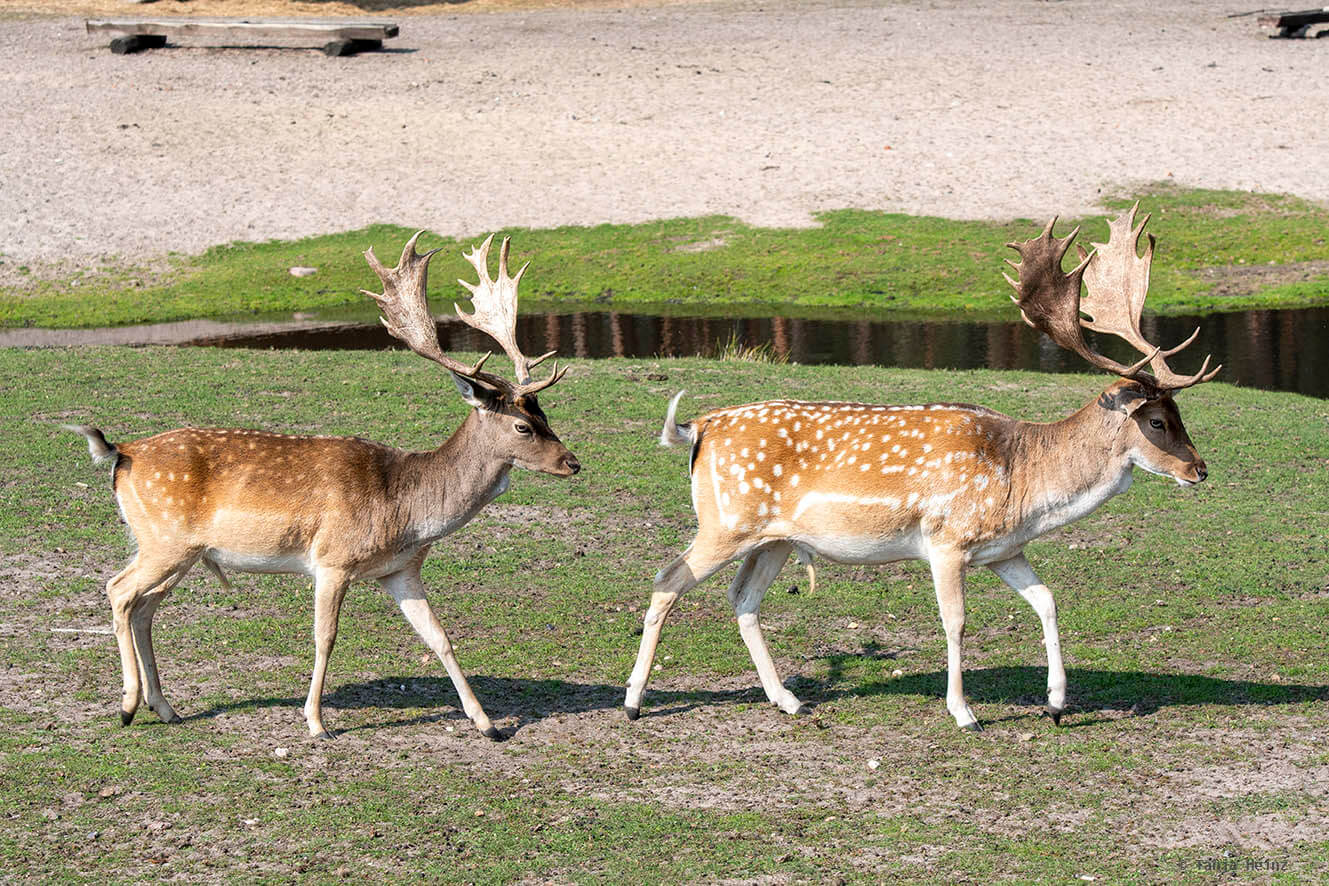
According to that other animal attendant, 12 p.m. is the best time to watch that many animals at one spot. Because after feeding time, most animals spread into different directions to get to their retreat areas.
Finally I saw the tractor with the food. The animals had heard the tractor before me and were following it.
I stayed at the place where I was standing, as I thought that the group might probably follow the tractor onto the meadow.
It was indeed like that.
The animals knew already how they would get their food and stood just next to the shovel of the tractor.
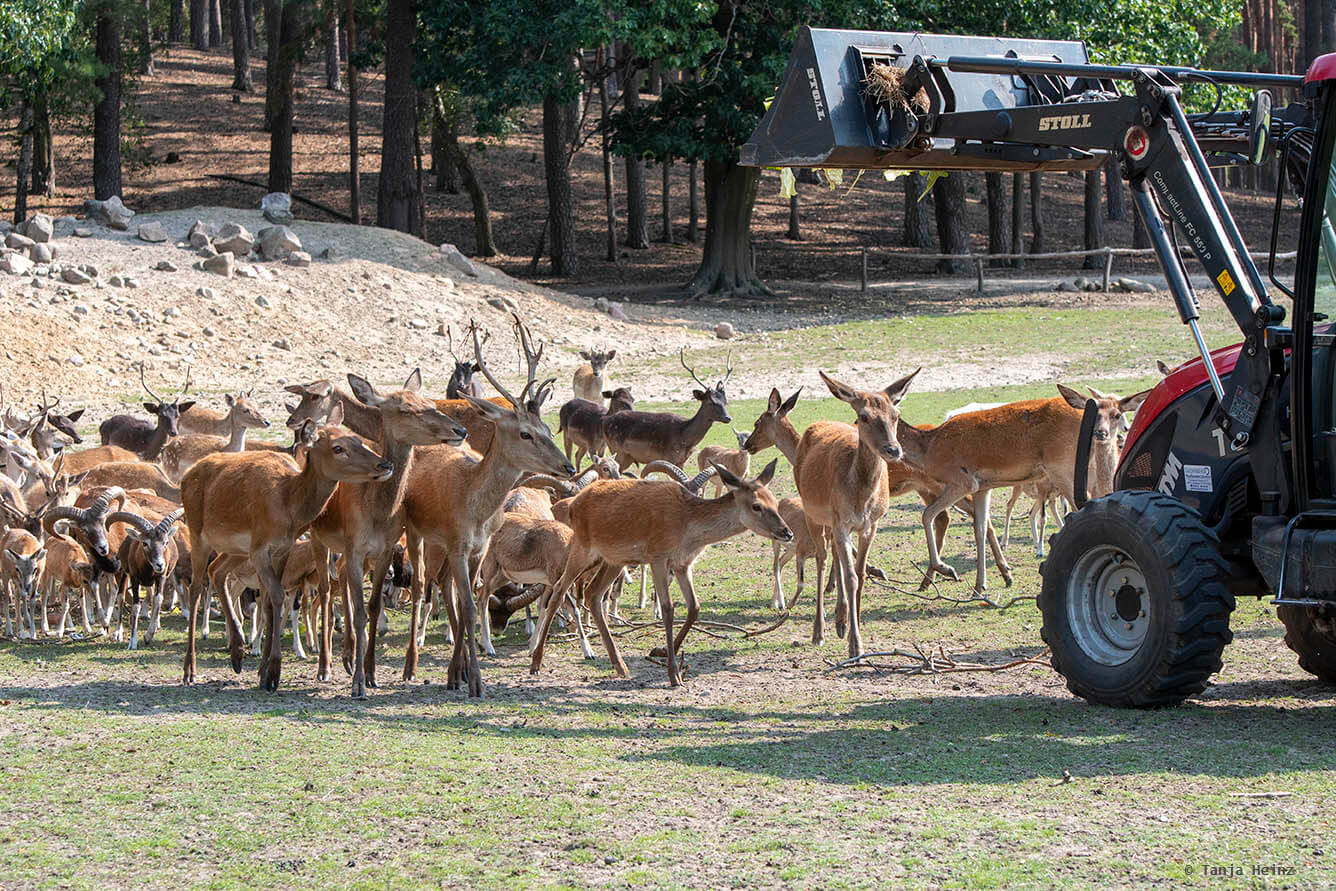
The person in the tractor drove onto the meadow and the driver spread the vegetables on the meadow. The animals followed.
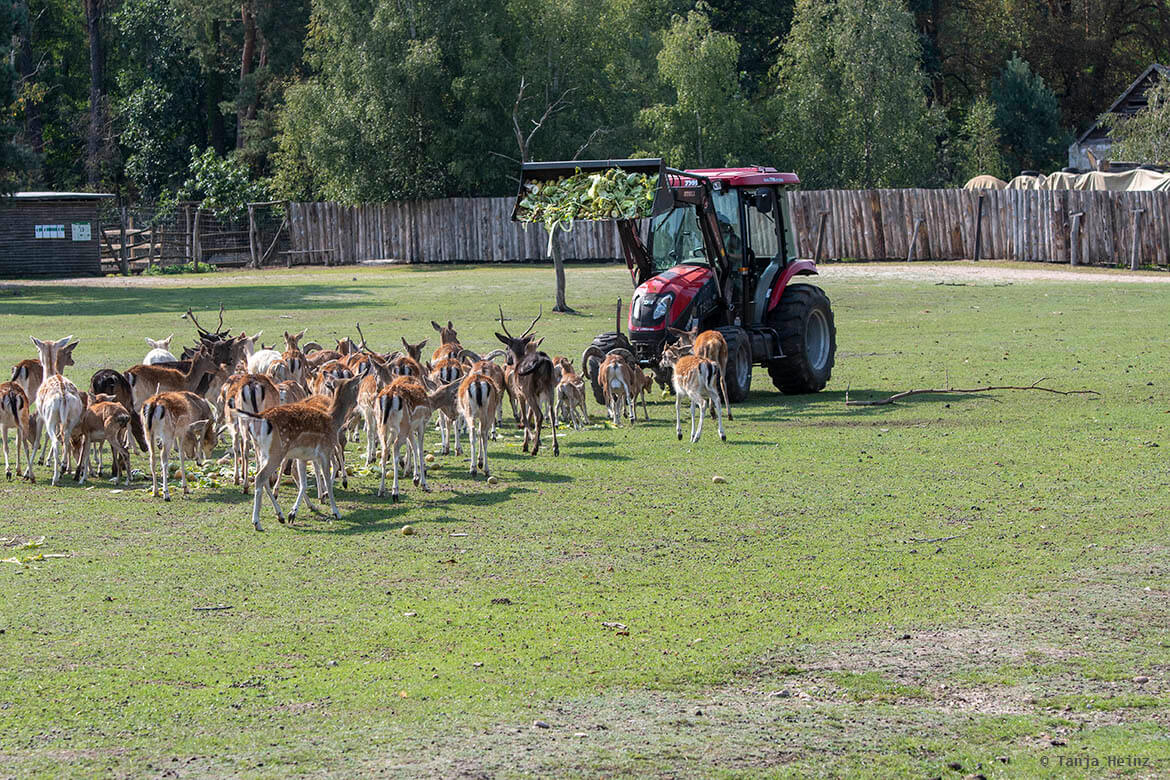
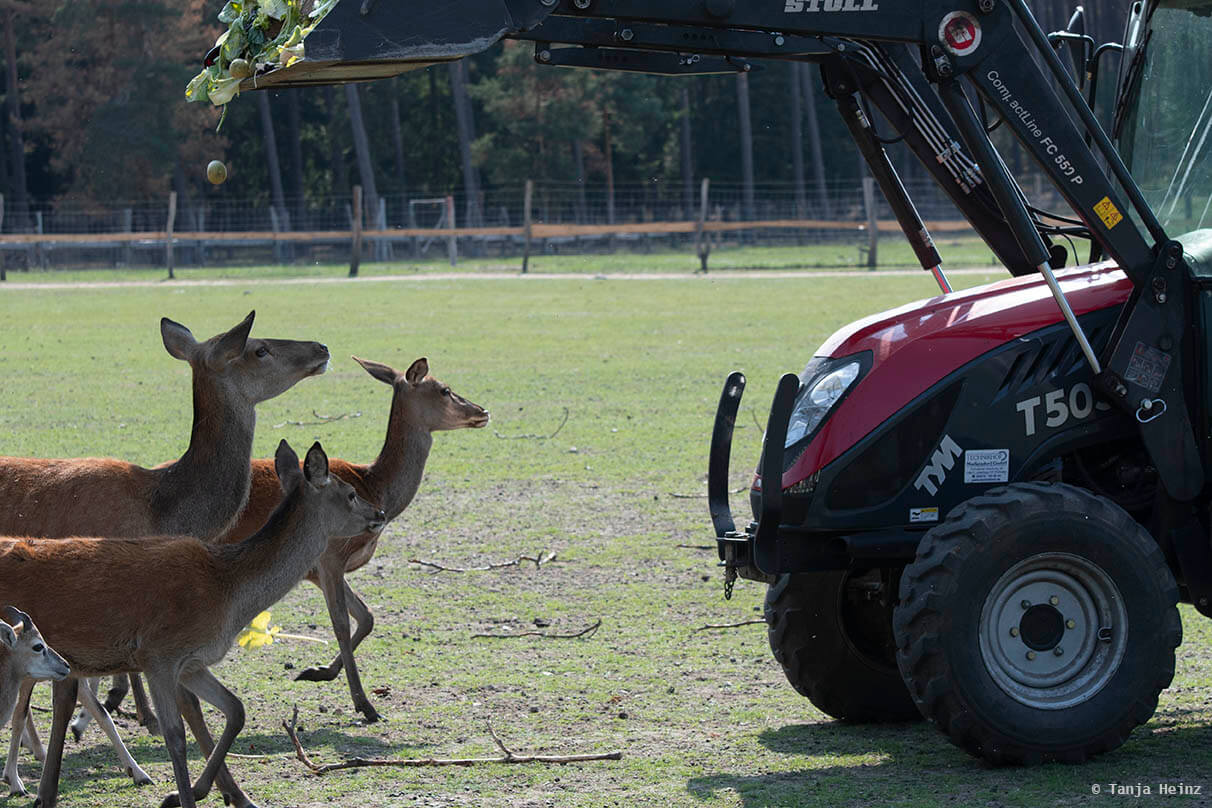
I tried to take some nice photographs of the animals.
Just next to me were several other visitors interested in photographing the animals during the feeding time.
Note: There are some rules to follow on the website of the wildlife park Johannismühle with respect to photographing animals. The photographs are allowed to use for private purposes. It is not allowed, however, to use the photographs for-profit.
I was taking pictures of all animals. But I was also trying to distinguish fallow and red deer. Some deer - especially the males - were quite easily to distinguish.
Apropos male deer. In general, I felt that the male deer were less excited about the food. They were quieter and not following the tractor in such a nervous manner.
A fallow deer male was strutting past in a very upright and elegant way from one place to the other. At the opposite side of the meadow that male laid down to start its rest in a comfortable position.
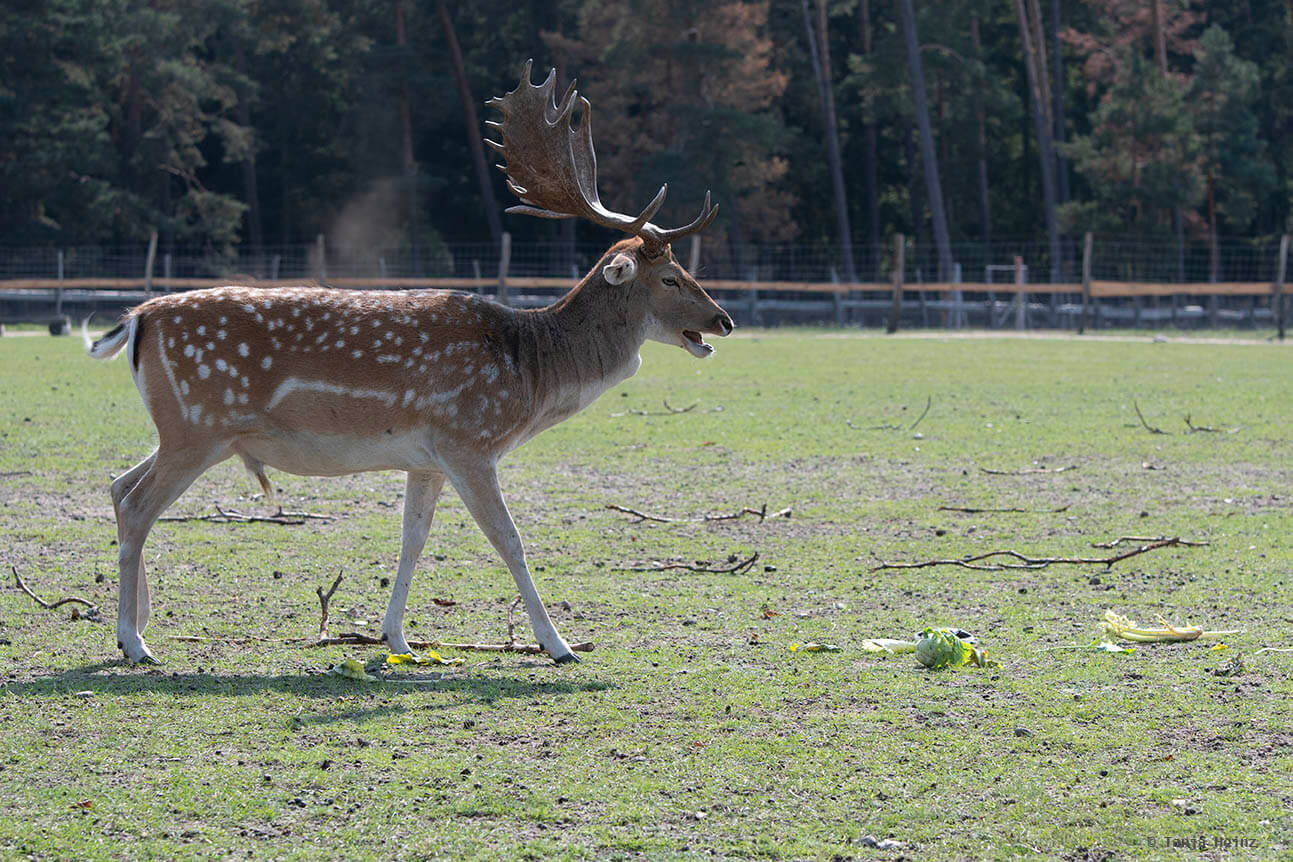
Particularly excited, active and nervous were the small deer.
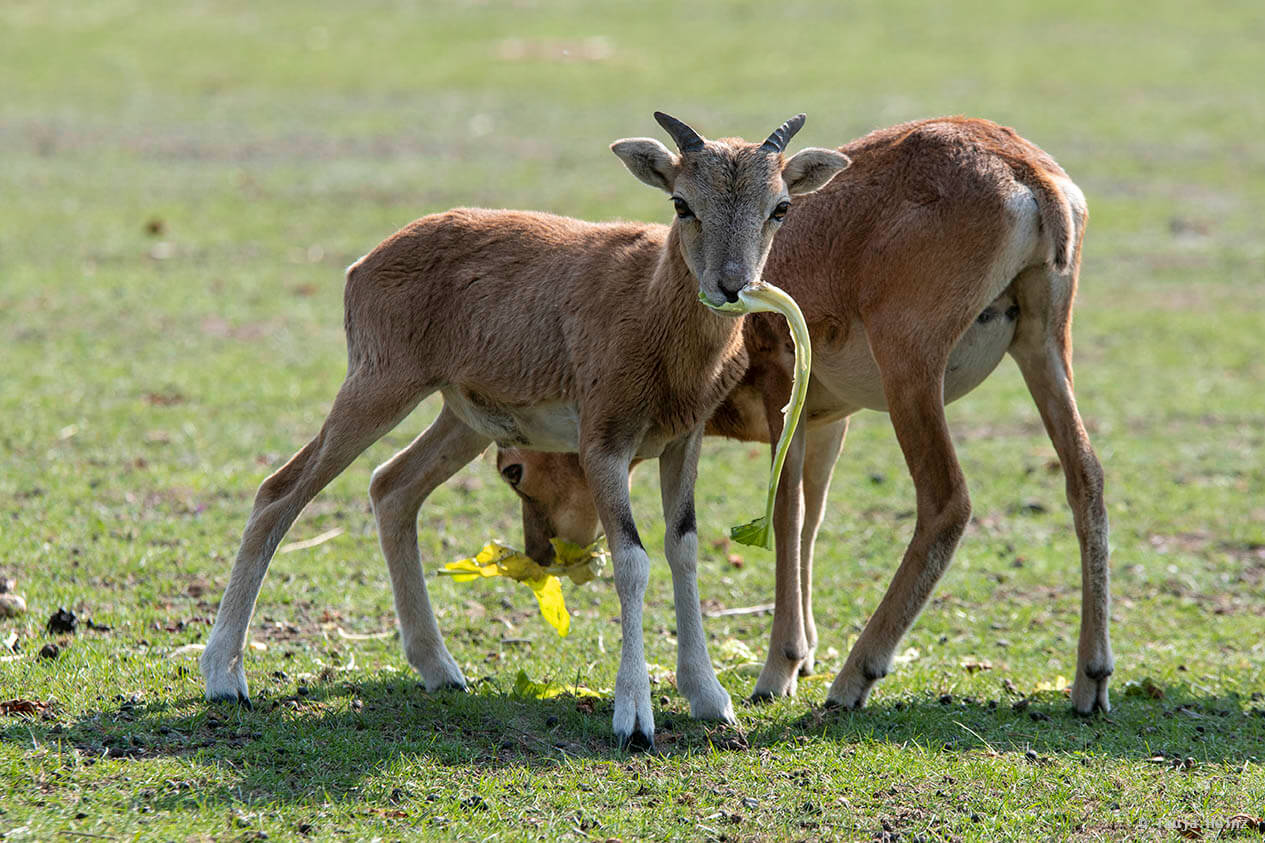
On the feeding ground all animals were united. Red deer, fallow deer and mouflons.
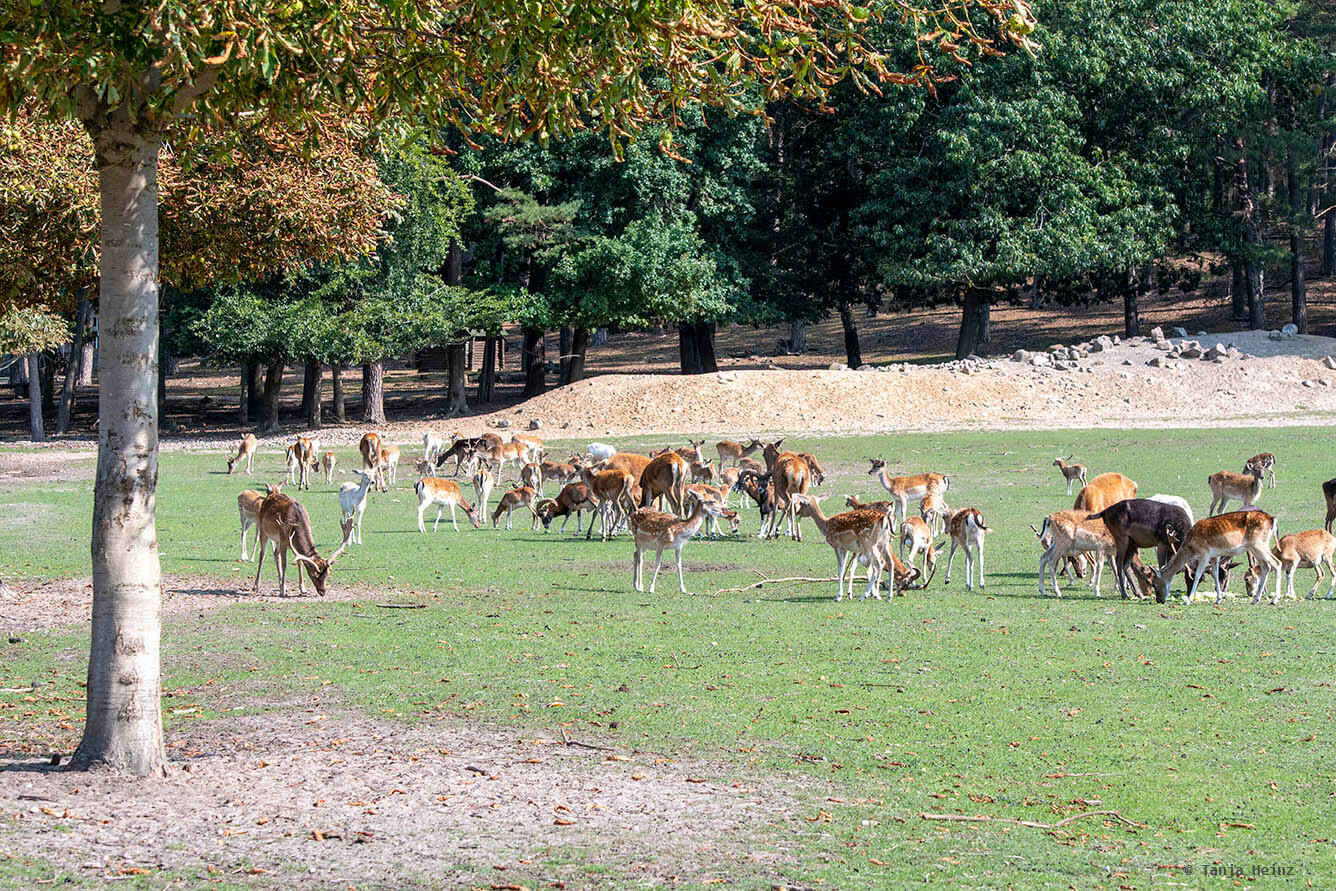
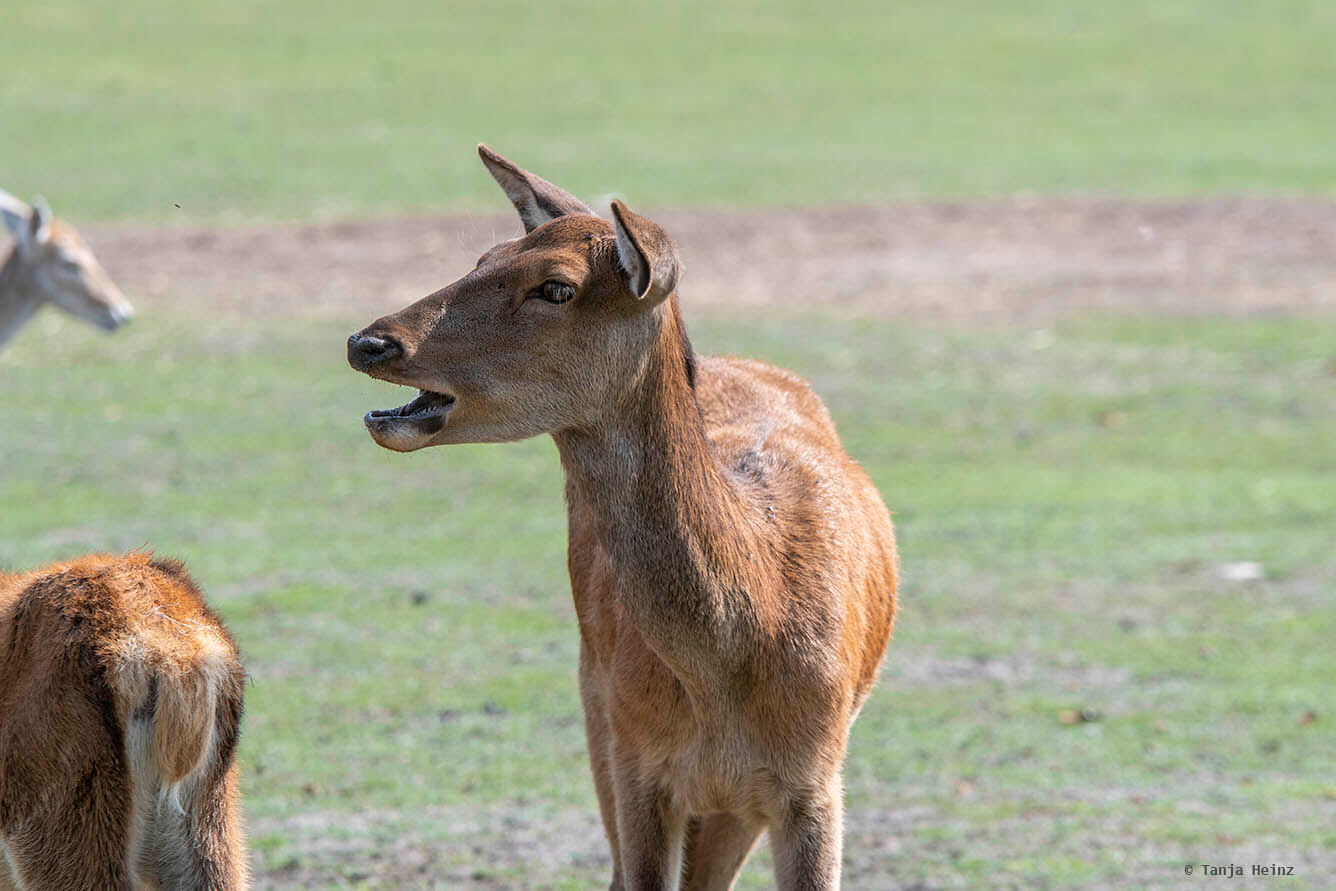
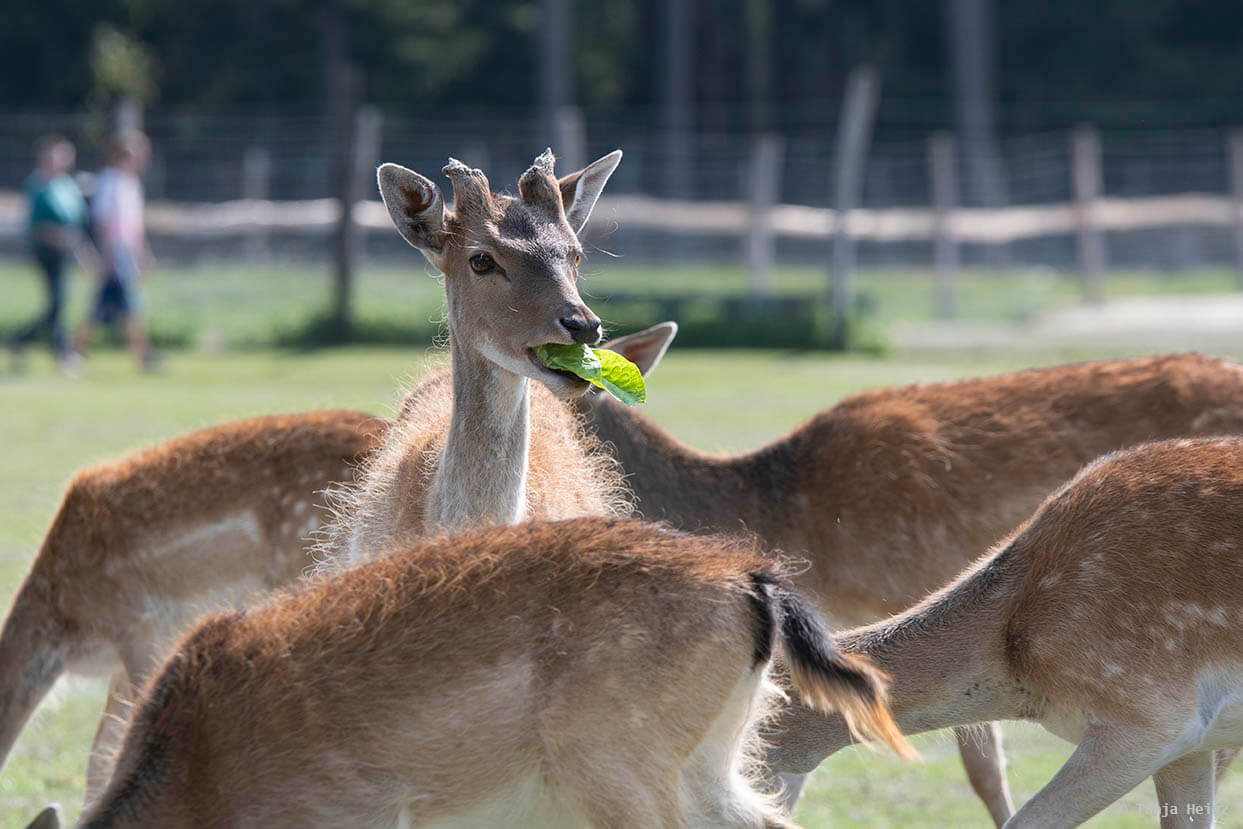
At some point I decided to continue with my walk trough the wildlife park Johannismühle. There were still many more places to see.
I went to the Arctic wolves, brown bears and lynxes.
Would I see all of them?
Unfortunately, no.
I was not very hopeful to get a glimpse of a lynx. I couldn't see a lynx in the wildlife park Schorfheide, neither. However, in the animal park Kunsterspring, in contrast, I was lucky to spot even two lynxes in their enclosures. Was it because it was a smaller enclosure with less vegetation and hiding possibilities?
On my second visit of the wildlife park Johannismühle I couldn't see the Arctic wolves very well. I saw them far away sleeping next to a tree trunk. However, two years ago on my first visit, I could observe them quite active and playful in their enclosure on the hill close to me.
In contrast, I could see a brown bear both on my first and on my second visit of the wildlife park Johannismühle.
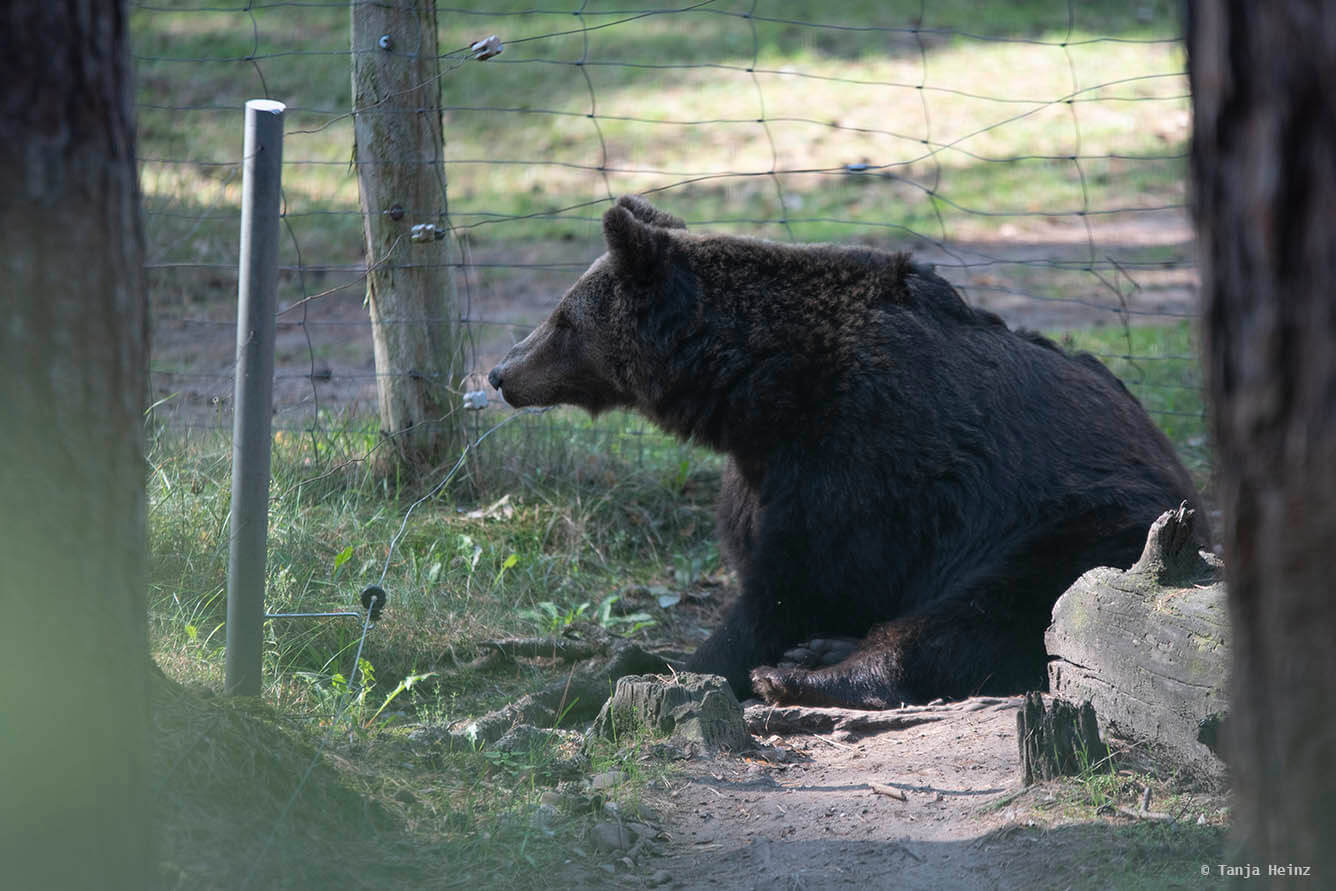
Why has this brown bear come to the wildlife park Johannismühle? How is the story of that bear?
In that moment I remembered my trip to the bear sanctuary in Müritz. In that bear sanctuary live several bears in a forest. Bears with a non-animal-friendly past.
Apropos animal welfare.
When I was standing in front of the brown bear enclosure, I was not the only visitor admiring the animal. There was also an older women with a package if biscuits. She was feeding the bear with them!
I couldn't believe it!
Fortunately, a small and smart boy saw that and asked the woman: "Is that healthy for the bears?"
The woman smiled and shook her head.
But why did she feed the brown bear with those sugar-containing biscuits? She knew that this was not healthy for the bears!
I couldn't understand it. But luckily she stopped feeding the bear when the boy asked her. Maybe she felt embarrassed in that moment as it was a small boy who made her aware of it...
Important: Please don't feed the animals with your food! Especially not with biscuits! Apparently there are automatons in the wildlife park where visitors can buy some food for the animals for 20 cents. I couldn't see any of those automatons. If you are interested, I suggest to ask at the entrance area.
I also passed the bisons and the konik horses. At the pond were some Egyptian geese. I stopped and stayed there for some time.

In the area around the pond I also encountered an insect hotel.
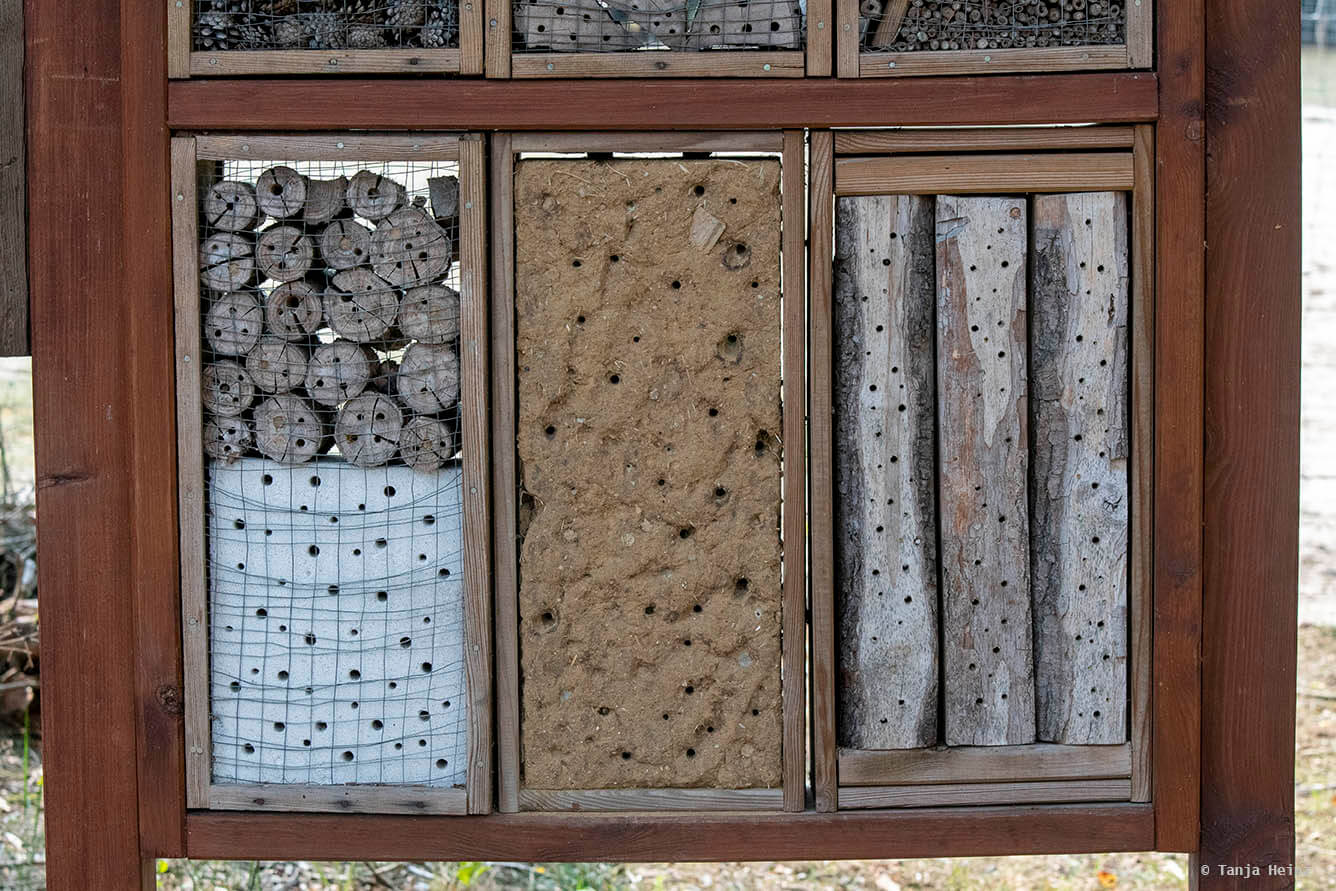
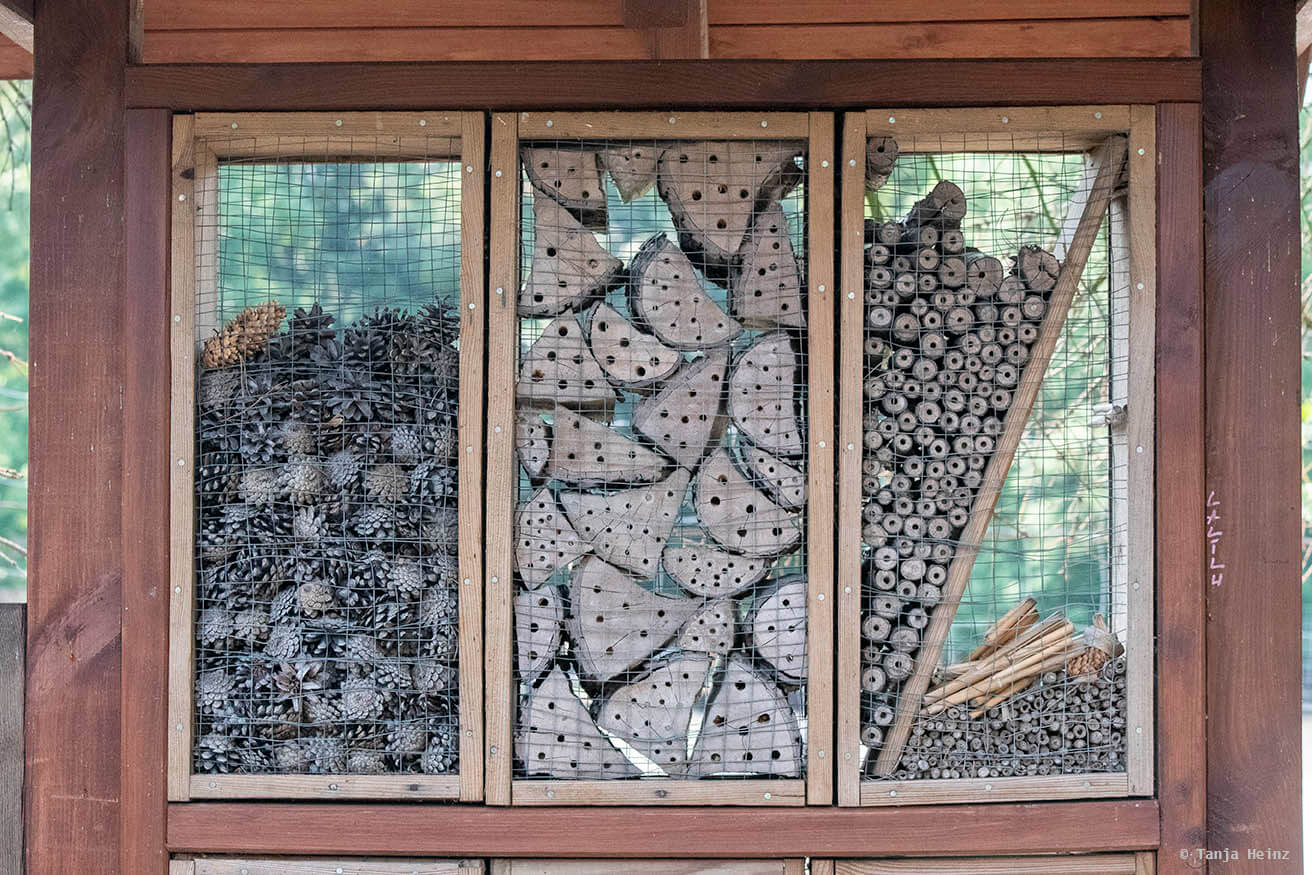
Of course, education is another part of the wildlife park Johannismühle!
Just next to the insect hotel I encountered a quite difficult task. Which animal belongs to which eyes? Would you have known that the eyes of the first animal (on the left) belong to a guinea pig?
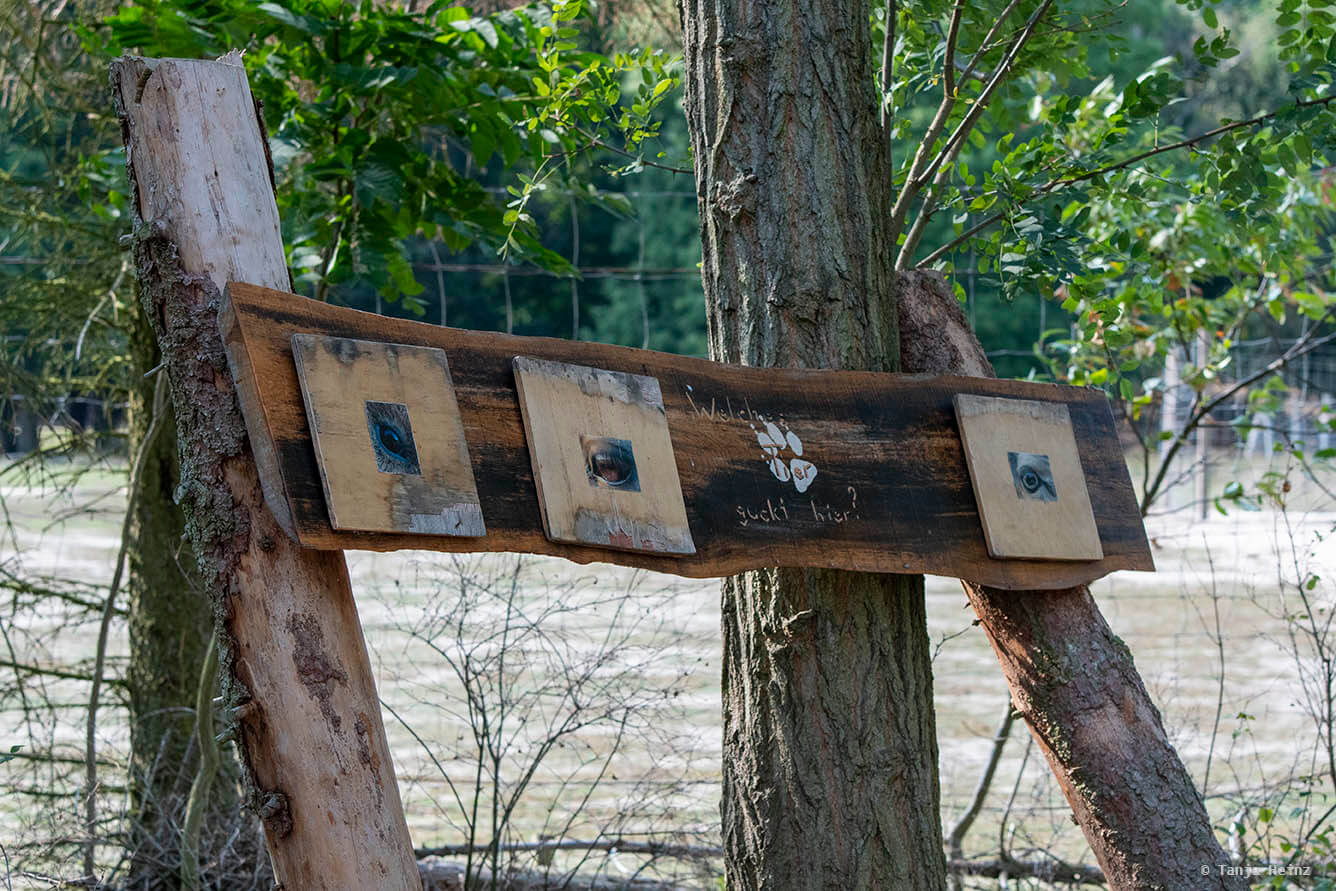
Honestly, I never would have thought of a guinea pig!
Nevertheless, in the next paragraph I give you a list of all the animals that live in the wildlife park Johannismühle.
Animals in the wildlife park Johannismühle
European fallow deer
The European fallow deer can be distinguished from other deer like red deer by the shovel antlers of the males and the speckled summer coat. Furthermore, fallow deer are smaller than red deer (but lager than roe deer).
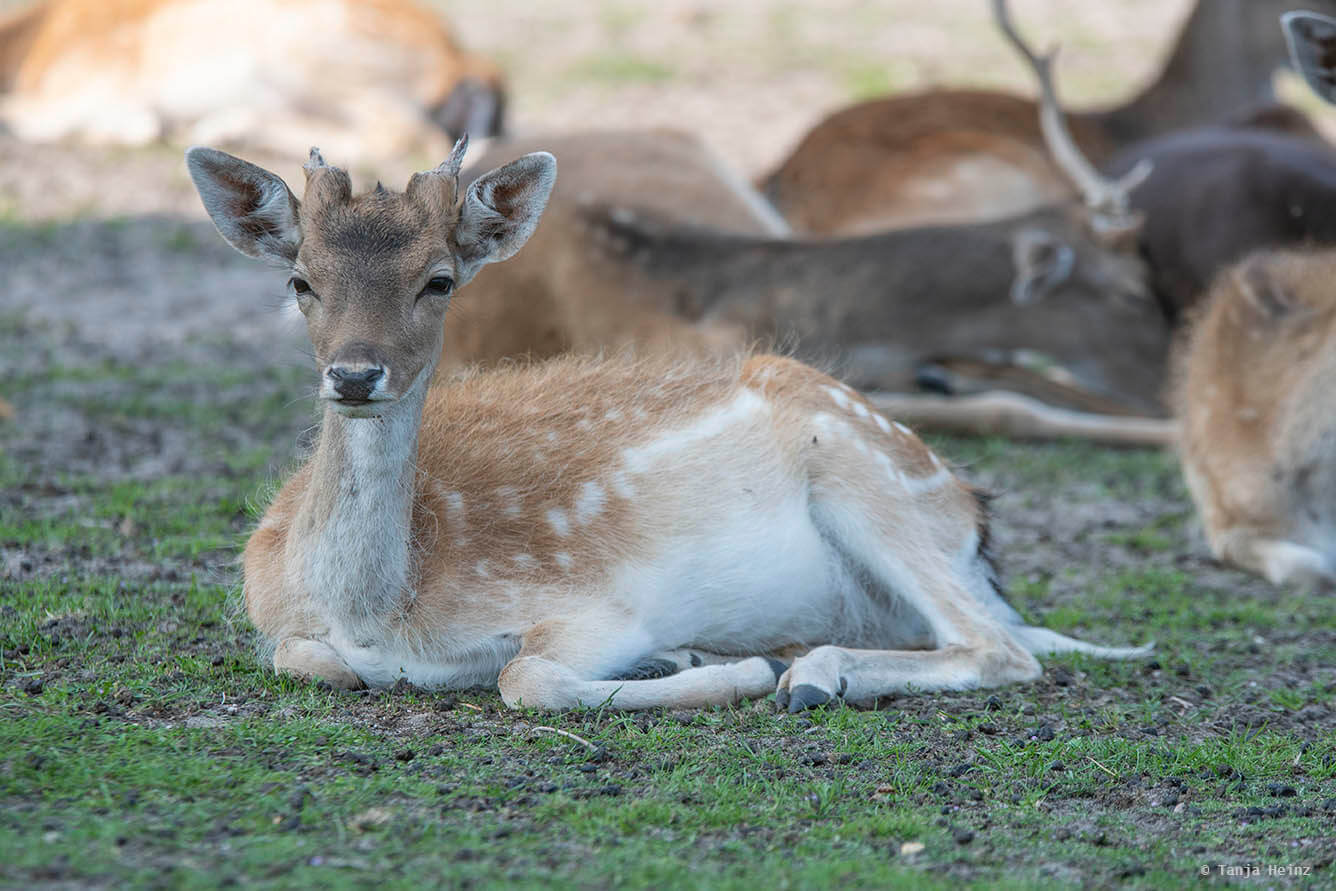
There are two different species of fallow deer. On the one side the European fallow deer and on the other side the Persian fallow deer. European fallow deer are widely distributed in Europe, but also in some parts of North and South America and they were even introduced in Australia and New Zealand. The Persian fallow deer, in contrast, is much rarer.
European fallow deer typically live in separate groups with males or females, respectively. However, during the breeding season groups might form into harems.
Females typically give birth to a single calve which is weaned after four to ten months.
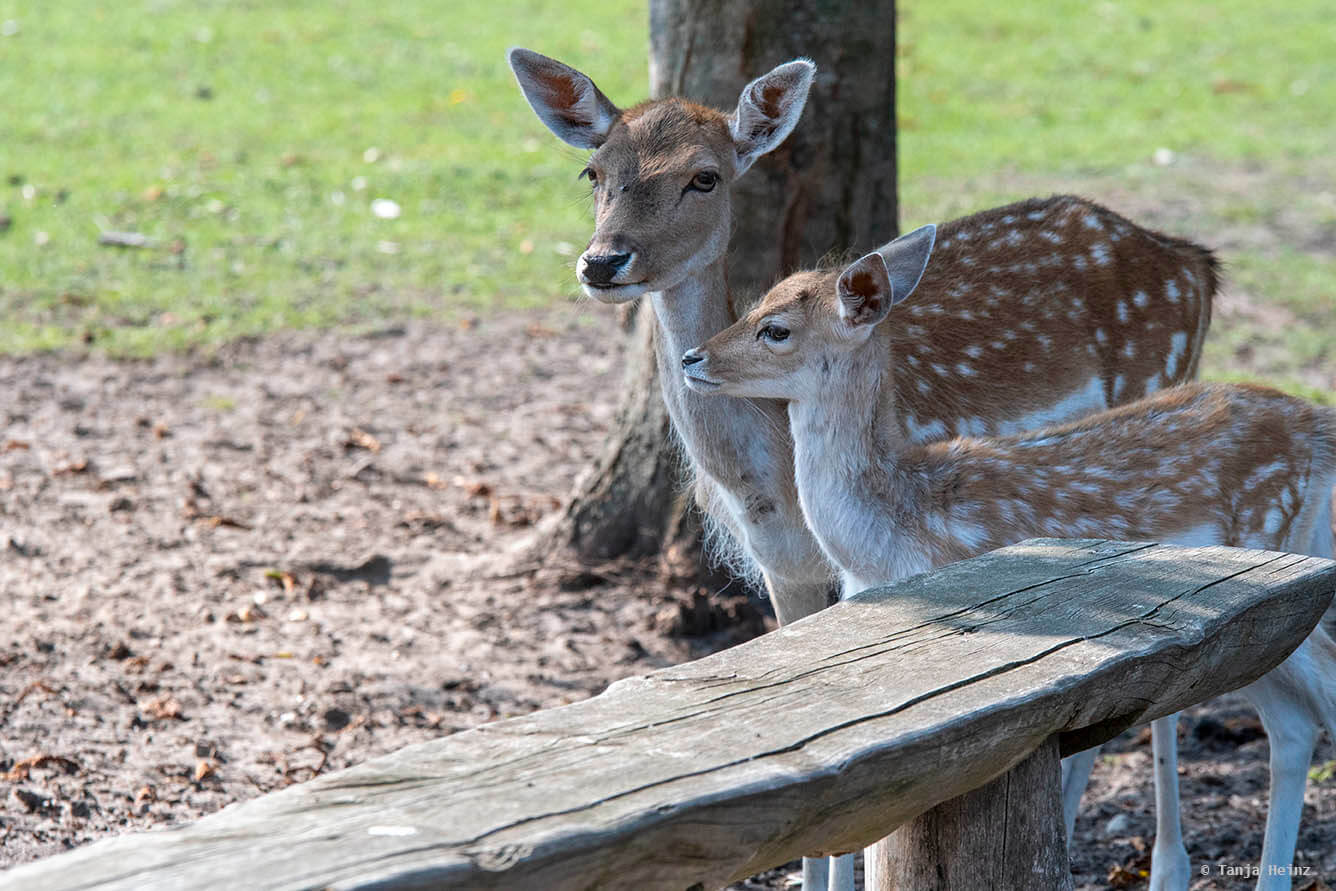
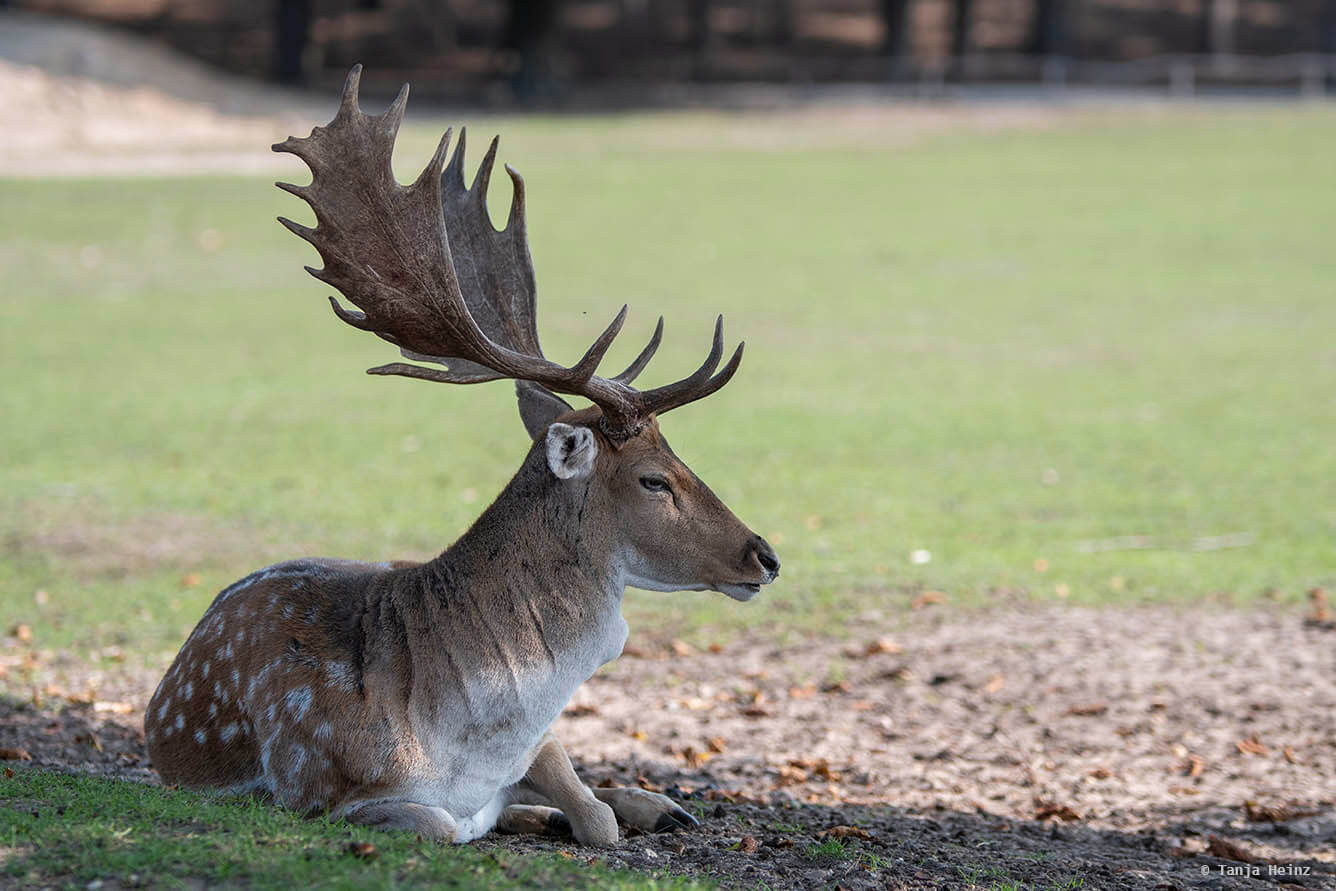
Fallow deer prefer open forests, but also parks as a habitat.
In the wildlife park Johannismühle visitors might encounter even rather bright or dark colored individuals. As fallow deer were domesticated for centuries, the coat color may vary between bright and dark.
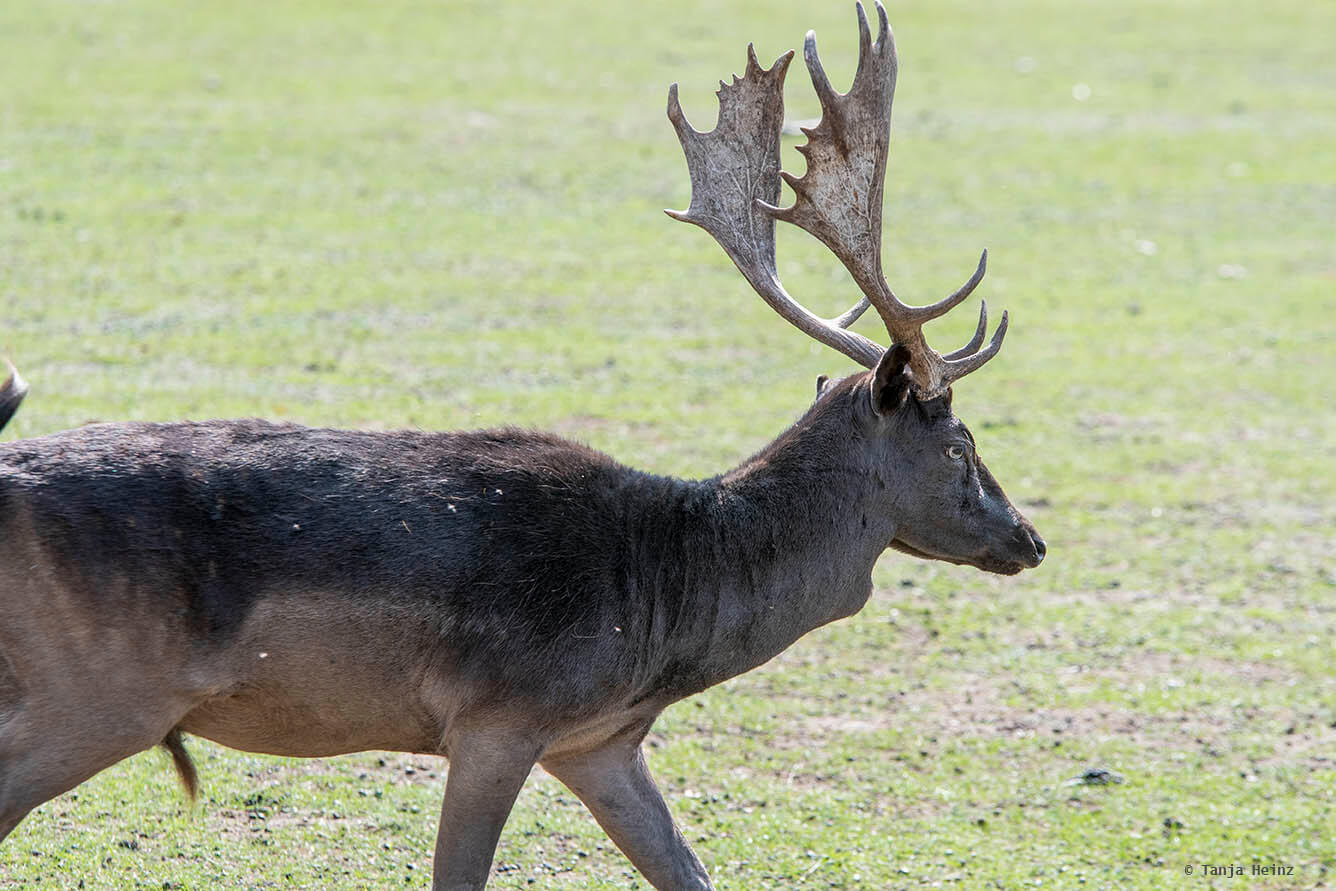
Did you know? Fallow deer live in separate female and male groups. Groups with just mothers and their young are also known as does. Males as well form into separate groups. However, during the rutting season males join the female groups to build mixed groups (German: "Brunftrudel").
Red deer
Males of red deer possess large antlers. Similar to fallow deer, only males develop them. The red deer is larger than the fallow and roe deer, but smaller than the largest deer - the elk.
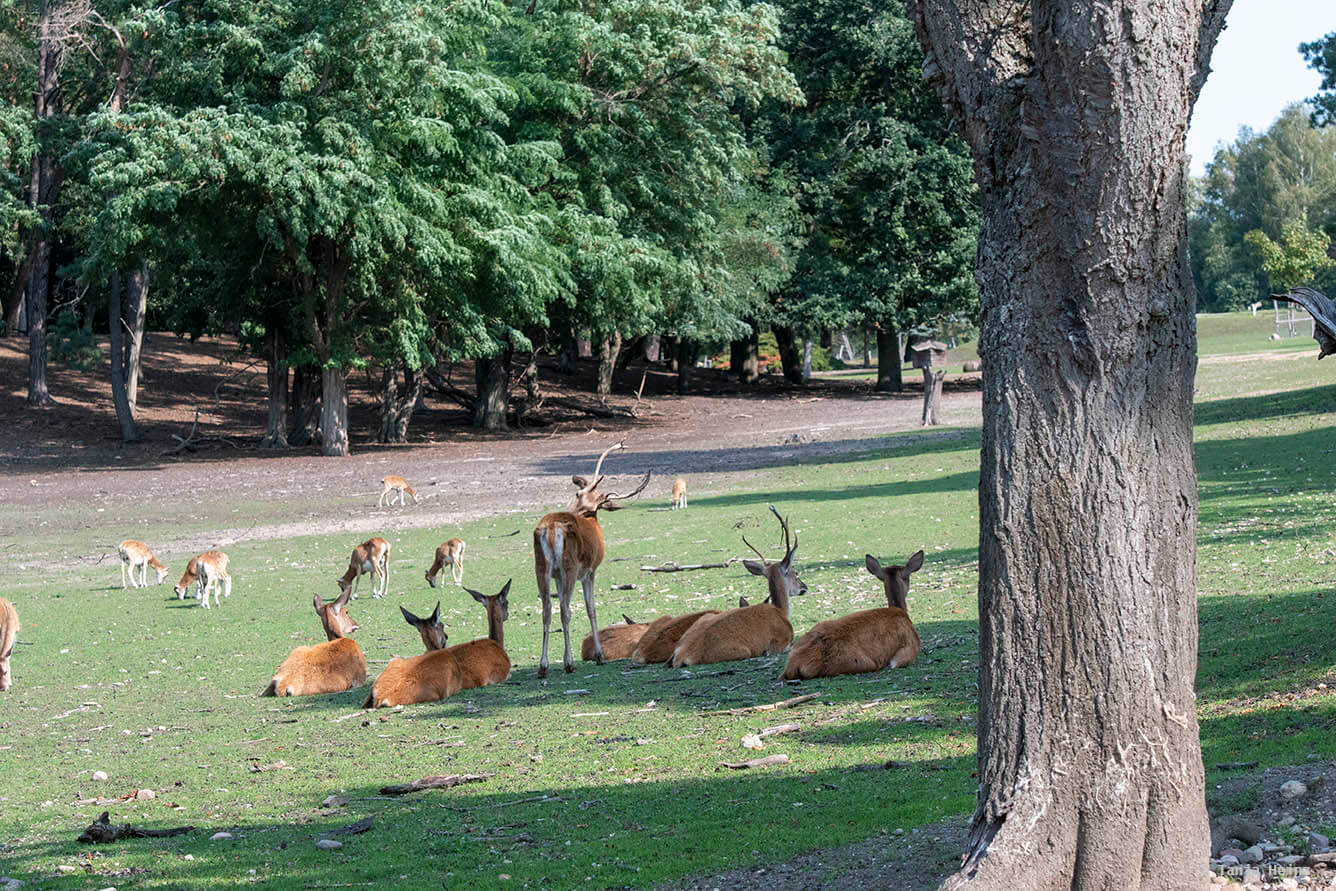
Unfortunately, red deer are a popular game among hunters due to their antlers. The antlers of red deer consist of bone and are shed every year between February and April. The antlers begin to regrow after the shedding. The weight and size of antlers depend on the age of an animal.
Male red deer use their antlers both to impress females, but they also use them as a weapon against their rivals.
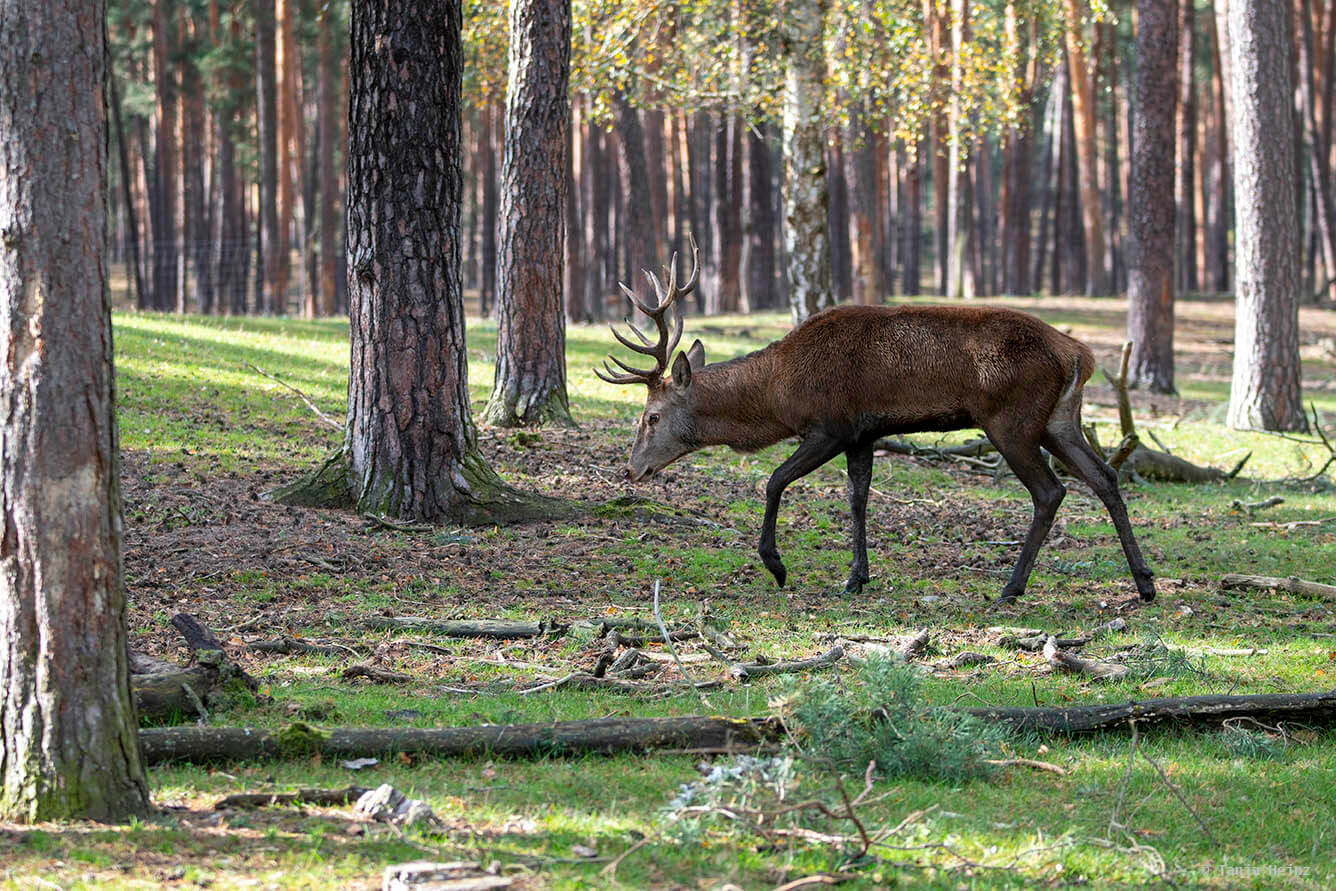
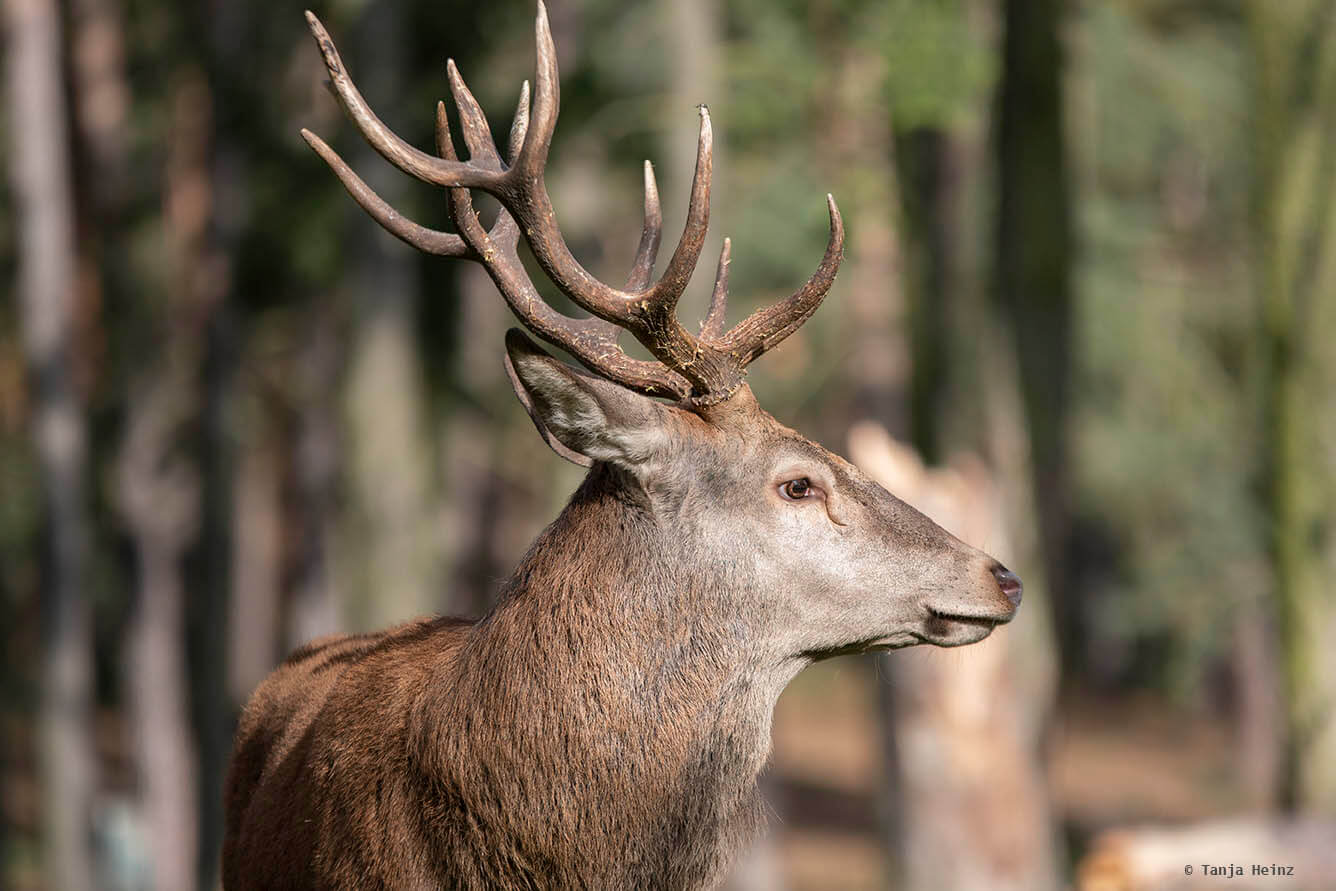
Red deer live in forests and adjacent areas.
The red deer as well lives in separate female and male groups but forms into harems during the breeding season. Females give birth to a young which is typically weaned after six to twelve months.
Interesting: The forest was originally not the habitat of the red deer. Actually, red deer used to live in open landscapes. However, as red deer are shy animals and as humans took more and more landscapes for agricultural land use, red deer had withdrawn in the course of time.
European mouflon
European mouflons are characterized by their long and helix-shaped horns. However, only males form these characteristic horns. Females, in contrast, only possess small horns or horns which are lightly curved towards the rear.
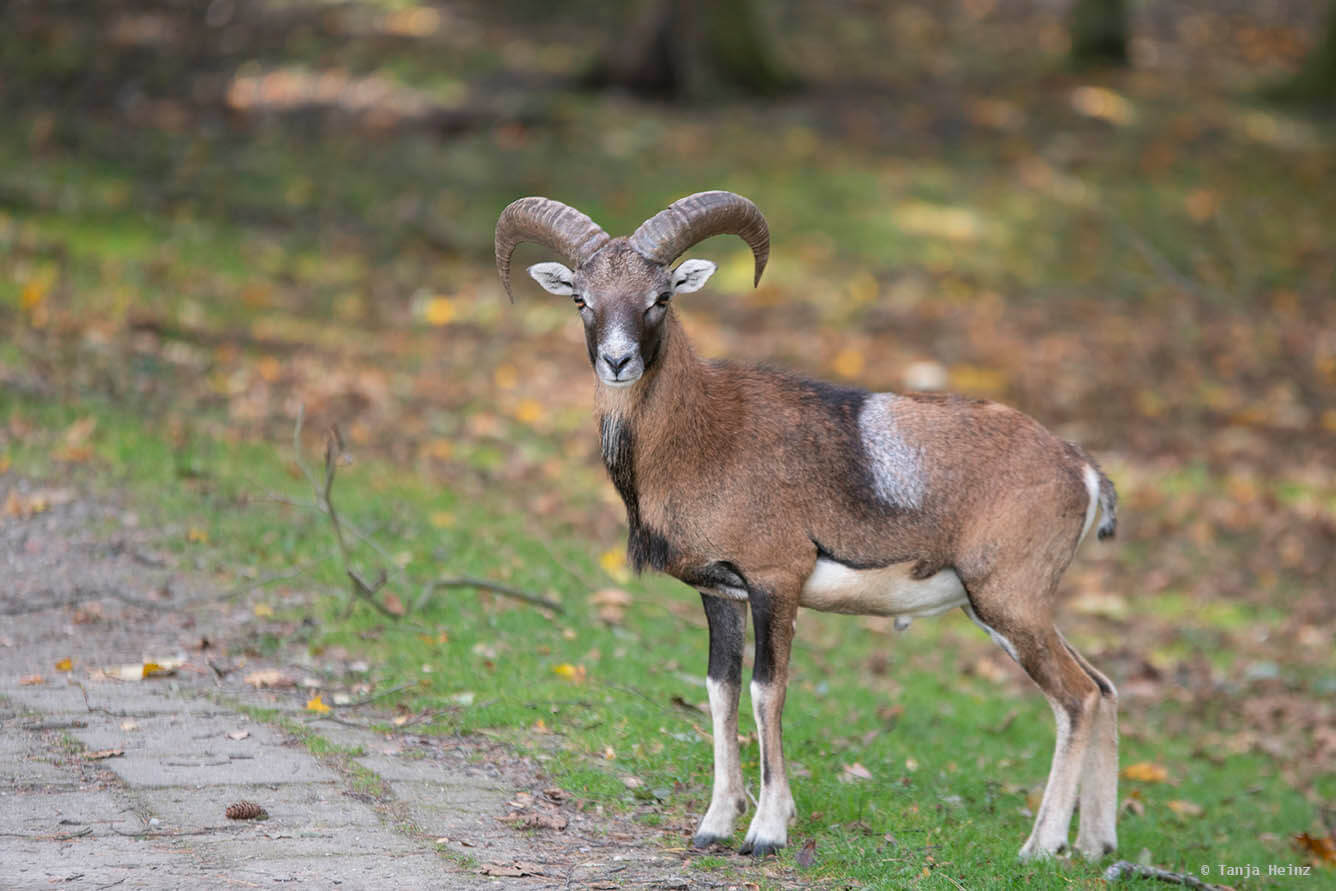
European mouflons belong to the genus of the sheep (Ovis).
The European mouflon prefers mountainous regions and forests as a habitat. Similar to red and fallow deer, European mouflons as well live in separate groups of females and males which might form into a harem during the breading season.
Interesting: The European mouflon was originally a mountain dweller, especially on Corsica and Sardinia. Due to intensive hunting, however, the European mouflon disappeared in many regions of Europe. However, as the European mouflon is a popular game among hunters, in some regions they were introduced again. In those regions the European mouflon typically lives in forests.
European bison
The European bison has something in common with red deer, fallow deer and European mouflons. All of them belong to the even-toed ungulates. Animals of the even-toed ungulates are characterized by hooves with an even number of functional toes on each foot (meaning two or four toes). Typical even-toed ungulates are ruminants like deer or bovids like the European bison, the domestic cattle, springboks or water buffaloes. Hippos and giraffes as well are even-toed ungulates. Odd-toes ungulates (like horses, tapirs or rhinos), in contrast, are characterized by hooves with an uneven number of functional toes on each foot (meaning one or three toes).
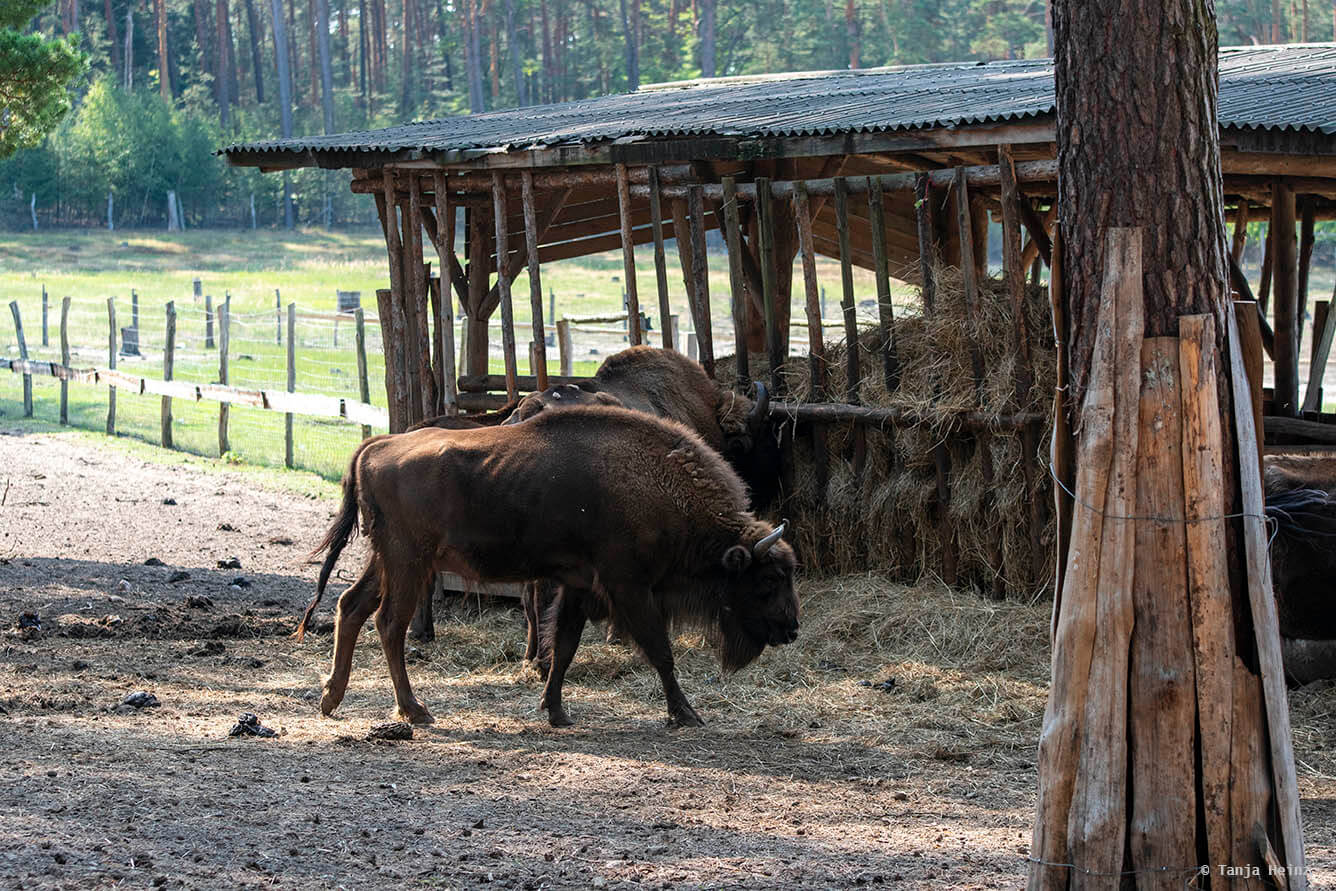
European bison are - since the extinction of the aurochs - one the largest living terrestrial mammals in Europe. They are, furthermore, the last wild bovine species in Europe! However, European bison occur in Europe only in a few regions like in Poland and Belorussia. Close to Berlin is another wildlife park where visitors can see European bison. And that is in the wildlife park Schorfheide.
Interesting: Did you know that bison are able to reach a running speed of up to 60 km/h. Although bison are bulky animals, they can run quite fast. A male can reach a maximum weight of about 900 kg, a female, in contrast, maximal 600 kg.
Llama
Llamas are like European bison and deer even-toed ungulates. Most people probably don't know, but llamas are camelids (Camelidae). Llamas don't possess a dorsal hump, but as a New World camelid - including also guanacos, alpacas and vicuñas - there are similarities between them and the camels like the dromedary (one dorsal hump) and the bactrian camel (two dorsal humps).
New world camelids and camels possess broad leathery sole pads, and thus, are perfectly adapted to an environment where it is required to walk either on hot sand (see camels) or on rocky terrain (see camelids).
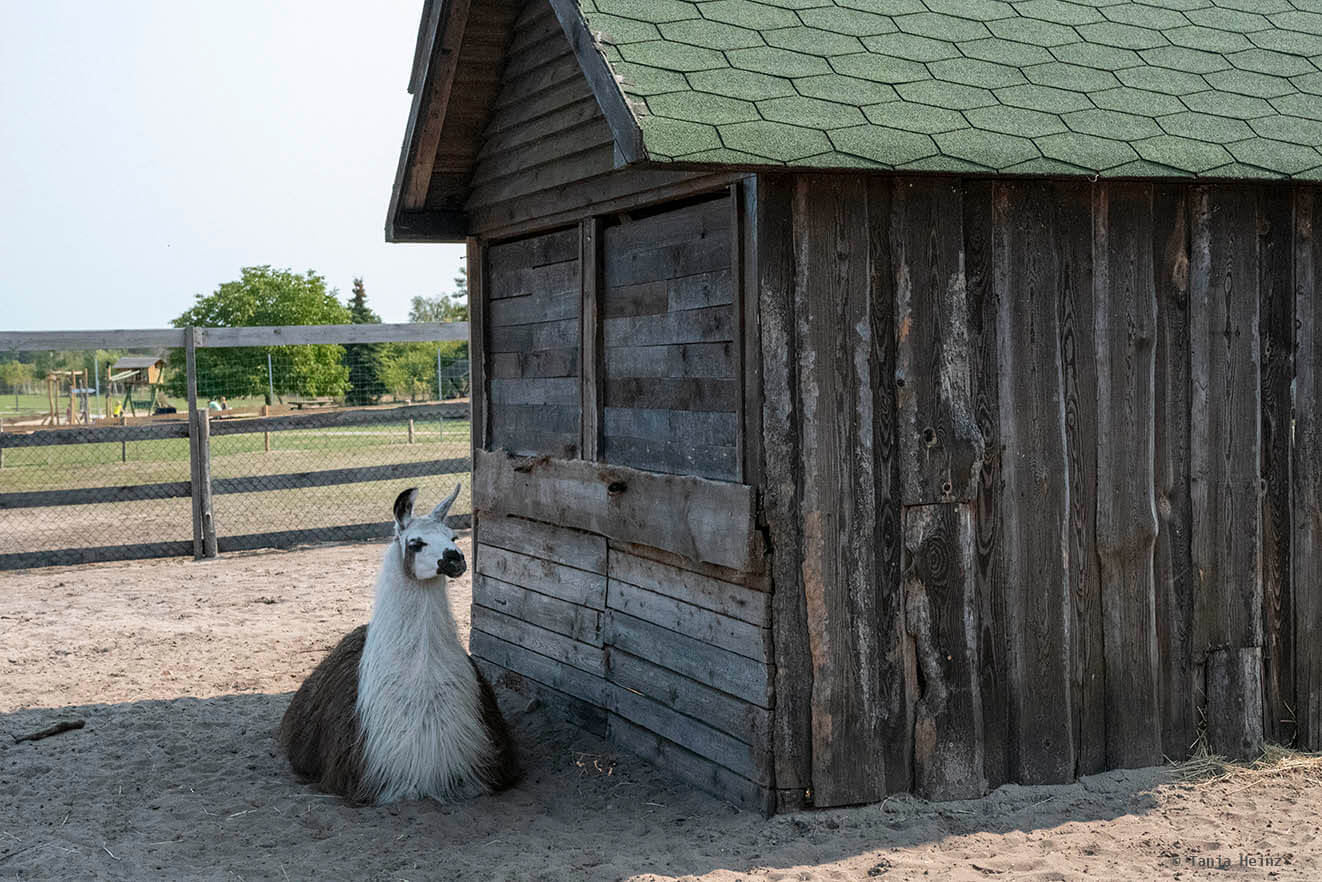
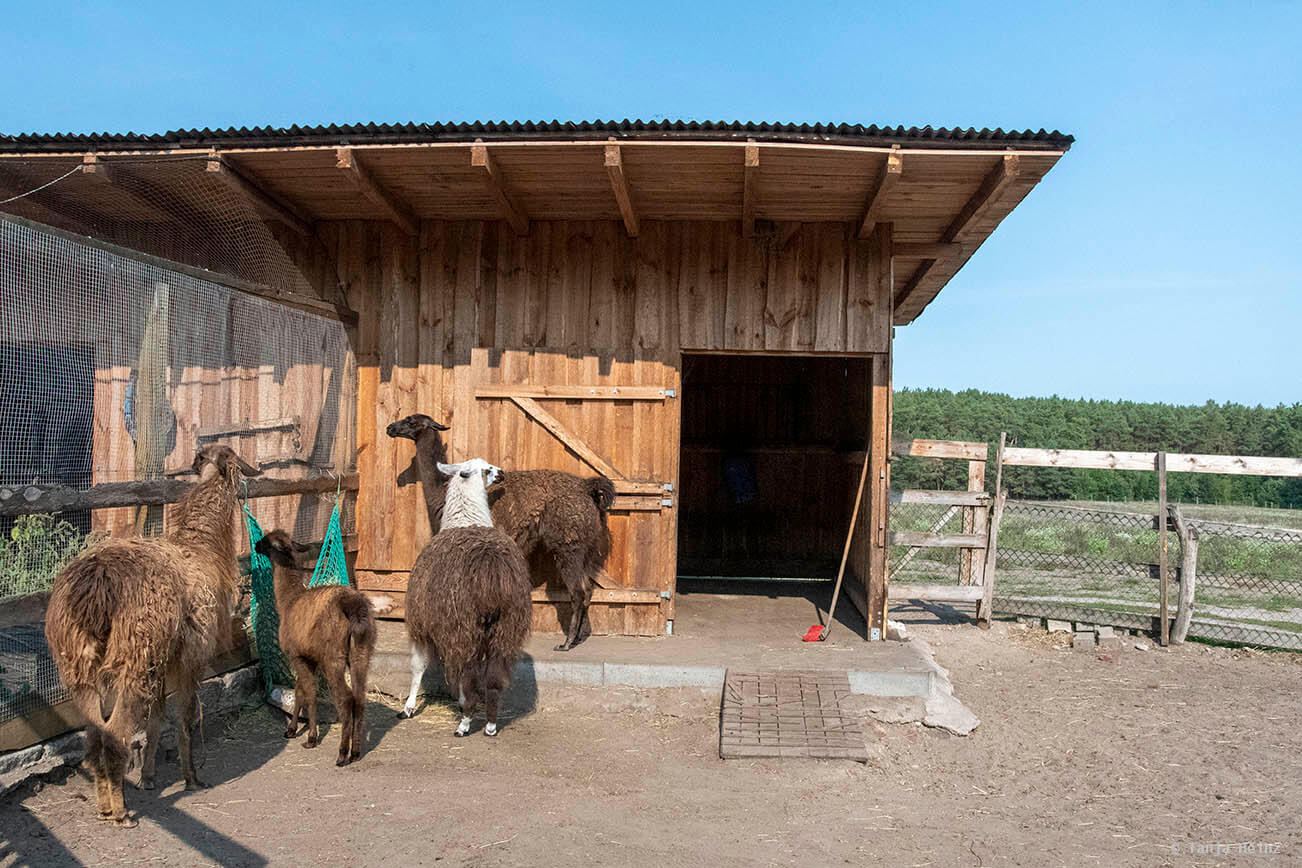
Llamas are often kept as pets - including in Germany - although llamas are originally from the Andes Mountains in South America. For thousand of years the llama have been kept as a domestic or farm animal, respectively, in the Andes. In that region it was (or still is, respectively) especially used as a pack animal, but also as a meat and wool resource.
Interesting: Llamas are actually tame gregarious animals. But during hierarchic encounters, males may start with their bouts of spitting. However, interesting to know, llamas don't spit with saliva but with half-digested stomach content.
Arctic wolf
The Arctic wolf is also known as white or polar wolf and a subspecies of the grey wolf. Normally, they live in the North of Canada and Greenland. The most distinctive feature of the Arctic wolf, which distinguishes the subspecies from other wolf species, is the white, dense and long fur. In this way, Arctic wolves are perfectly adapted to an environment characterized by snow and cold. Furthermore, Arctic wolves have small ears. This is advantageous in a cold environment, as smaller ears don't cool as fast as larger ears.
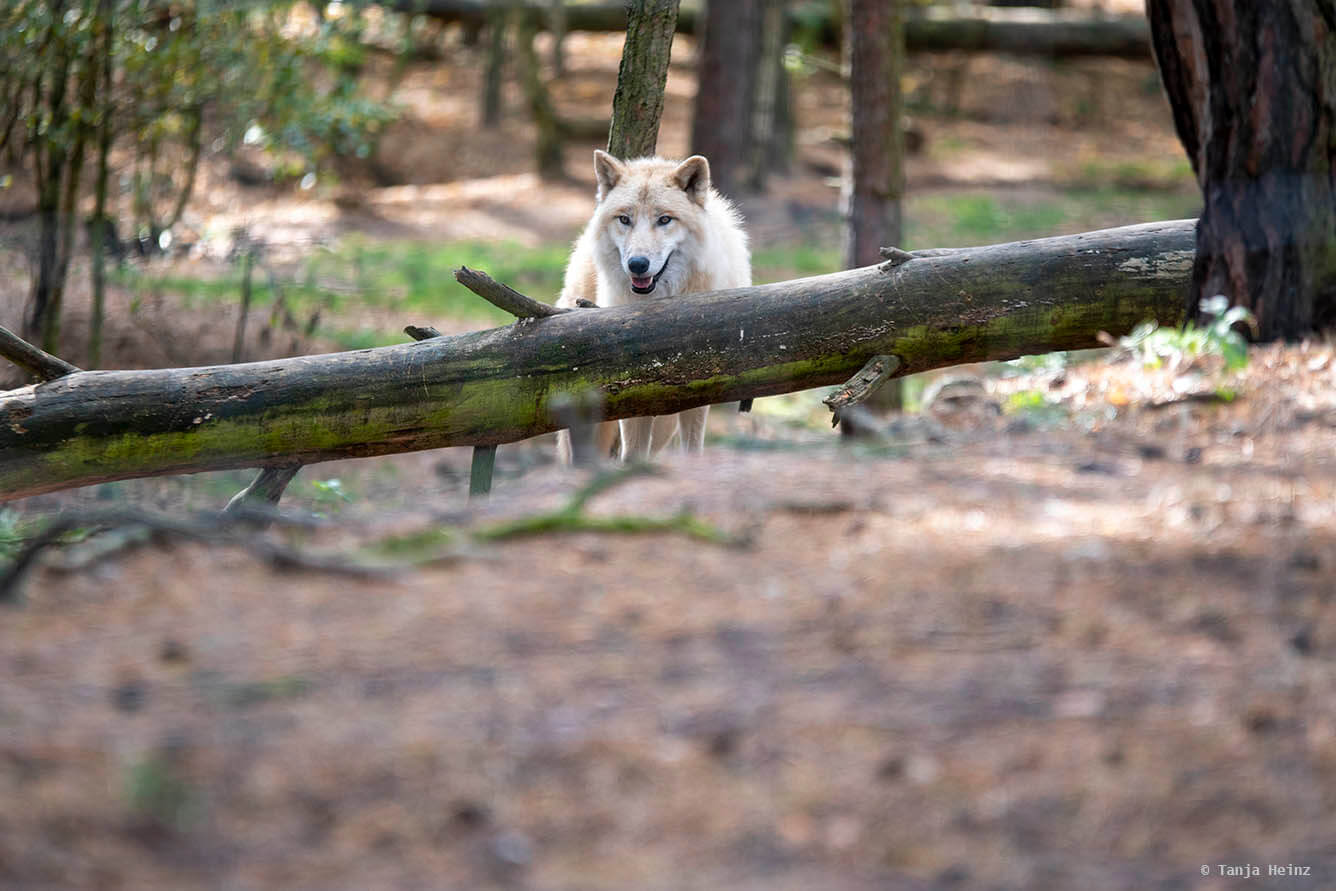
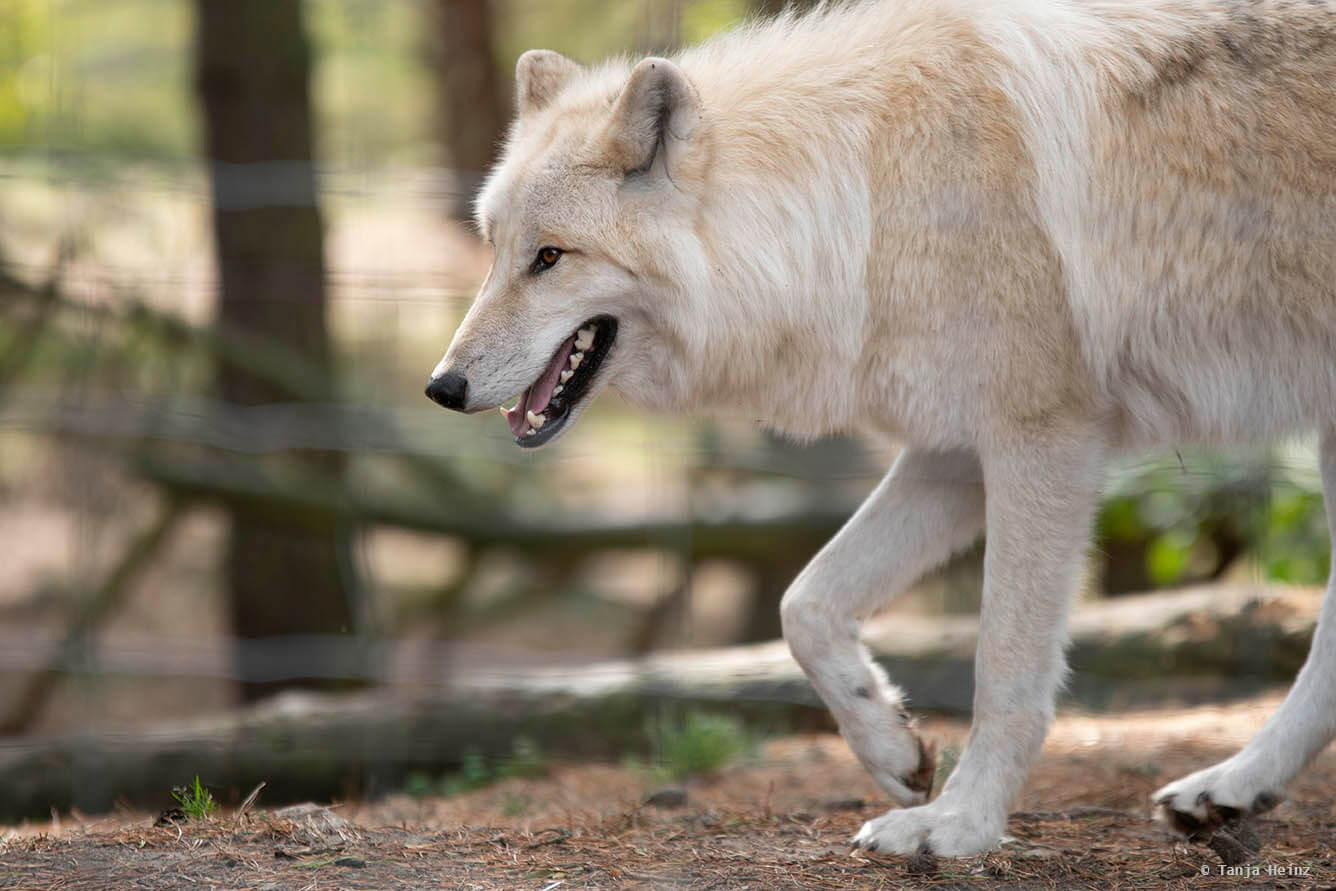
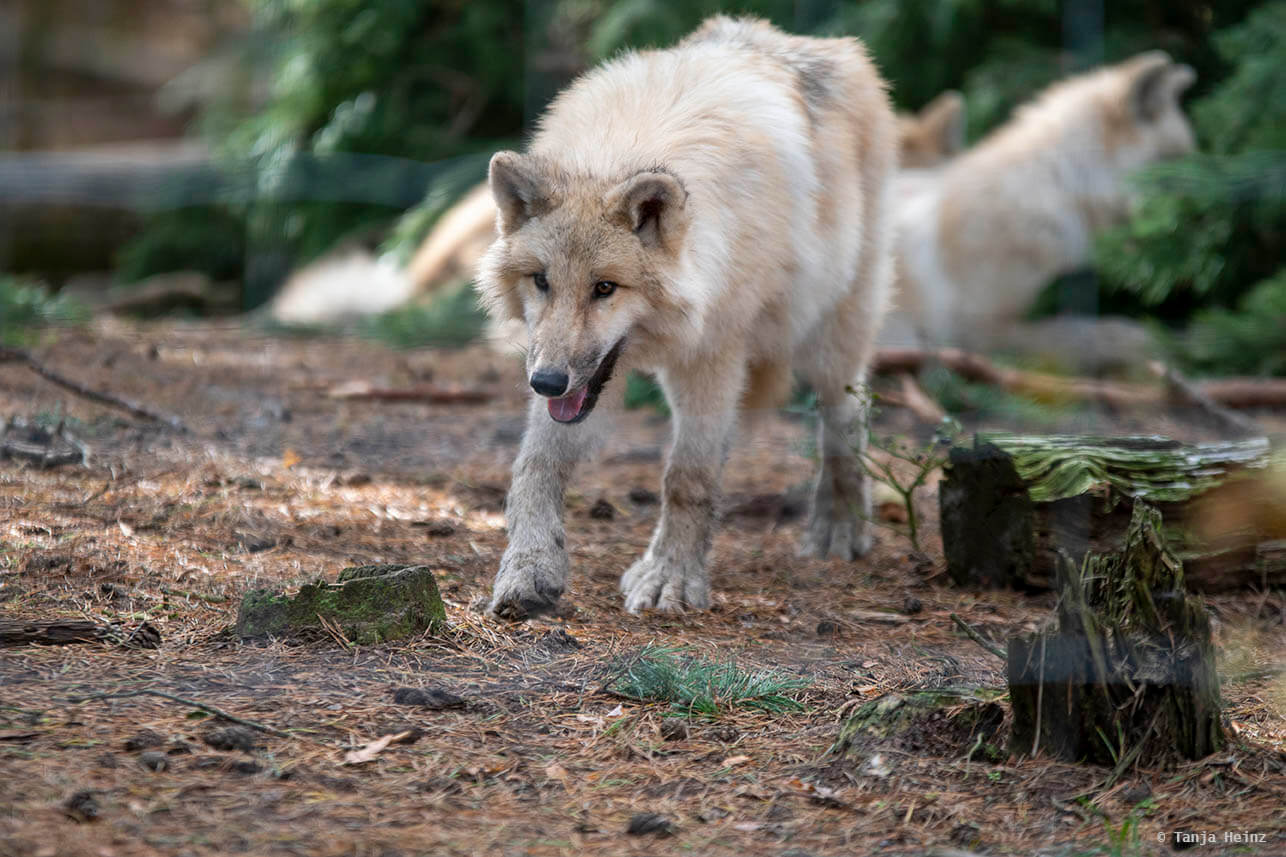
The Arctic wolf is a carnivore and lives in a life-hostile environment. Thus, Arctic wolves have to hunt in a pack in order to find sufficient food. Arctic wolves hunt, for example, caribous.
Interesting: Wolves live in the northern hemisphere. Today there are apparently at least 9 different species of wolves (August 2021). The Arctic wolf is one subspecies. Differences between the wolf subspecies refer to their size and fur color.
Brown bear
The brown bear enclosure in the wildlife park Johannismühle was established to help circus bears in need. The enclosure is similar to the one I encountered in the bear sanctuary Müritz. With a size of about 6 hectares, the brown bear enclosure in the wildlife park even encompasses ponds, caves to hide (or for winter rest) and climbing possibilities.
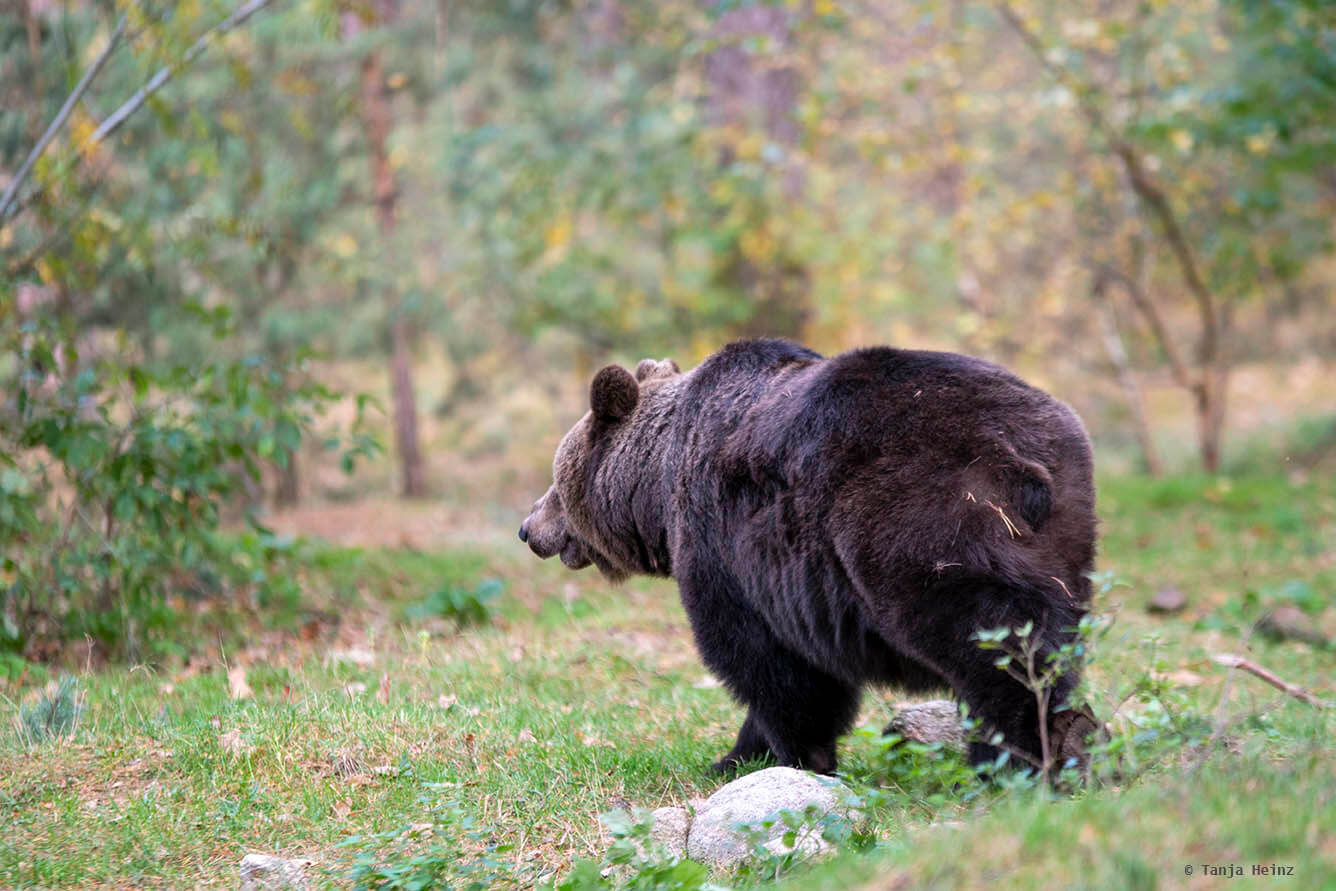
Apropos caves. Brown bears typically dig caves for their winter rest. The bears in the wildlife park Johannismühle as well might undergo winter rest.
During winter rest brown bears sleep and simultaneously lower their heart and respiratory rate in order to save energy. However, brown bears normally don't sleep through the whole winter. In contrast to other animals which hibernate (see marmots at the Königsbachalm or at the Kemptner Hütte), brown bears are able to wake up fast in order, for example, to defend themselves.
However, in the wildlife park Johannismühle brown bears don't have to defend themselves. During winter they wake up now and again in order to take some of the food provided in the enclosure.
Interesting: Brown bears are omnivores. Compared to Arctic wolves, brown bears feed on plants and animals. But still, brown bears are carnivores and are closely related to dogs, seals (like harbor seals, grey seals, sea lions or fur seals), martens and coatis. One of its closest relative is, however, the polar bear.
Konik horse
The Konik horse is a domestic horse breed from Poland. As Konik horses possess only one hoof like all the other horses, they are odd-toed ungulates.
Konik horses are descendants of European wild horses - the tarpans. However, the tarpans are extinct since the 19th century.
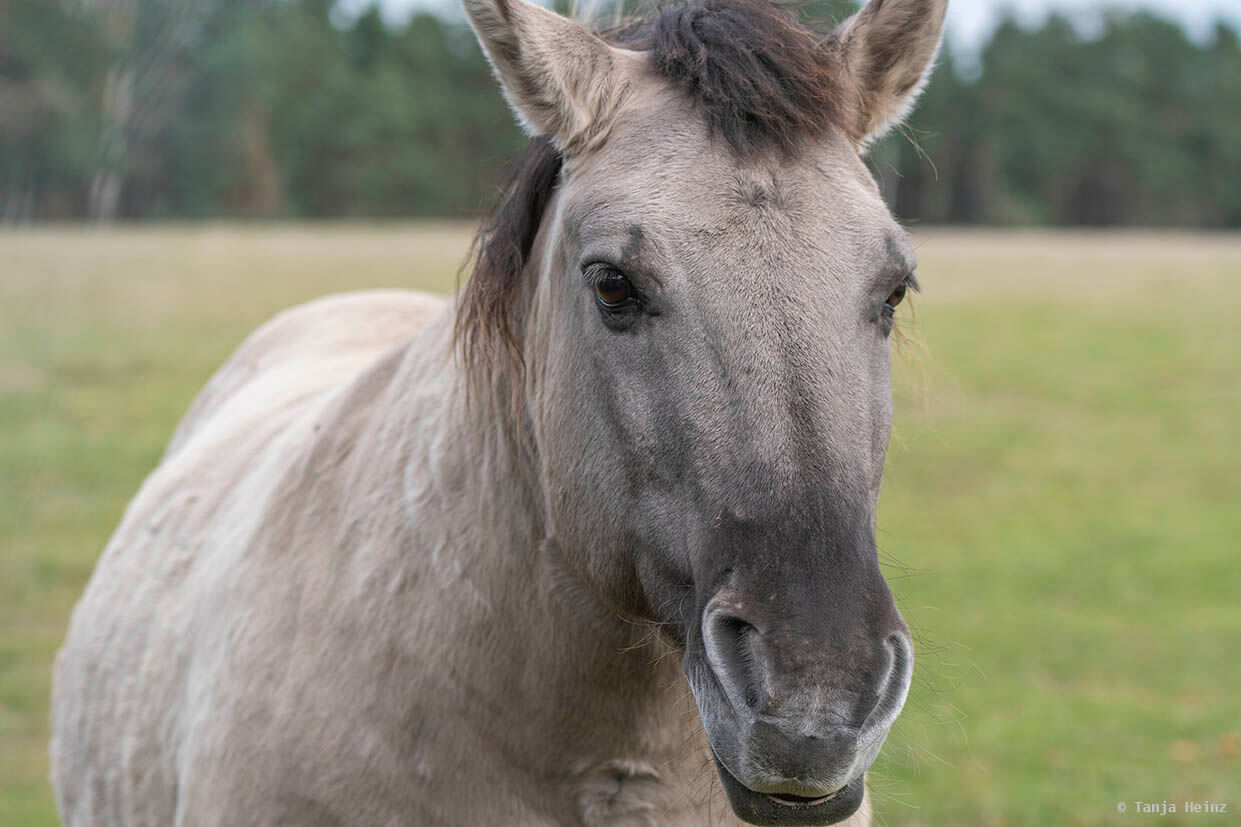
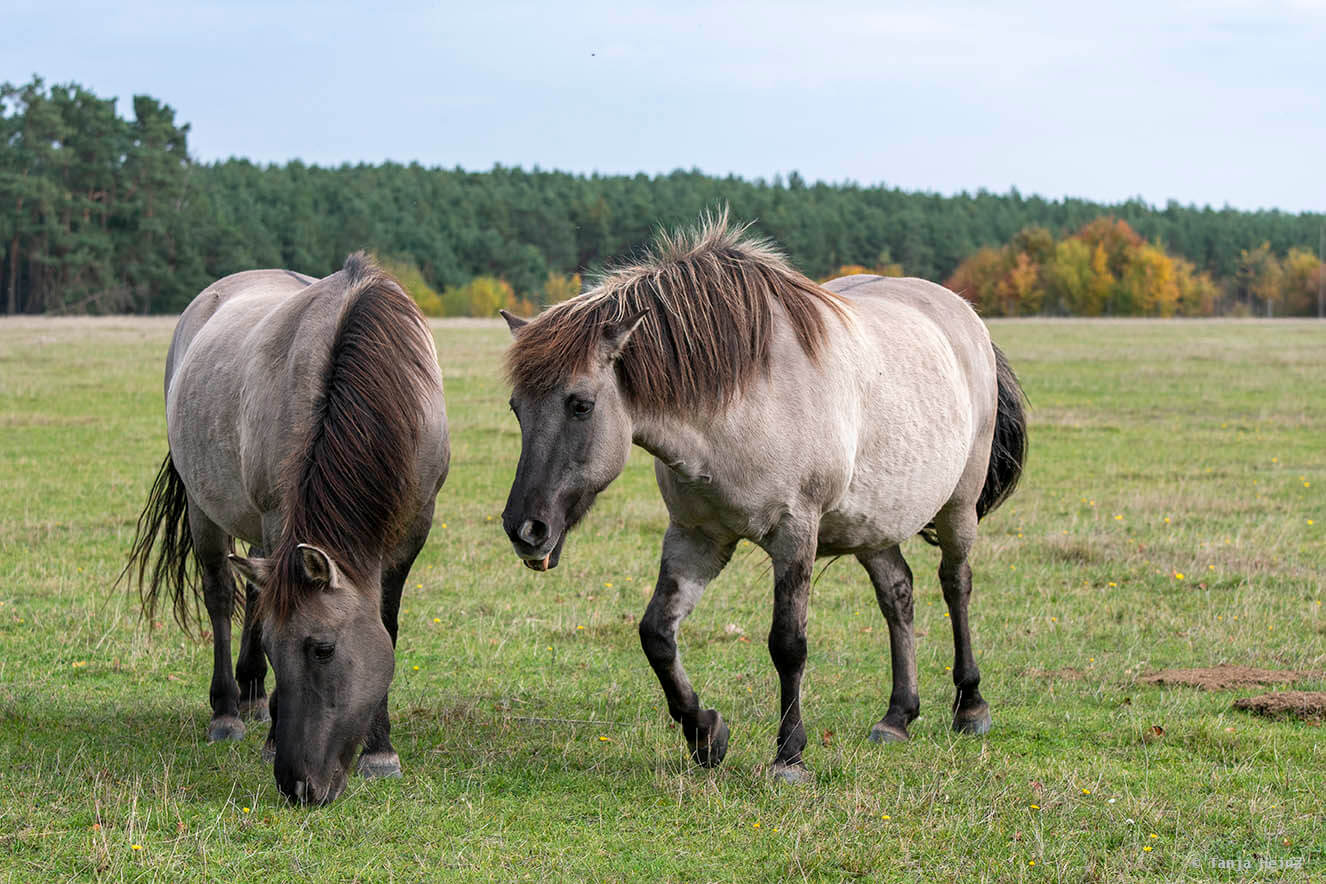
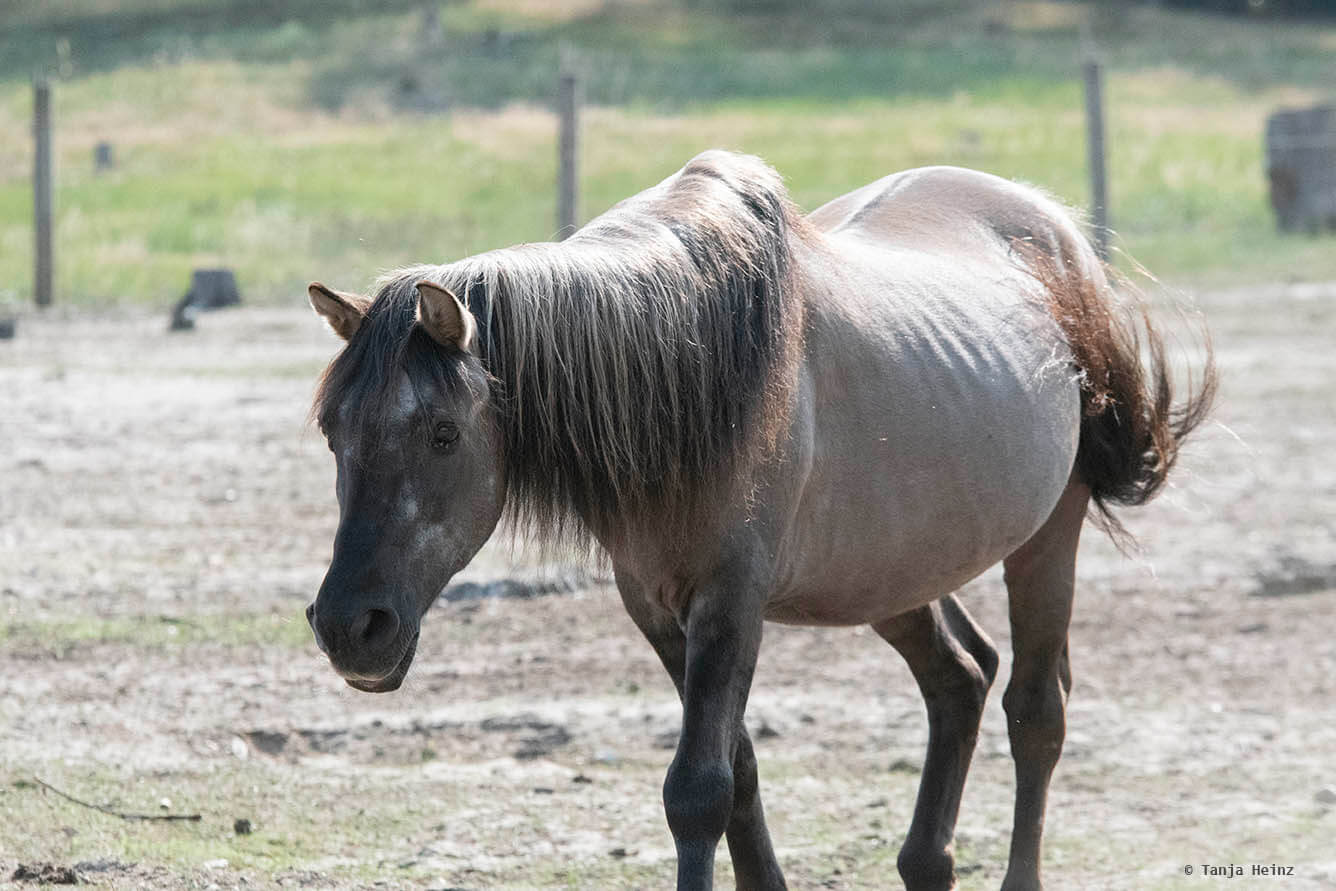
The first Konik horses were bred at the beginning of the 19th century in Poland by hybridizing wild horses with domestic horses. However, it is not exactly known if the wild horses were indeed wild horses (like the tarpans). The Konik horse might also be a feral domestic horse.
Interesting: Horses like the Konik horses are gregarious animals that live in groups of 3 or up to 35 individuals. There is a strict hierarchy within the group. Young mares typically remain in the group of their mothers, while males migrate at some time in their lives into new groups.
Heck cattle
Heck cattle resemble aurochs. However, aurochs are already extinct. The last aurochs died in 1627. Aurochs became extinct, as the species lost large parts of its habitat due to human settlements.
Heck cattle resemble the extinct aurochs, because the Heck brothers bred these animals with domestic cattle in the 20s. This selective breeding of domestic animals is also known as breeding back.
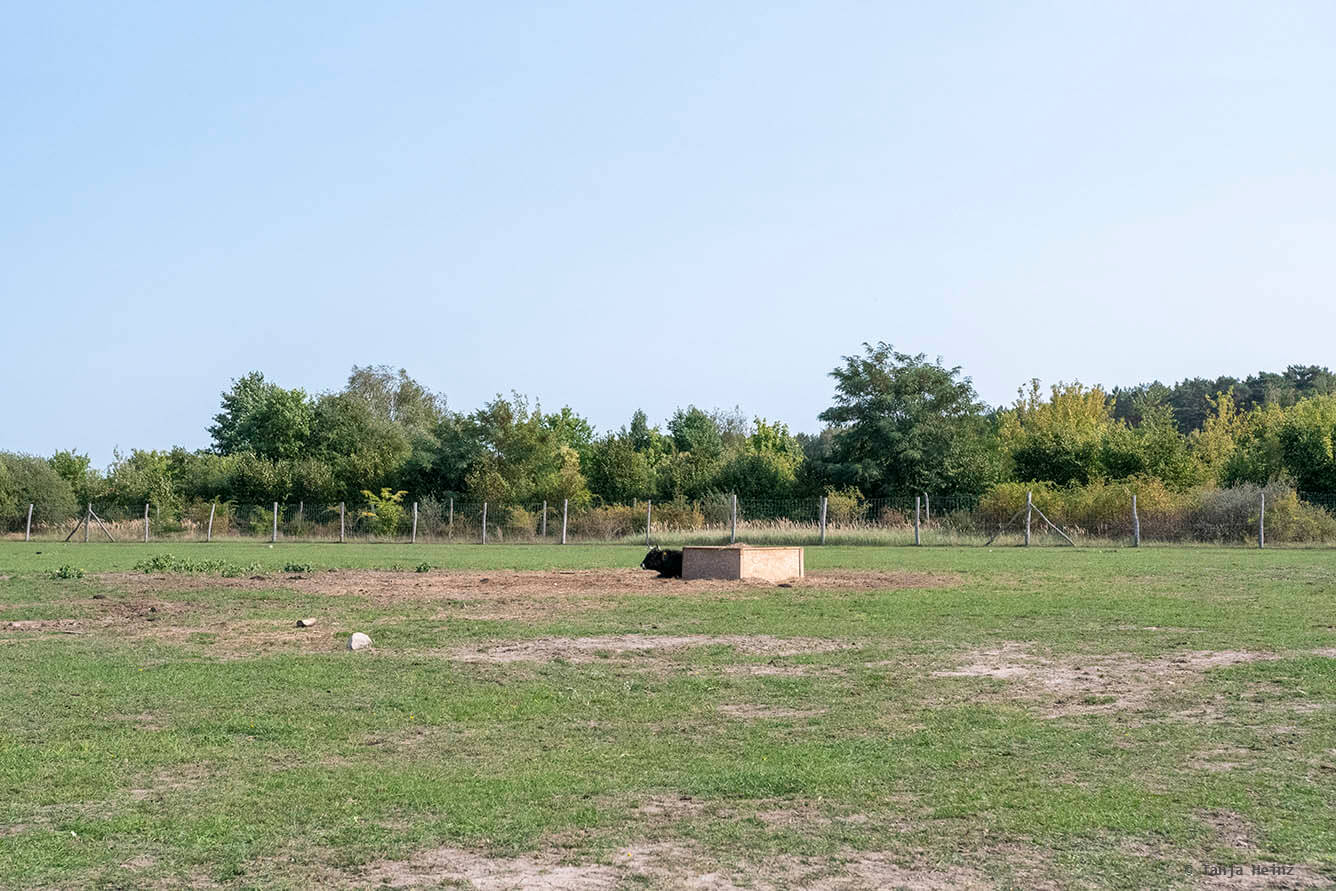
More animals in the wildlife park Johannismühle
On a visit in a wildlife park - but as well in a zoo - you need time and patience. Sometimes animals show up. Sometimes not. For example, on my two visits of the wildlife park Johannismühle I couldn't get a glimpse of a lynx.
I also have to mention that I couldn't see a wild boar in the wildlife park Johannismühle on my second visit. I only saw them on my first visit.
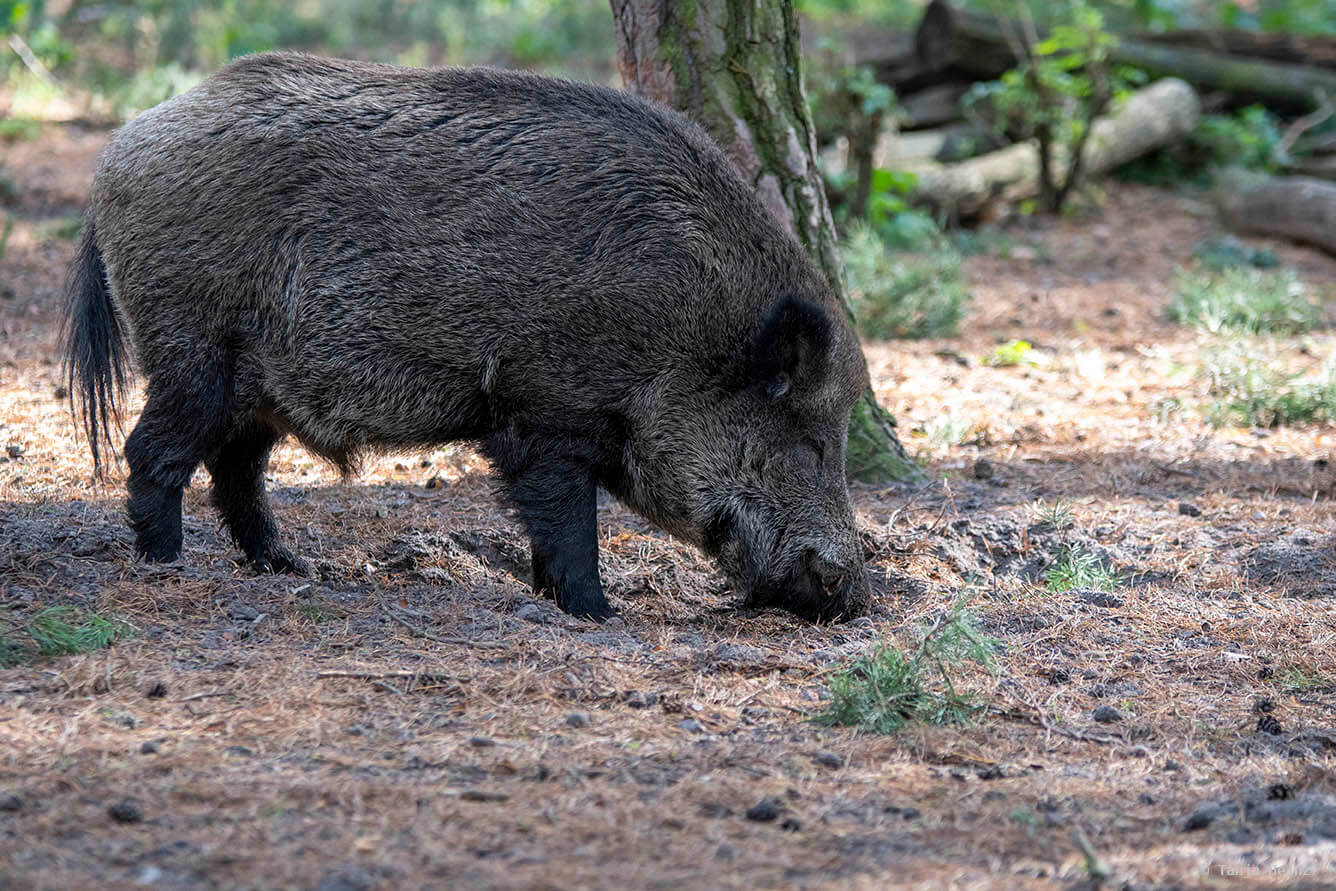
An animal attendant of the wildlife park told me that they were suggested to take the wild boar to another and safer place. The African swine fever was around.
I hope they are now safe from the African swine fever!
In the same enclosure where I was talking to the animal attendant were some donkeys.
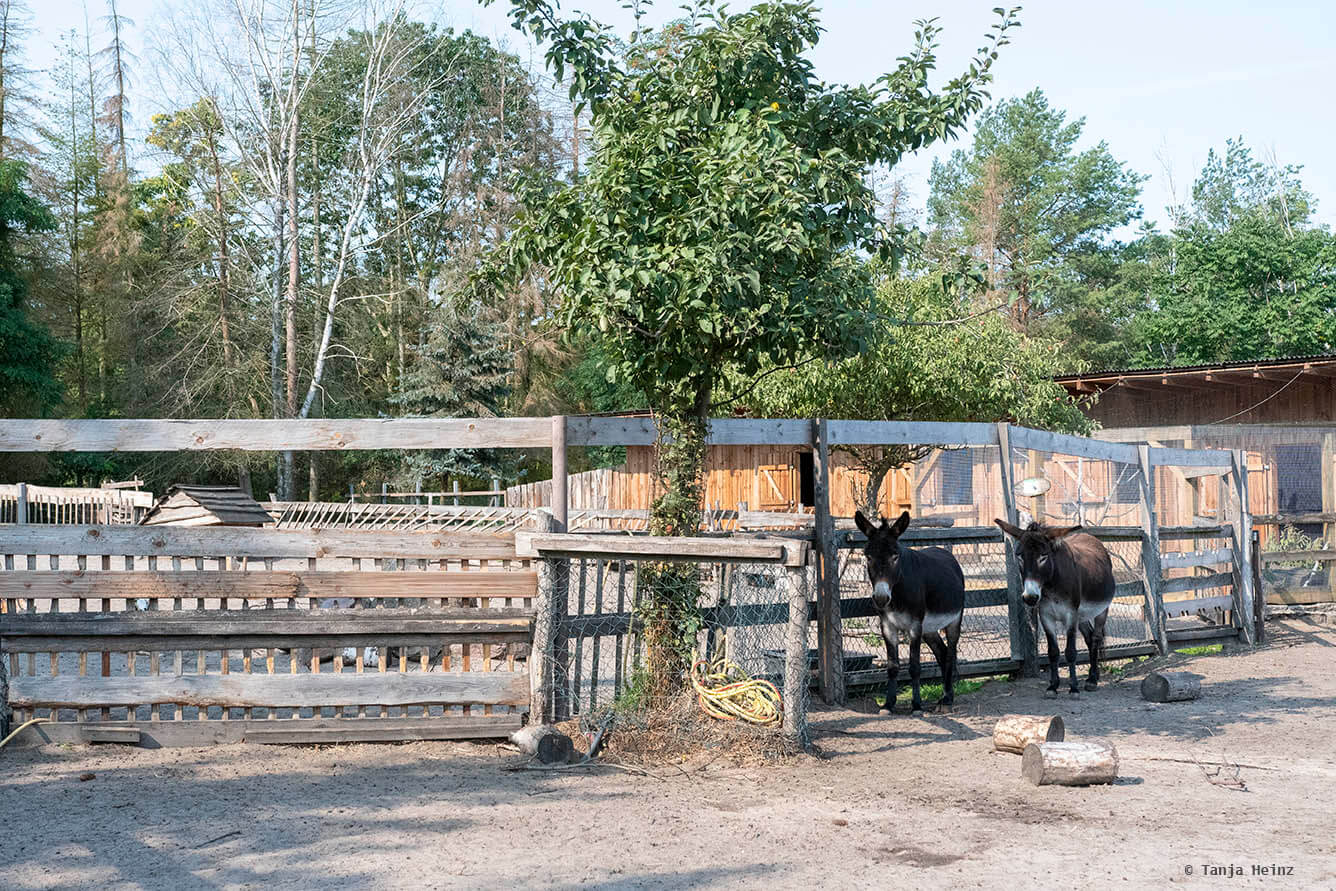
Those two donkeys came from private keeping. Unfortunately, the donkey owner had to give the two animals to another place after an accident. In my opinion, these two donkeys have found a good place in the wildlife park Johannismühle.
While I was observing the donkeys, the animal attendant kept working and simultaneously talking enthusiastically about the animals in the wildlife park Johannismühle. She even showed me two breeding guinea fowls.
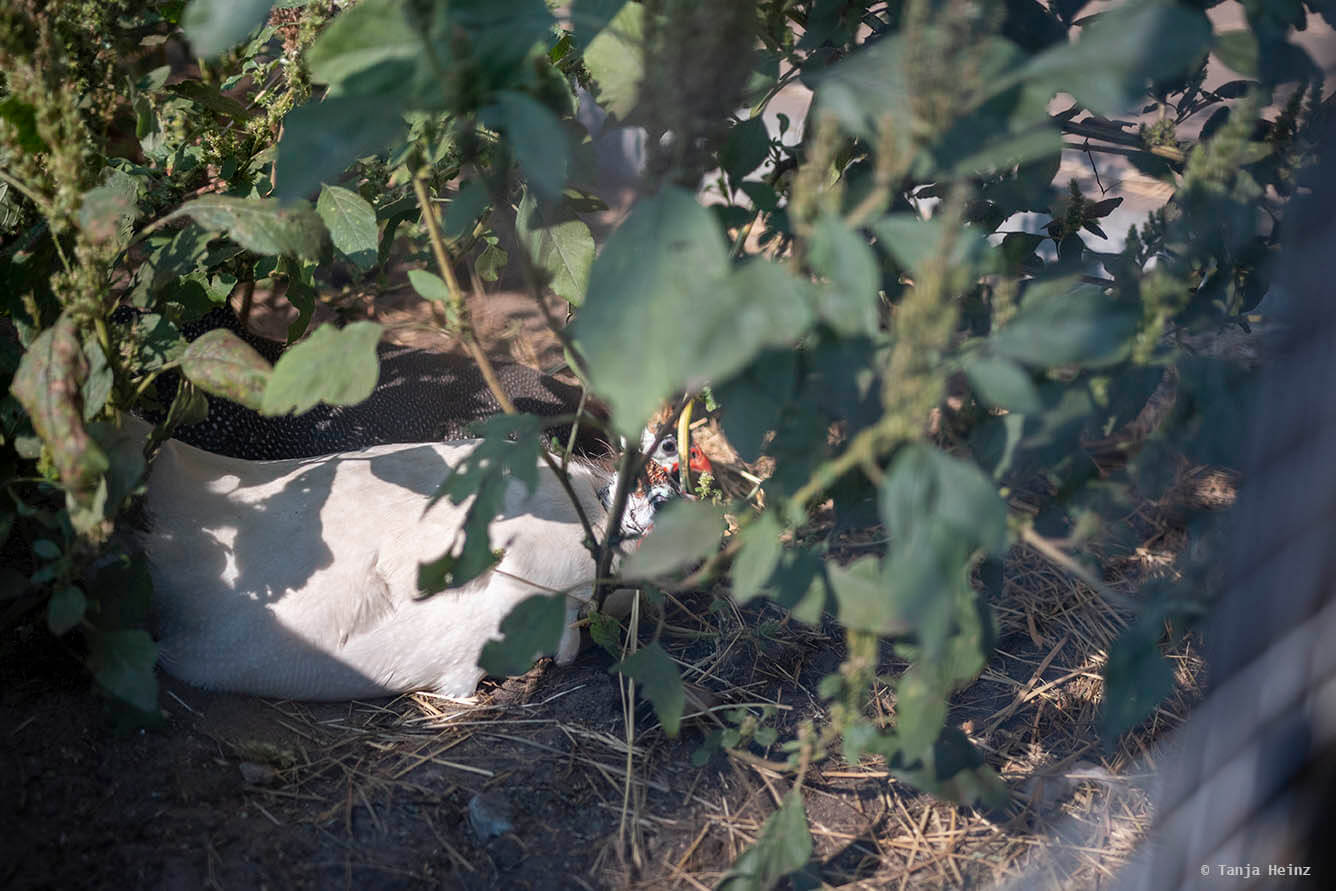
In the same enclosure were the llamas. Visitors are actually not allowed to enter. However, as the animal attendant was so keen to show me the animals and tell me more and more about the wildlife park, I could enter in that enclosure. In contrast, the neighboring enclosure with the goats and sheep (including, for example, a Carinthian sheep) are accessible for all visitors without any animal attendant.
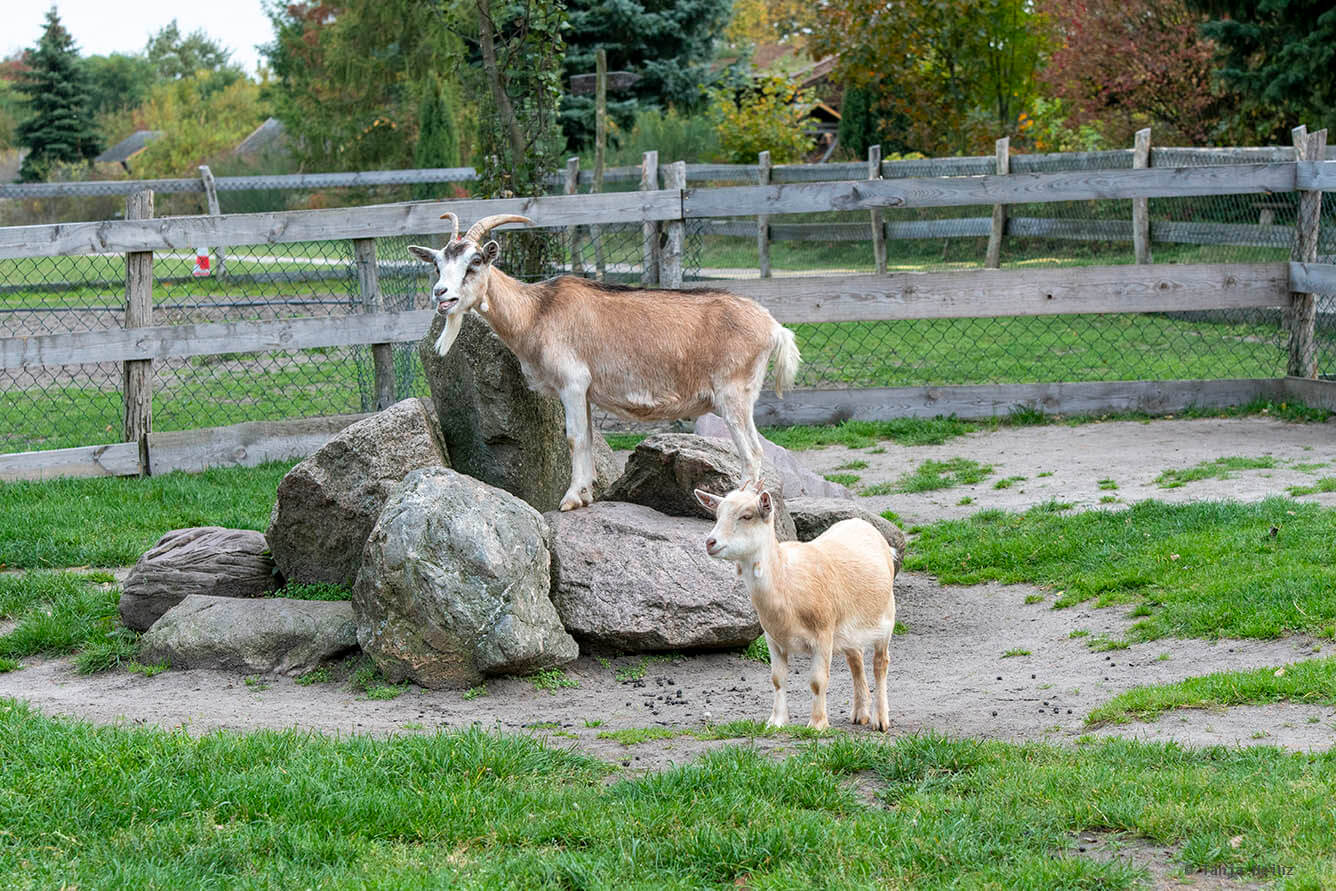
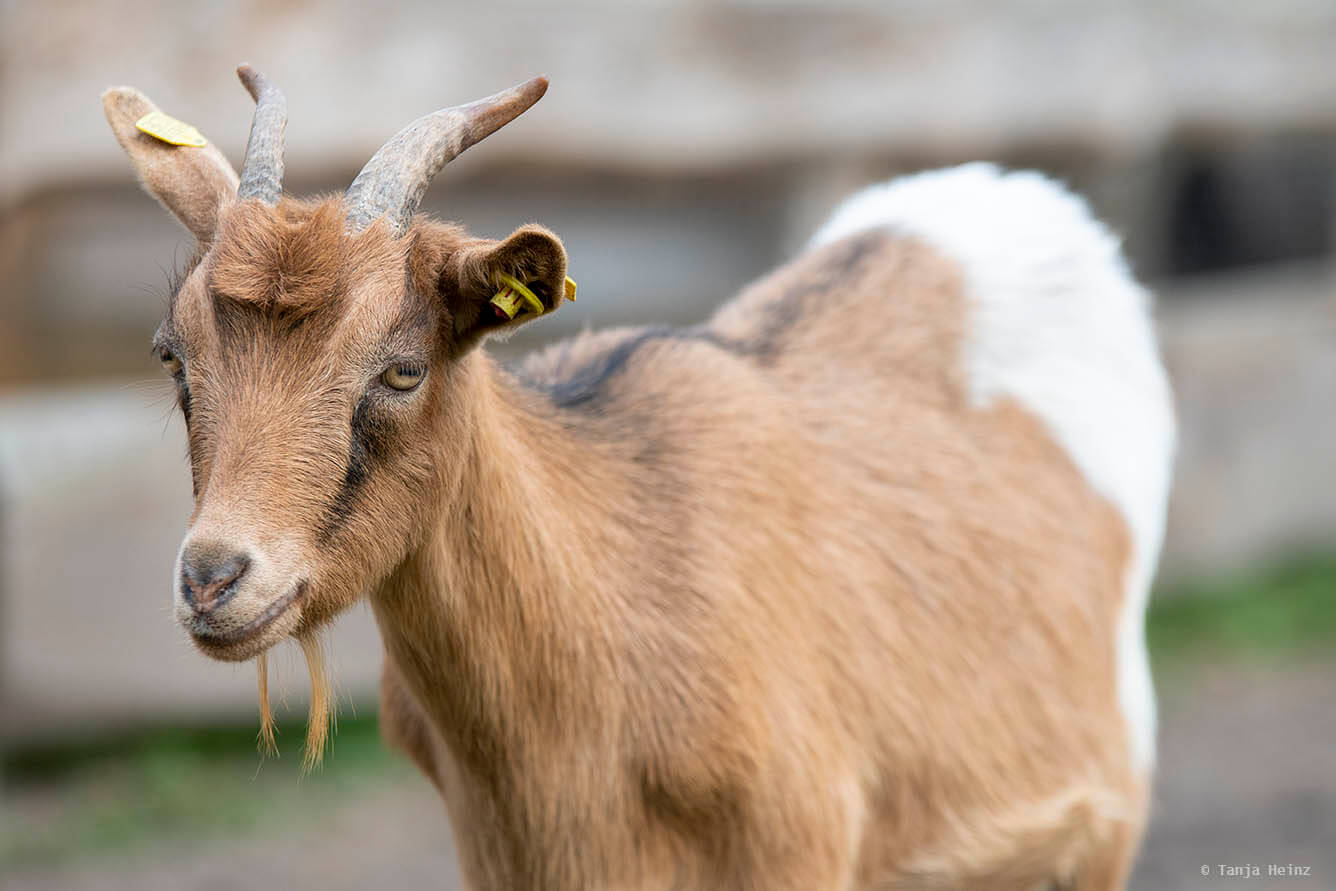
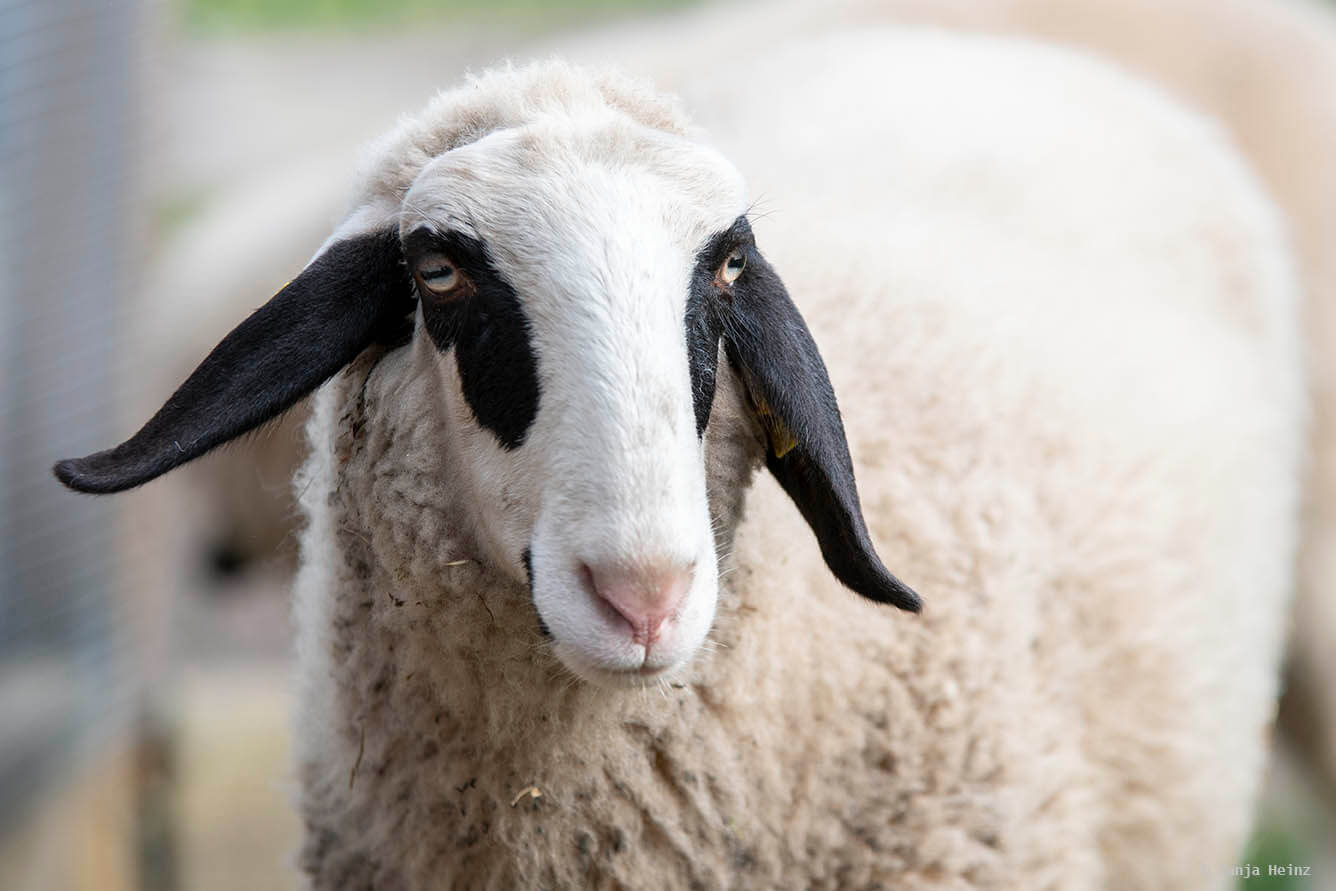
I also very liked the enclosure with the rabbits. In that enclosure the rabbits can hide, dig, feed and sleep. And they are protected from their predators. At least the animal attendant told me that, because in that year no fox had come to take a rabbit.
However, if there is a fox close-by at times, the rabbits become shyer, frighten very easily and flee into their hiding places after every small disturbance.
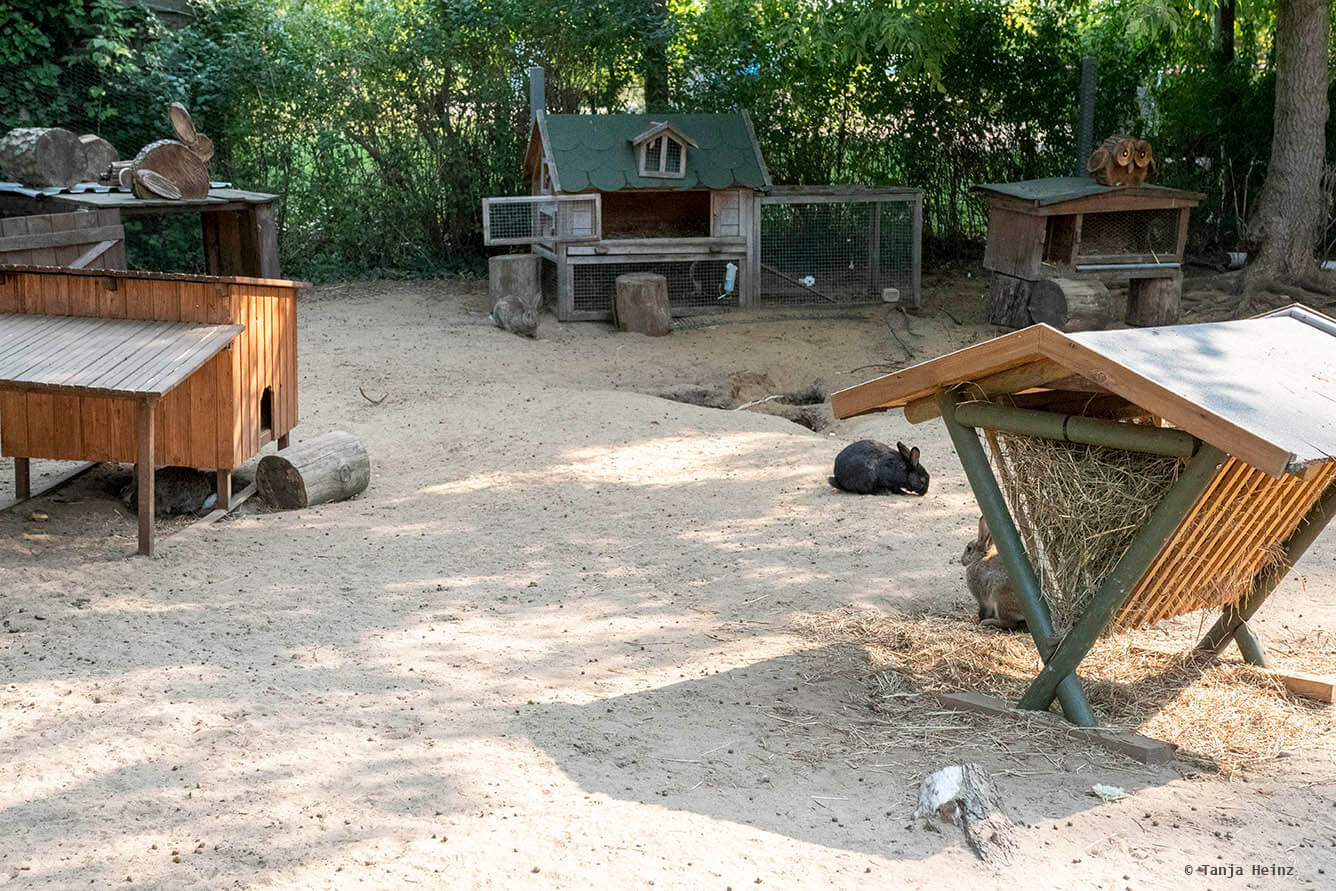
Information: The pet's corner is close to the entrance area and especially popular among children. While there is access to the goats, visitors are not allowed to enter the enclosure with the donkeys and the llamas. I only could enter the enclosure as an animal attendant of the wildlife park had such a joy to show me around.
Falconry
For not such a long time there is a falconry with regular shows in the wildlife park Johannismühle. As eagles and hawks are fascinating birds, I went to one of the shows at the falconry.
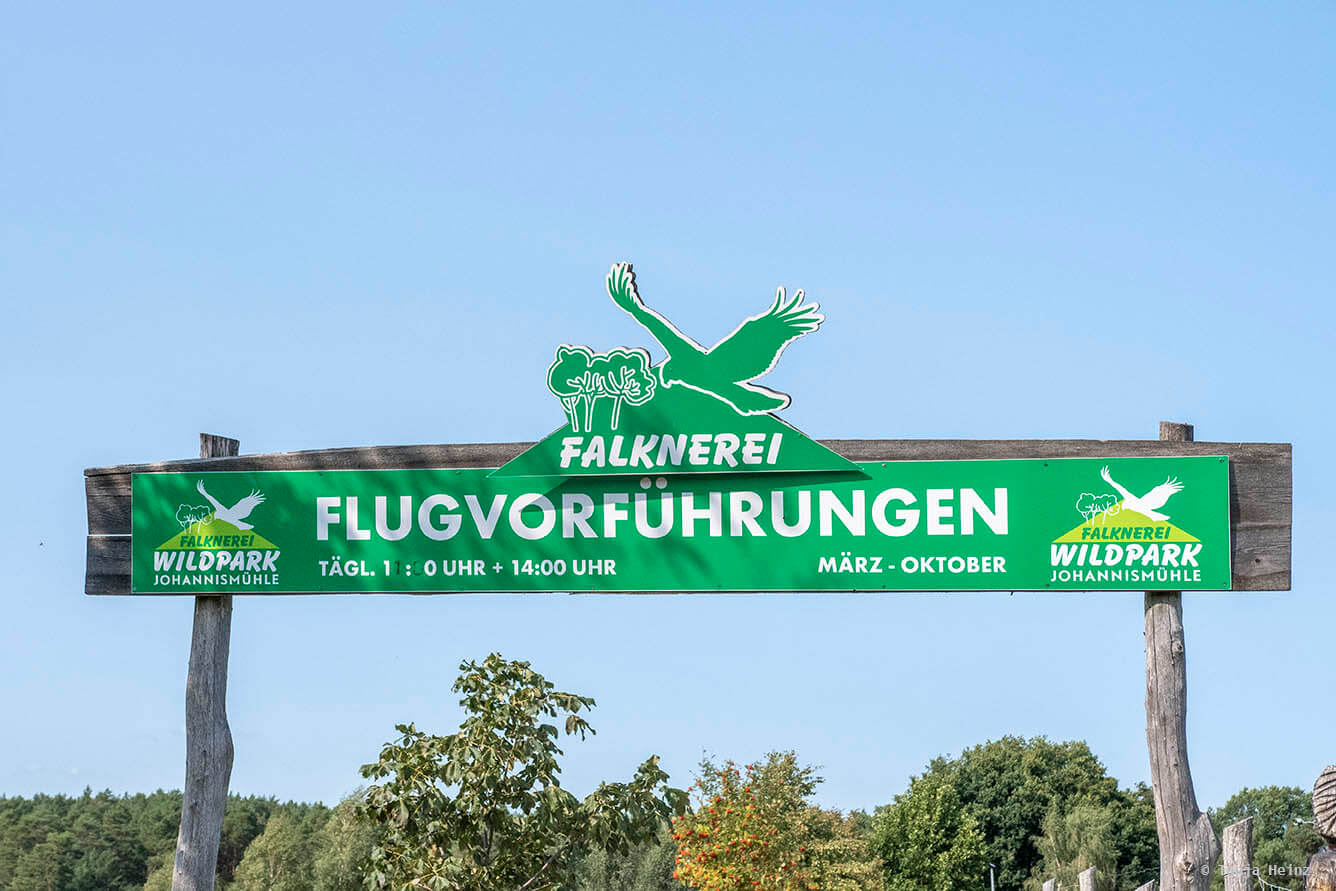
Information: The shows take place from March to October daily from 11 a.m. to 2 p.m. Due to the coronavirus pandemic there were some changes in the timetable. Thus, I suggest to check the official website of the wildlife park Johannismühle to get up to date information about the timetable.
According to the information signs at the falconry there are different species of hawks and eagles in the wildlife park. I was looking forward to see the birds.
The first bird I saw was a Siberian eagle-owl.

The Siberian eagle-owl is a subspecies of the Eurasian eagle-owl and - as the name already suggests - distributed in Siberia. Siberian eagle-owls are the largest owls in the world and exceed even the impressive Eurasian eagle-owls in size.
After the Siberian eagle-owl we saw a Harris' hawk (on the left) and a gyr falcon (on the right).
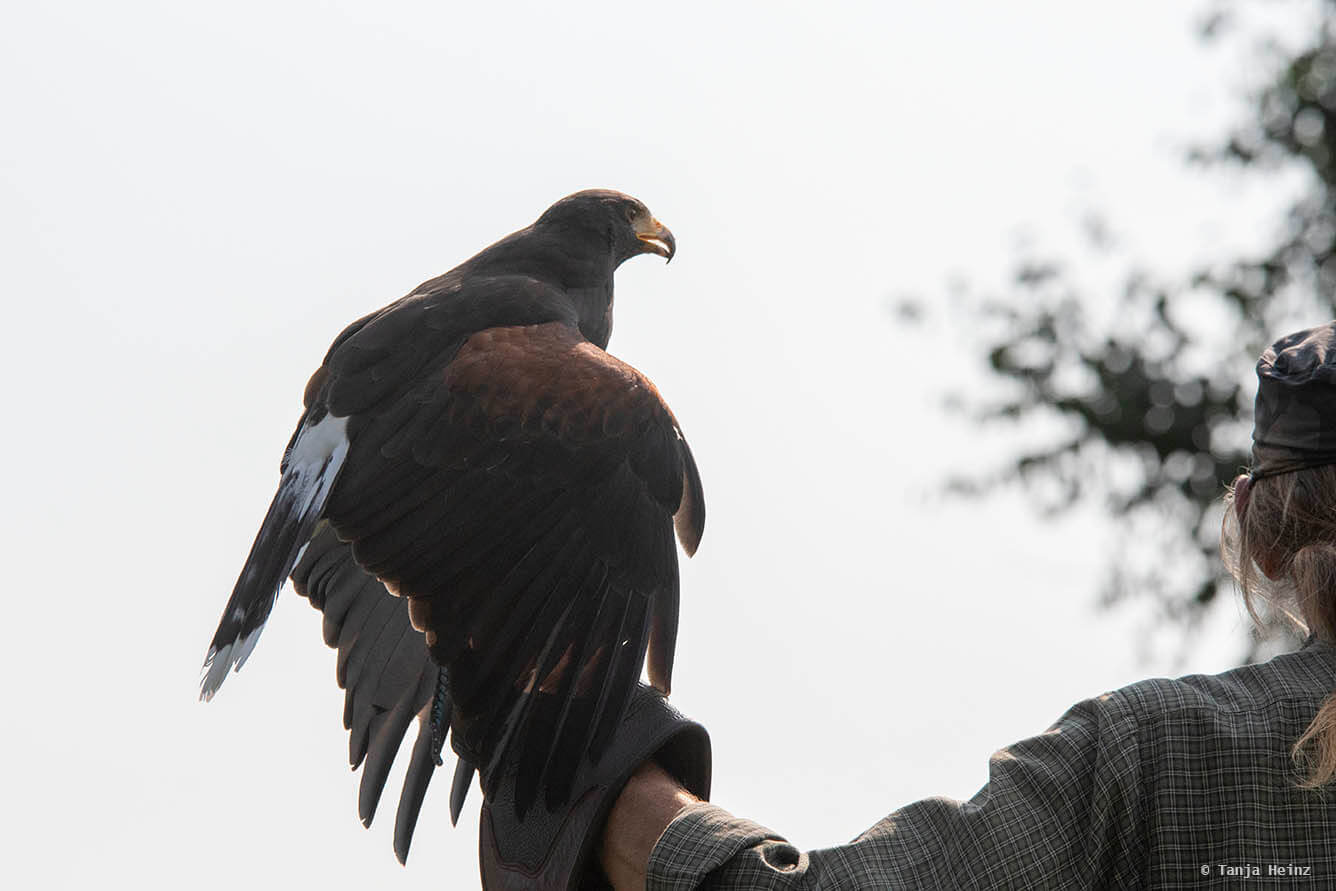
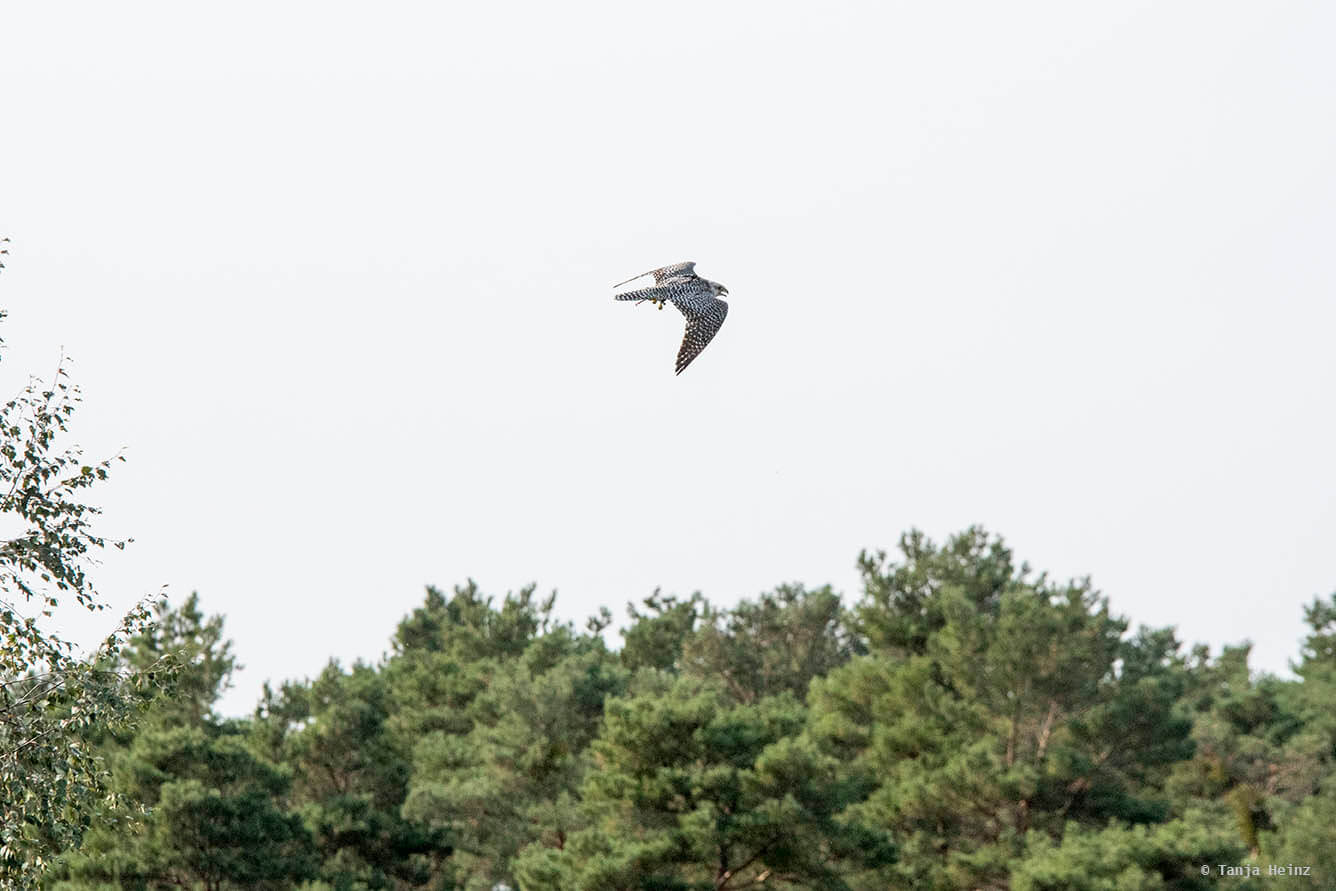
Unlike other eagles and the hawks, the Harris' hawk lives in family groups led by a dominant female. Harris' hawks actually live in North and South America where they inhabit deserts, semi-deserts and/or grass steppes.
Among falcons, the gyr falcon is the worldwide largest falcon. A gyr falcon almost reaches the size of a common buzzard. Its geographic range extends from the north of Europe to Asia and they even occur in North America.
Although I was very impressed by these birds, I have to admit that I went to the falconry with an ambivalent feeling. To present such a show, the falconers had to bring the birds to heel and break their will... Is that animal welfare?
Tip: The shows in the falconry were quite popular among visitors. Thus, I recommend to go to the falconry on time to get a good seat. There are many seats, but on a warm and sunny day most visitors look for a rather shady seat.
Practical information
How to get to the wildlife park Johannismühle
The wildlife park Johannismühle can be easily reached by public transportation from Berlin. At first, I took the tram M10 to the main train station. At the main station I took the train RE5 to Klasdorf-Glashütte. At the train station Klasdorf-Glashütte you get to the wildlife park in just a few minutes by walking. The train from the main station in the center of Berlin to the train station in Klasdorf-Glashütte took about 1 hour and 15 minutes.
I paid 14,60 euros for a return ticket.
Entrance fee and opening hours
An entrance ticket of the wildlife park Johannismühle cost 10,50 euros in the main season. In the low season just 9,50 euros.
The ticket window opens from March to October from 10 a.m. to 4 p.m. and from November to February from 10 a.m. to 3 p.m. The wildlife park Johannismühle closes two hours later at 6 p.m. or 5 p.m., respectively.
On Mondays the wildlife park Johannismühle is closed.
I recommend to go to the official website of the wildlife park to get the most recent information.
More links
Radio program on Deutschlandfunk Nova
Official website of the wildlife park Johannismühl
The animal park Kunsterspring in Neuruppin
The wildlife park Schorfheide near Groß Schönebeck
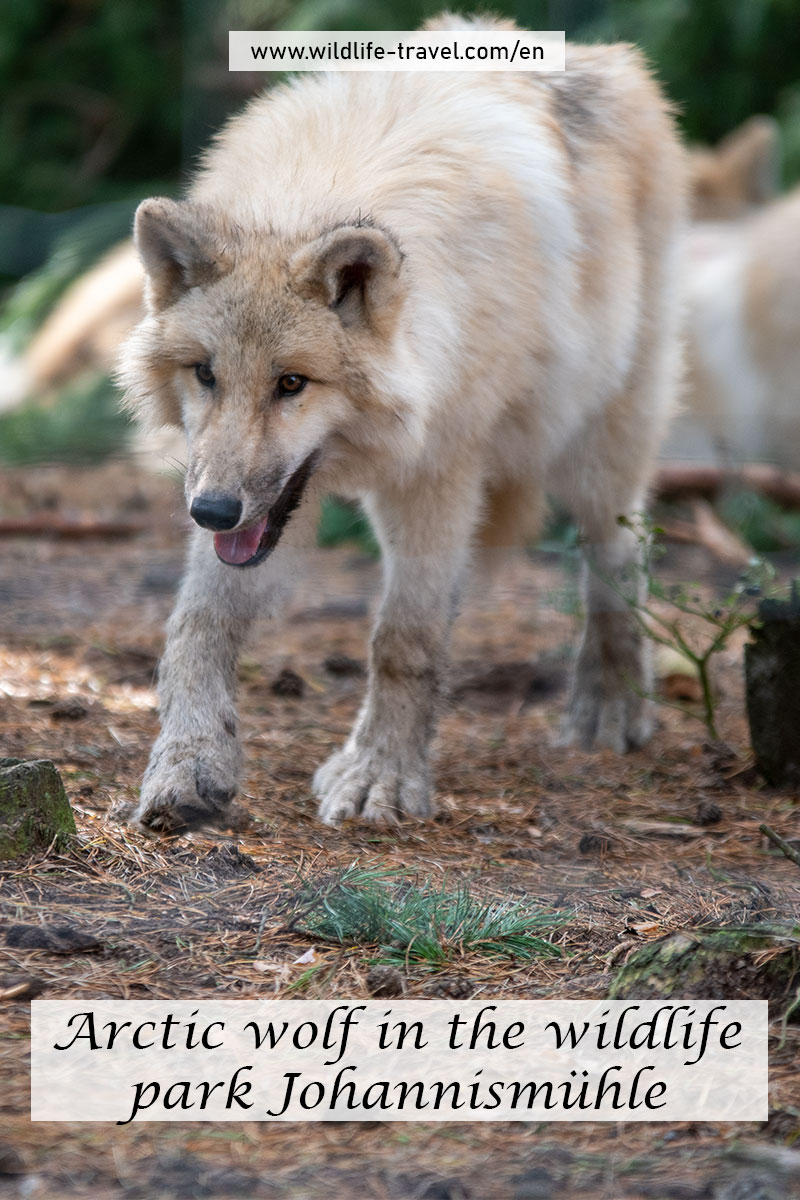
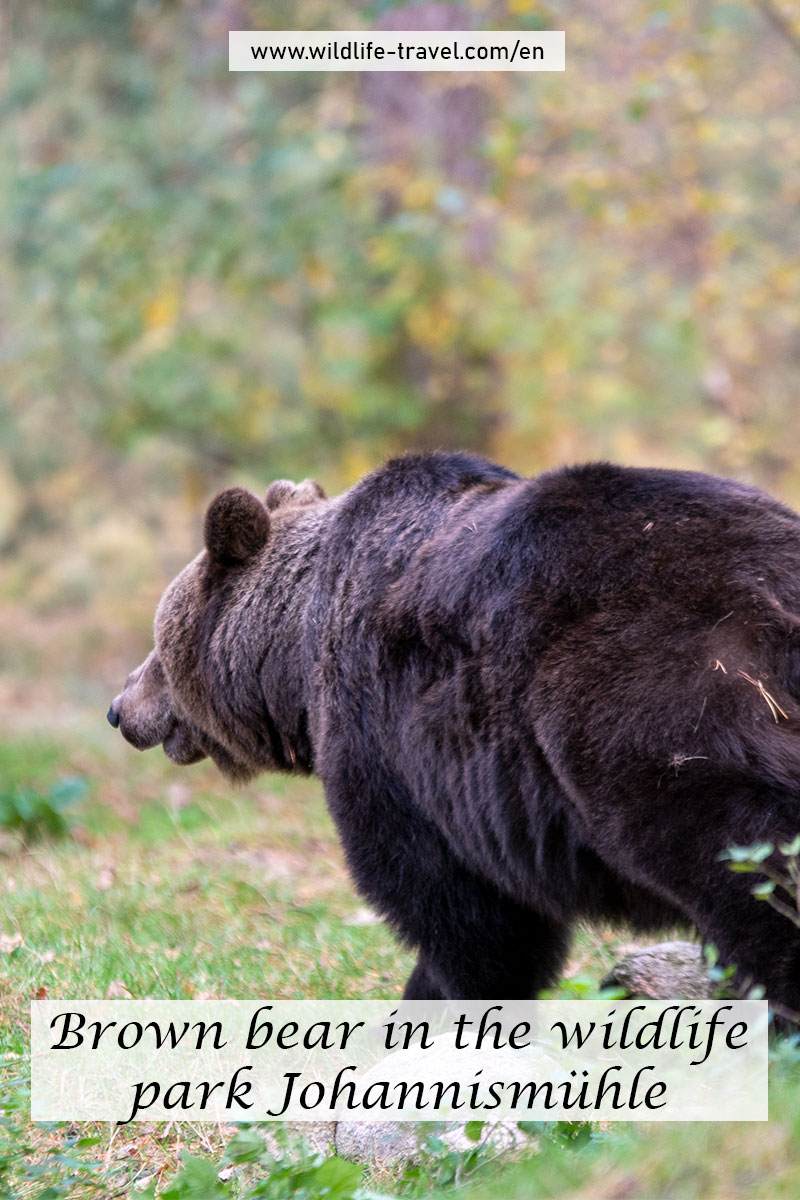
Do you know the wildlife park Johannismühle? If yes, did you like the park? Or is there another wildlife park you can recommend?

Hey there,
I am looking to create an amazing day for my partner on their birthday leading up to a proposal (which will be elsewhere). My partner absolutely loves wolves and I know it’s really uncommon to be able to get a chance to meet them. I checked your website for any sign of an experience to get closer to the wolves and as expected I didn’t find anything but I just thought just in case would you have any options for us?
We are both in our 20s and very respectful individuals.
If not I totally understand I just thought I’d check.
Thanks,
Max (I’m female btw haha)
Hey Max! Thank you very much for your comment 🙂
As I was just a normal visitor, I couldn’t enter any enclosure. Maybe you want to directly contact the wildlife park if they offer an encounter with a wolf? According to their website they feed the grey wolves at the moment every day at 12:15 p.m. and visitors can watch. Maybe this sounds interesting for you? They also have an apartment to stay overnight, however, I haven’t done that before and I cannot tell more about that if it is a good experience or not.
Please check this site, as it might be possible that you can visit the wolves: https://www.wildpark-johannismuehle.de/besuch-planen/#fuhrungen
Their e-mail is: info@wildpark-johannismuehle.de
I hope this information helps!
Have a good day!
Best wishes, 🙂
Tanja